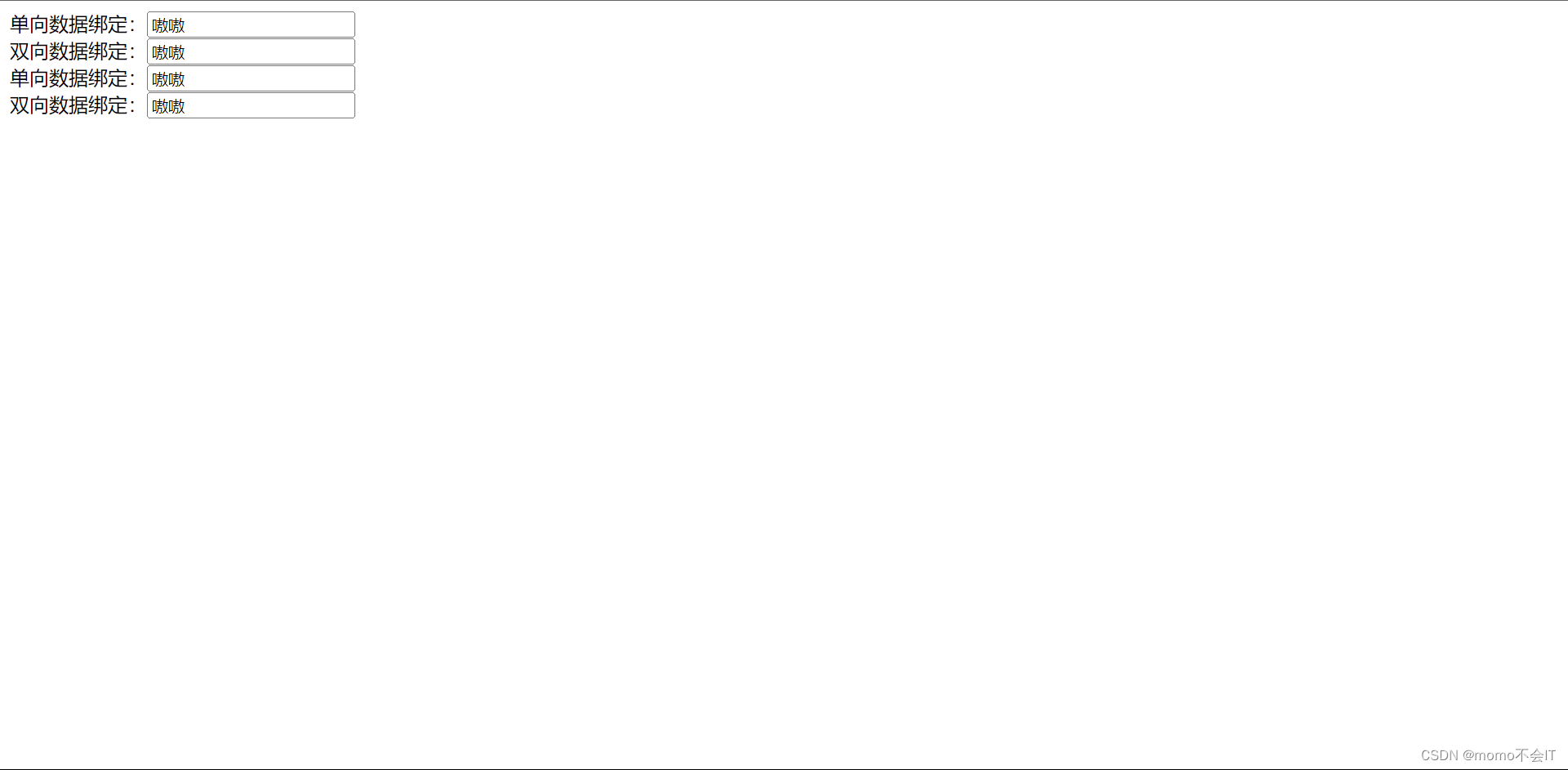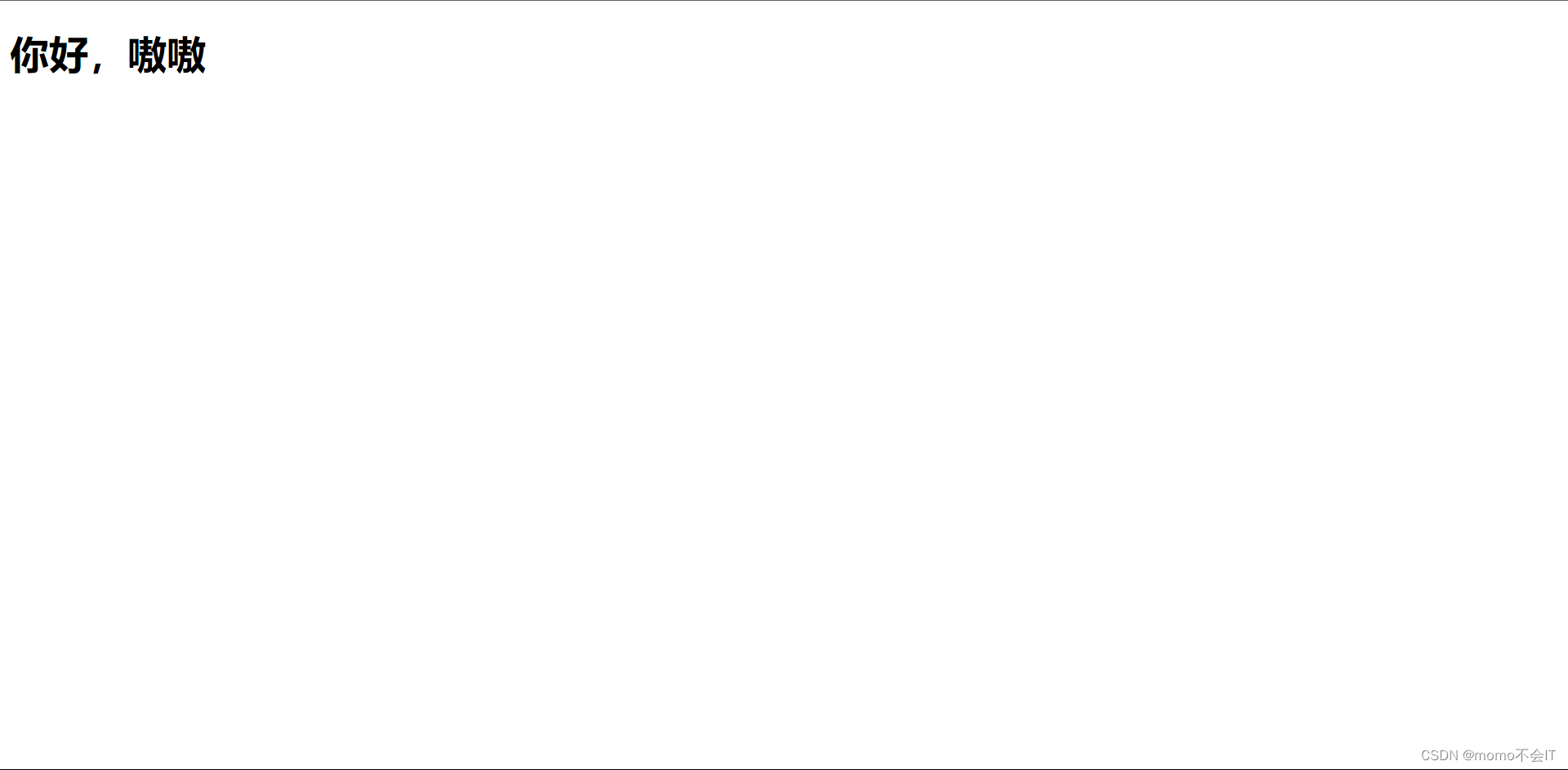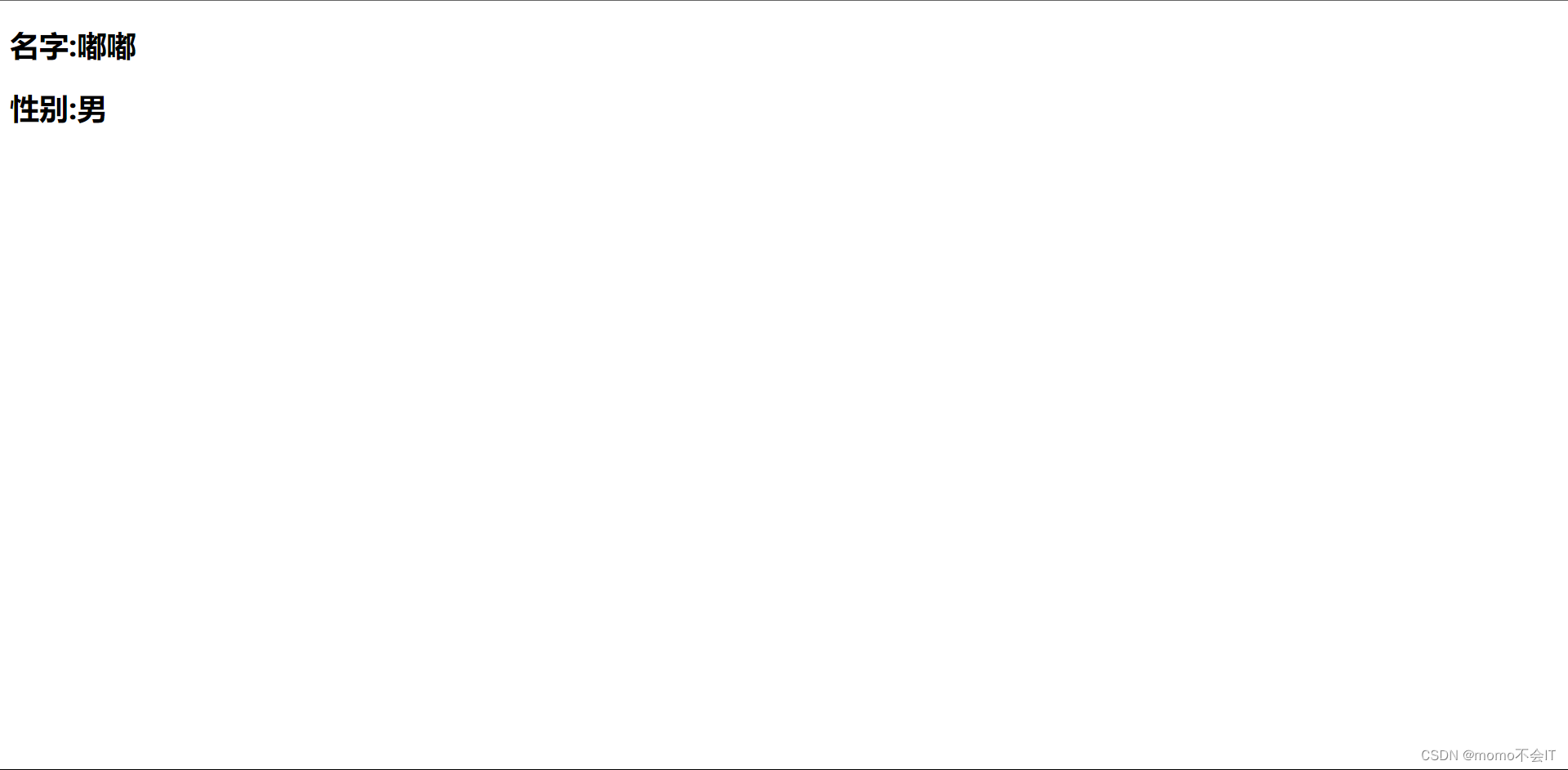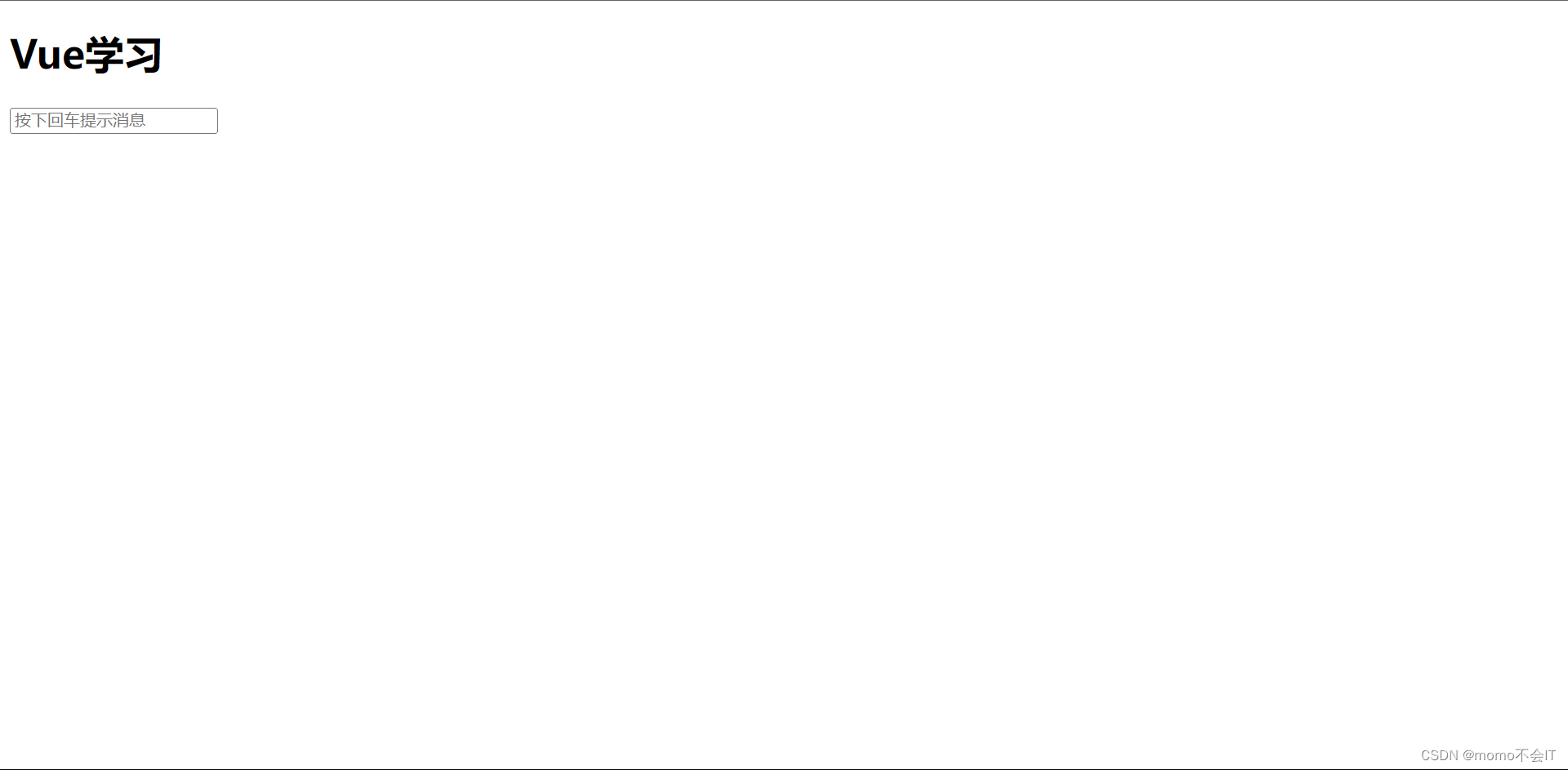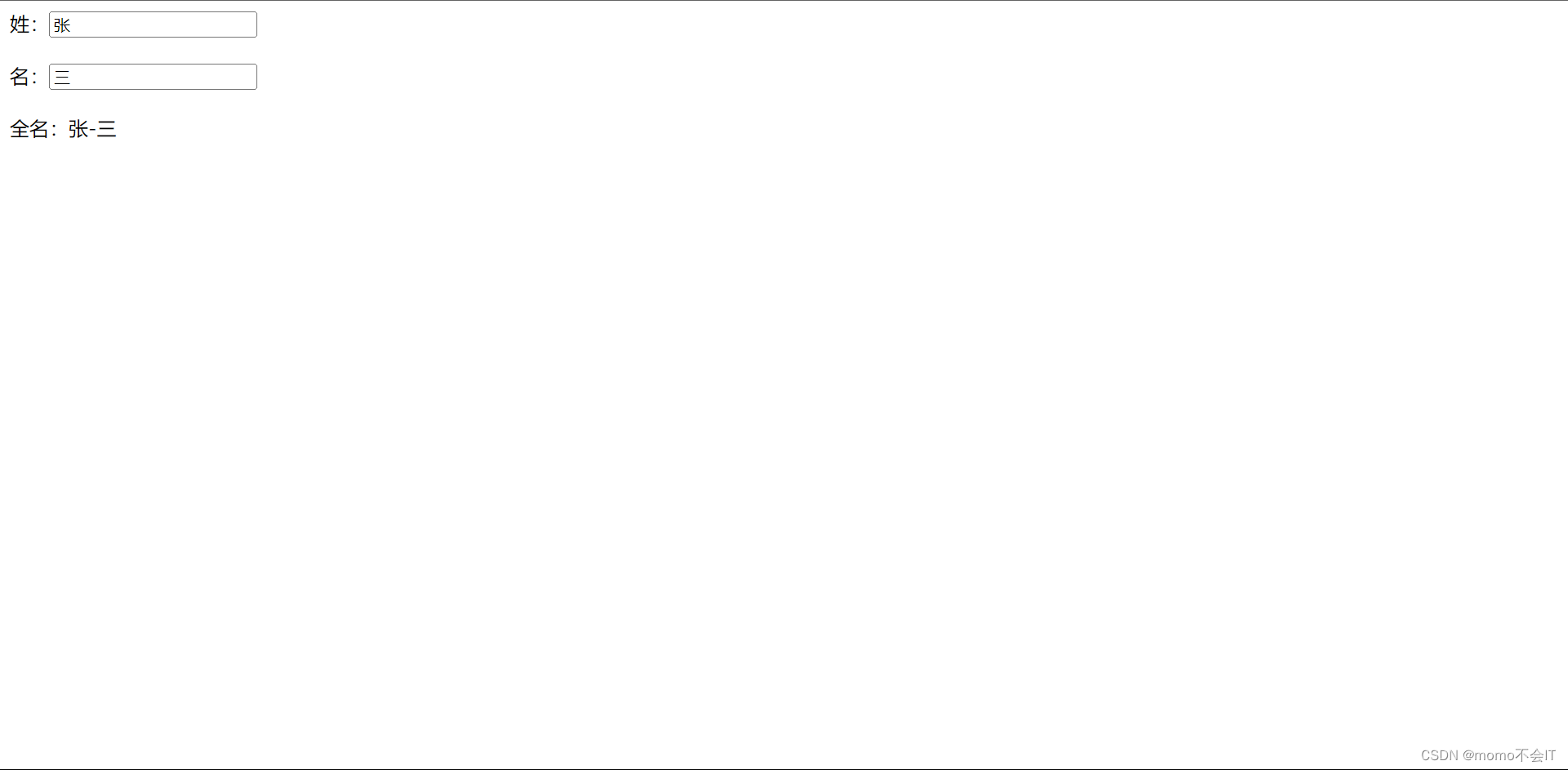目录
Vue简介:
Vue是一套用于构建用户界面的渐进式的js框架,发布于2014年2月。与其它大型框架不同的是,Vue被设计为可以自底向上逐层应用。Vue的核心库只关注视图层,不仅易于上手,还便于与第三方库( 如: vue-router,vue-resource,vuex)或既有项目整合。
MVVM模式的实现者--双向数据绑定
- Model:模型层,在这里表示JavaScript对象
- View:视图层,在这里表示DOM(HTML操作的元素)
- ViewModel:连接视图和数据的中间件,Vue.js就是MVVM中的ViewModel层的实现者

在MVVM架构中,是不允许数据和视图直接通信的,只能通过ViewModel来通信,而ViewModel就是定义了Observe观察者
- ViewModel能够观察到数据的变化,并对视图下对应的内容进行更新
- ViewModel能够监听到视图的变化,并且能够通知数据的变化
至此,我们就明白了,Vue.js就是一个MVVM的实现者,他的核心就是实现DOM监听与数据绑定
其他MVVM实现者
AngularJS
AngularJS诞生于2o09年,由Misko Hevery等人创建,后为Google所收购。是一款优秀的前端JS框架,已经被用于Google的多款产品当中。AngularJS有着诸多特性,最为核心的是:MWM、模块化、自动化双向数据绑定、语义化标签、依赖注入等等
ReactJS
React引入了虚拟DOM(Virtual DOM)的机制:在浏览器端用Javascript实现了一套DOMAPI。基于React进行开发时所有的DOM构造都是通过虚拟DOM进行,每当数据变化时,React都会重新构建整个DOM树,然后React将当前整个DOM树和上一次的DOM树进行对比,得到DOM结构的区别,然后仅仅将需要变化的部分进行实际的浏览器DOM更新。
微信小程序
微信小程序的视图层和数据层就是通过MWVM进行绑定的。
为什么要使用Vue.js
- 轻量级,体积小是一个重要指标。Vue.js压缩后有只有203 3 kb(Angular压缩后56 kb+,React压缩后44 kb+)
- 移动优先。更适合移动端,比如移动端的Touch事件
- 易上手,学习曲线平稳,文档齐全
- 吸取了Angular(模块化)和React(虚拟DOM)的长处,并拥有自己独特的功能,如:计算属性
- 开源,社区活跃度高
Vue.js的两大核心要素
数据驱动
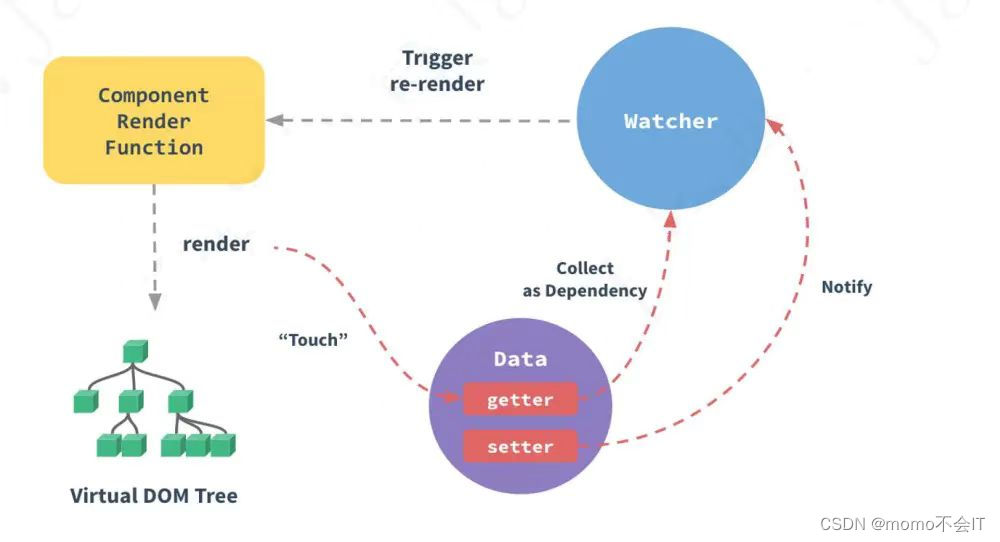
- 当你把一个普通的JavaScript对象传给Vue实例的data选项,Vue将遍历此对象所有的属性,并使用Object.defineProperty把这些属性全部转为getter/setter。Object.defineProperty是ES5中一个无法shim的特性,这也就是为什么Vue不支持IE8以及更低版本浏览器。
- 这些getter/setter对用户来说是不可见的,但是在内部它们让Vue追踪依赖,在属性被访问和修改时通知变化。这里需要注意的问题是浏览器控制台在打印数据对象时getter/setter的格式化并不同,所以你可能需要安装vue-devtools来获取更加友好的检查接口。
- 每个组件实例都有相应的watcher实例对象,它会在组件渲染的过程中把属性记录为依赖,之后当依赖项的setter被调用时,会通知watcher重新计算,从而致使它关联的组件得以更新。
组件化
- 页面上每个独立的可交互的区域视为一个组件
- 每个组件对应一个工程目录,组件所需的各种资源在这个目录下就近维护
- 页面不过是组件的容器,组件可以嵌套自由组合(复用)形成完整的页面
搭建Vue开发环境

在这里我们选择开发版本进行下载,开发版本里面包含了完整的警告和调试模式,千万不想使用生产版本进行学习,生产版本只是说你的项目已经做好了,想让Vue这个框架的体积更小时使用。
新建两个文件夹一个存放html,一个存放我们下载的Vue.
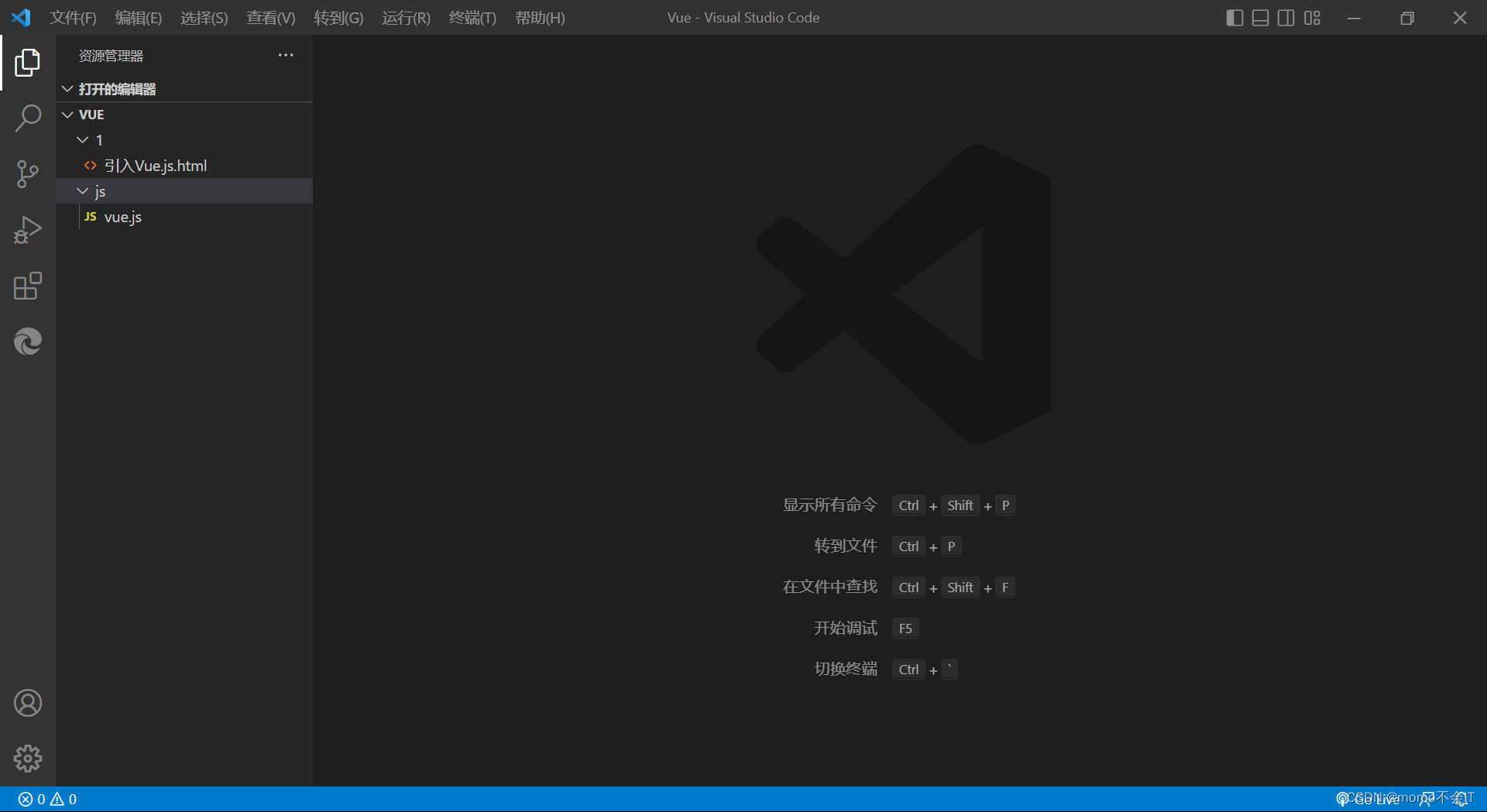
在html文件中引入Vue.js
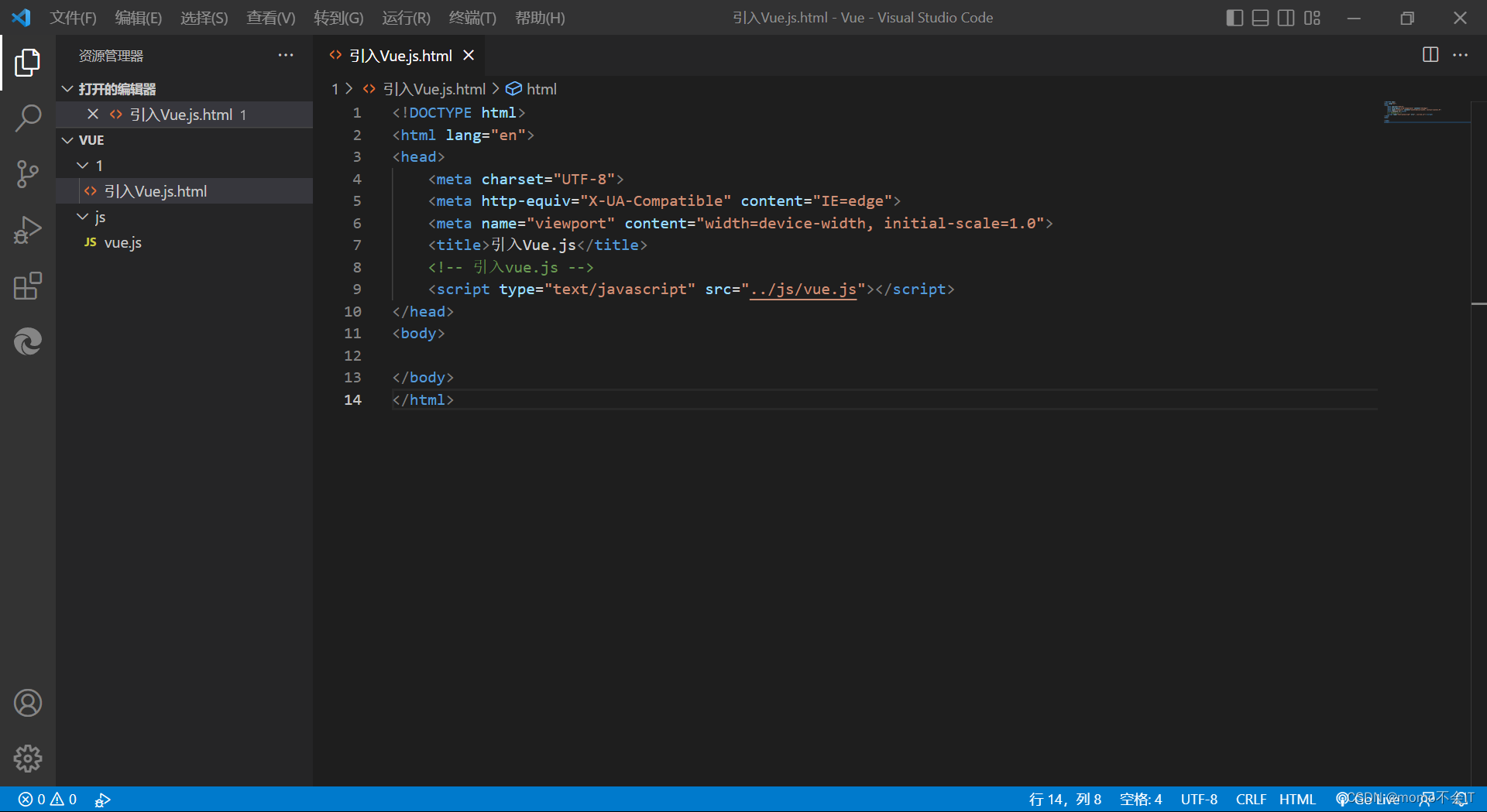
启动调试,在操控台中会出现两条提示
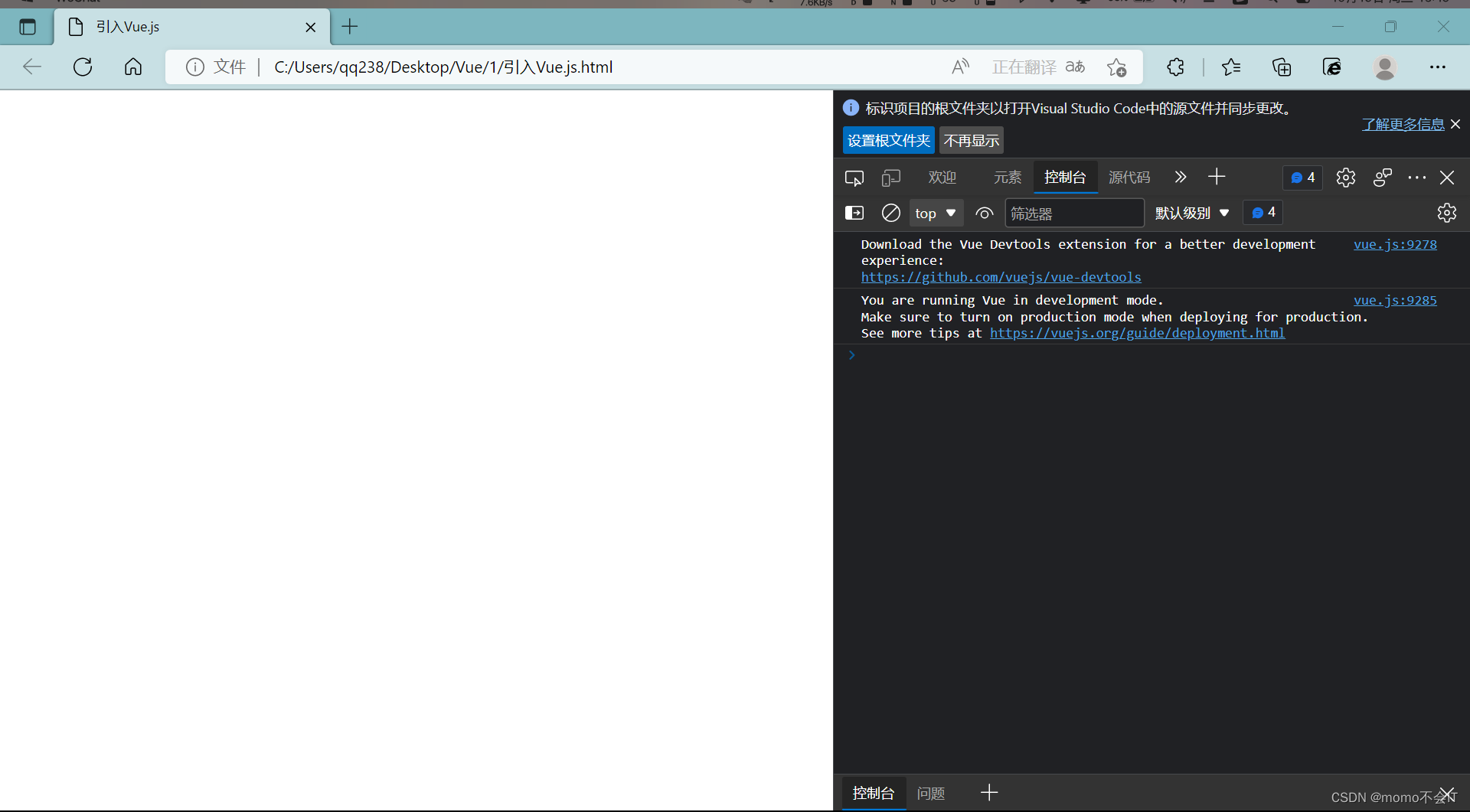
第一条提示是要你在浏览器中安装Vue开发者工具
第二条提示是生产工具的提示
解决方法:
官方文档:Vue Devtools,点击Vue Devtools会转跳到GitHub页面

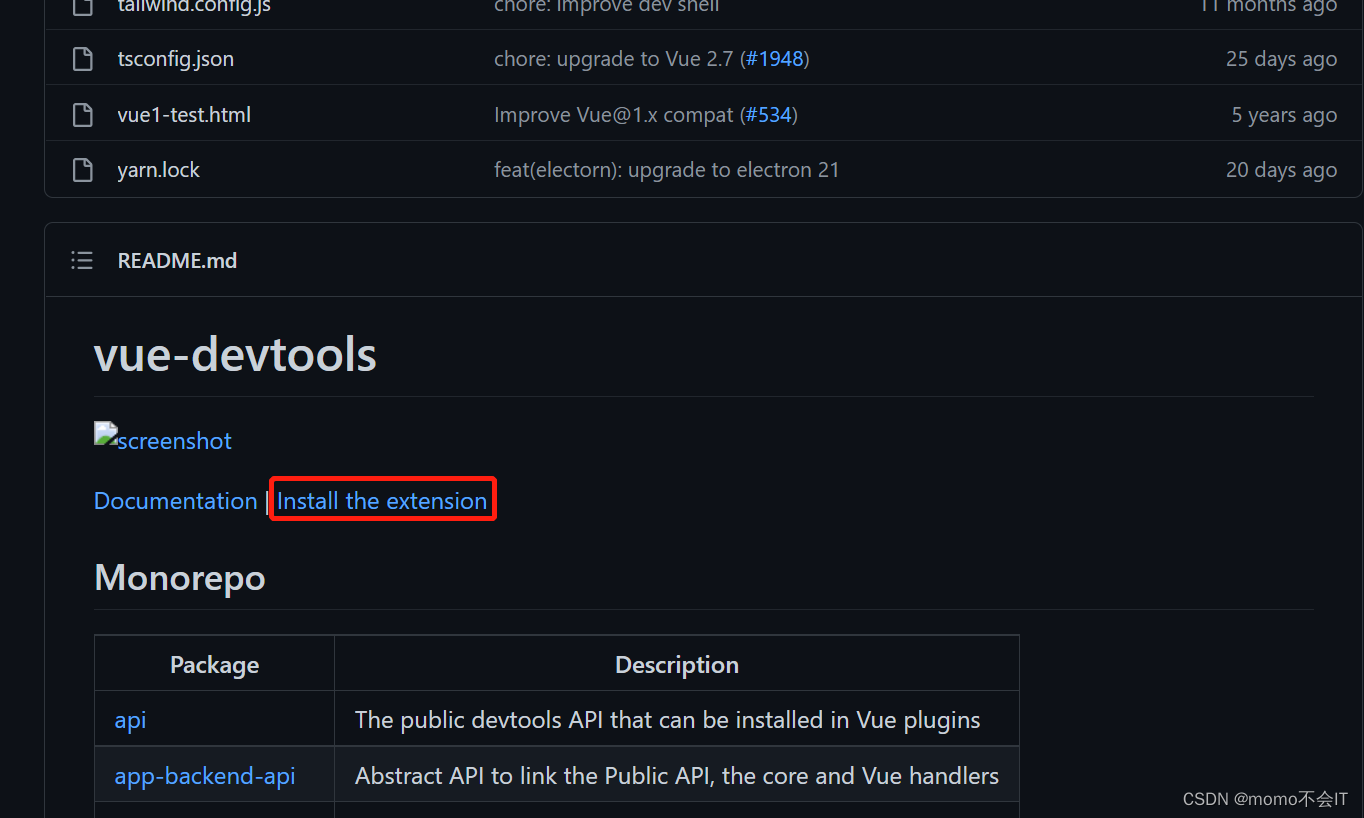 选择相应的浏览器进行下载
选择相应的浏览器进行下载
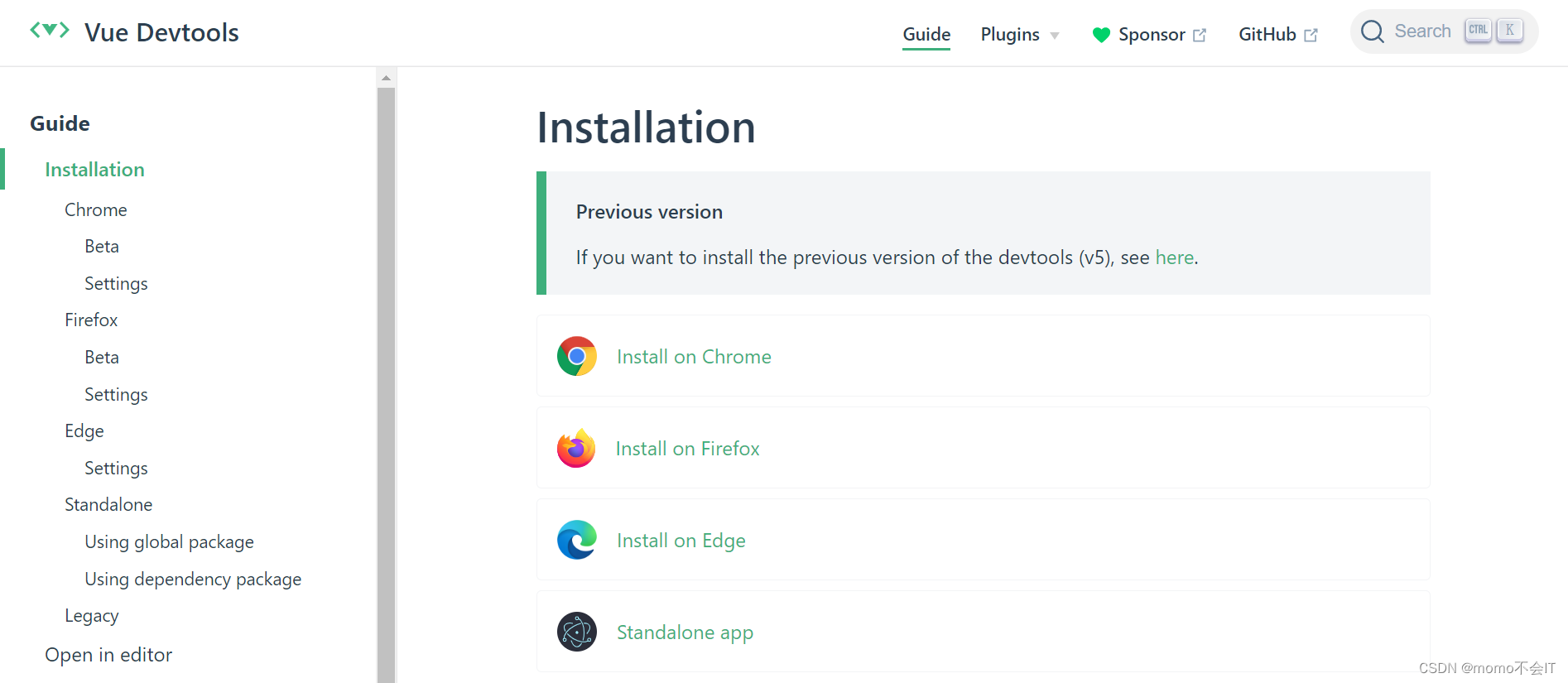
若你的浏览器是谷歌,安装完后必须把以下的勾选了

IE浏览器

安装成功后重新运行

并且在控制台中会多出了一个Vue的控制台

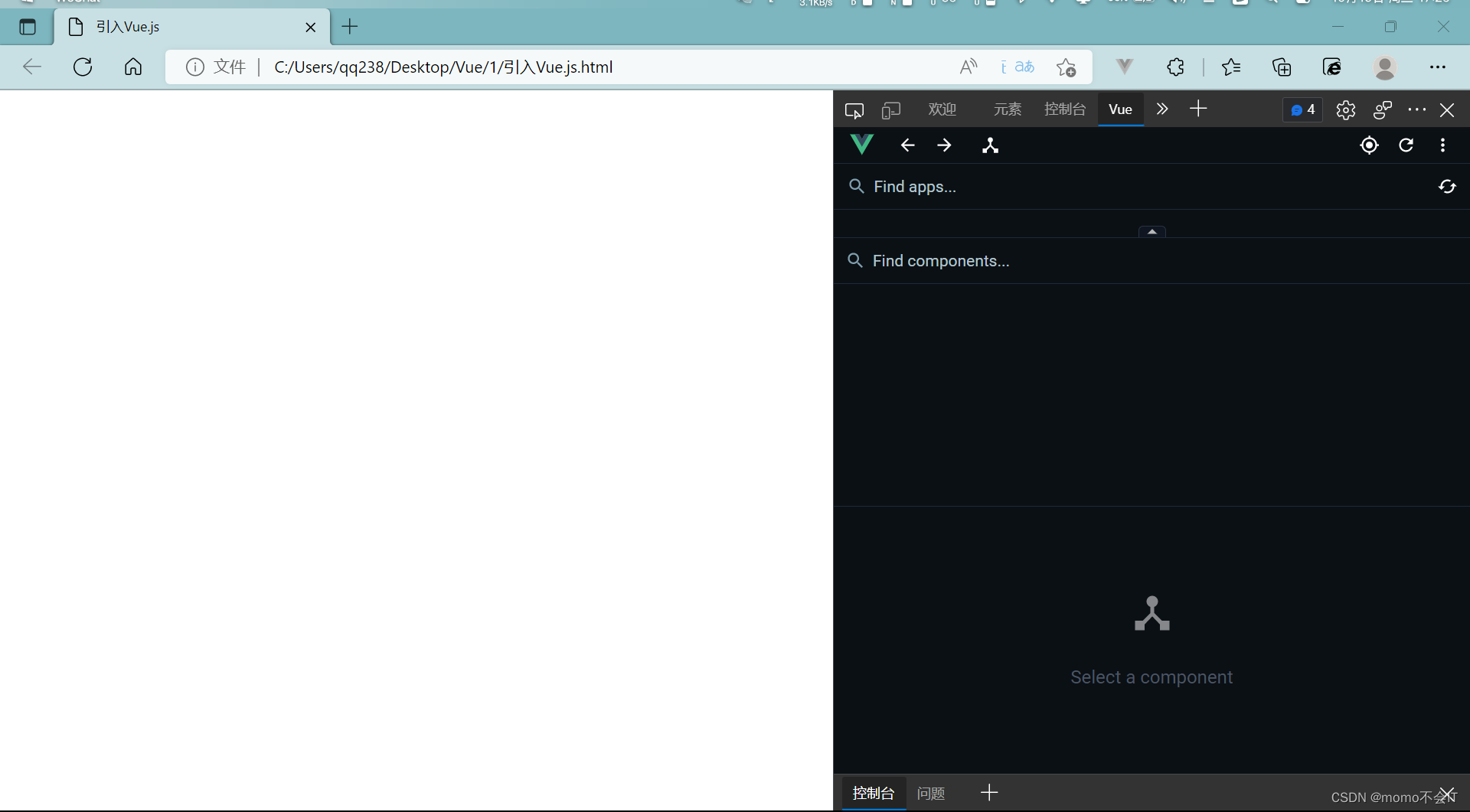
生产提示关闭:
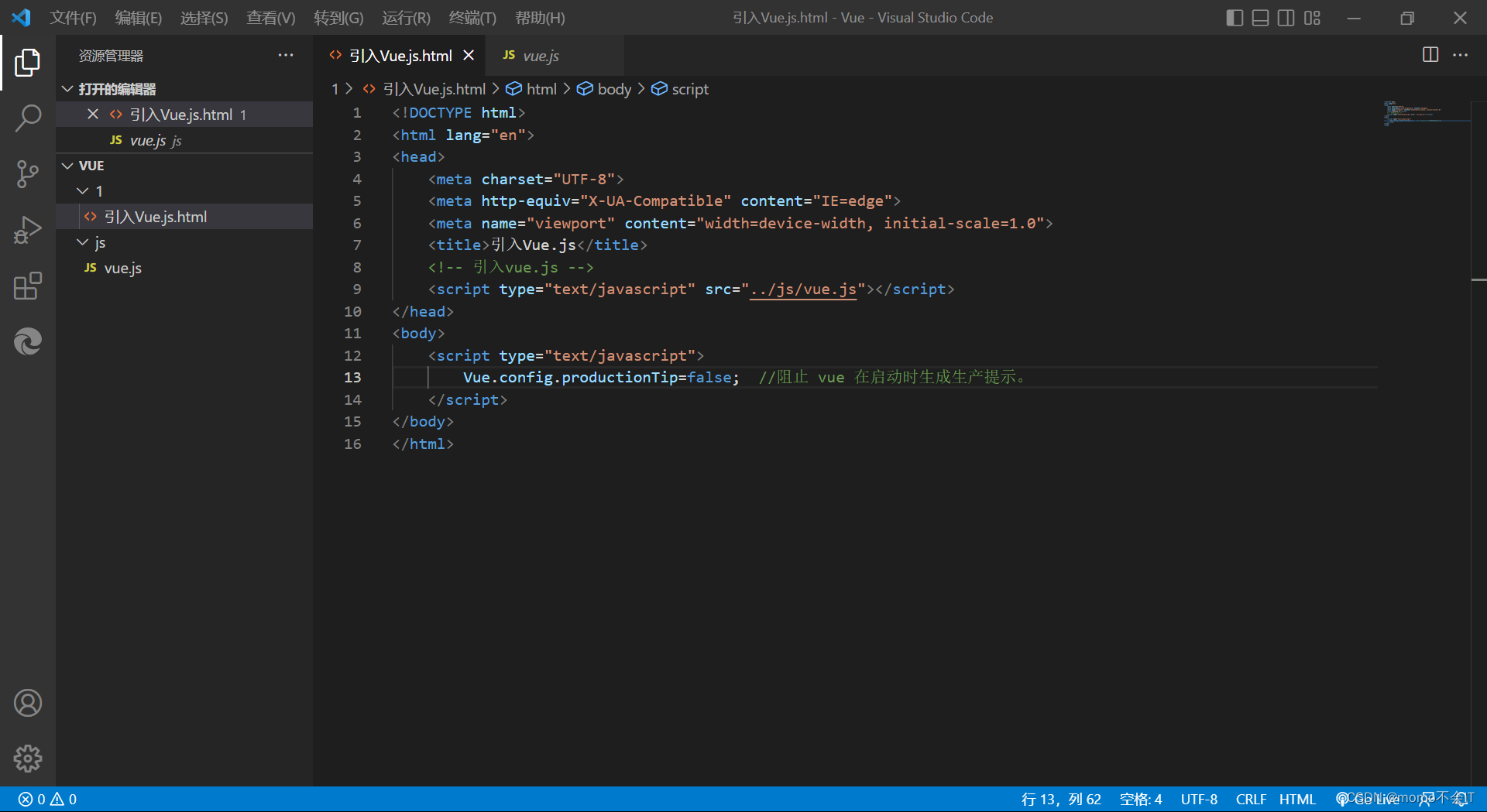
认识Vue
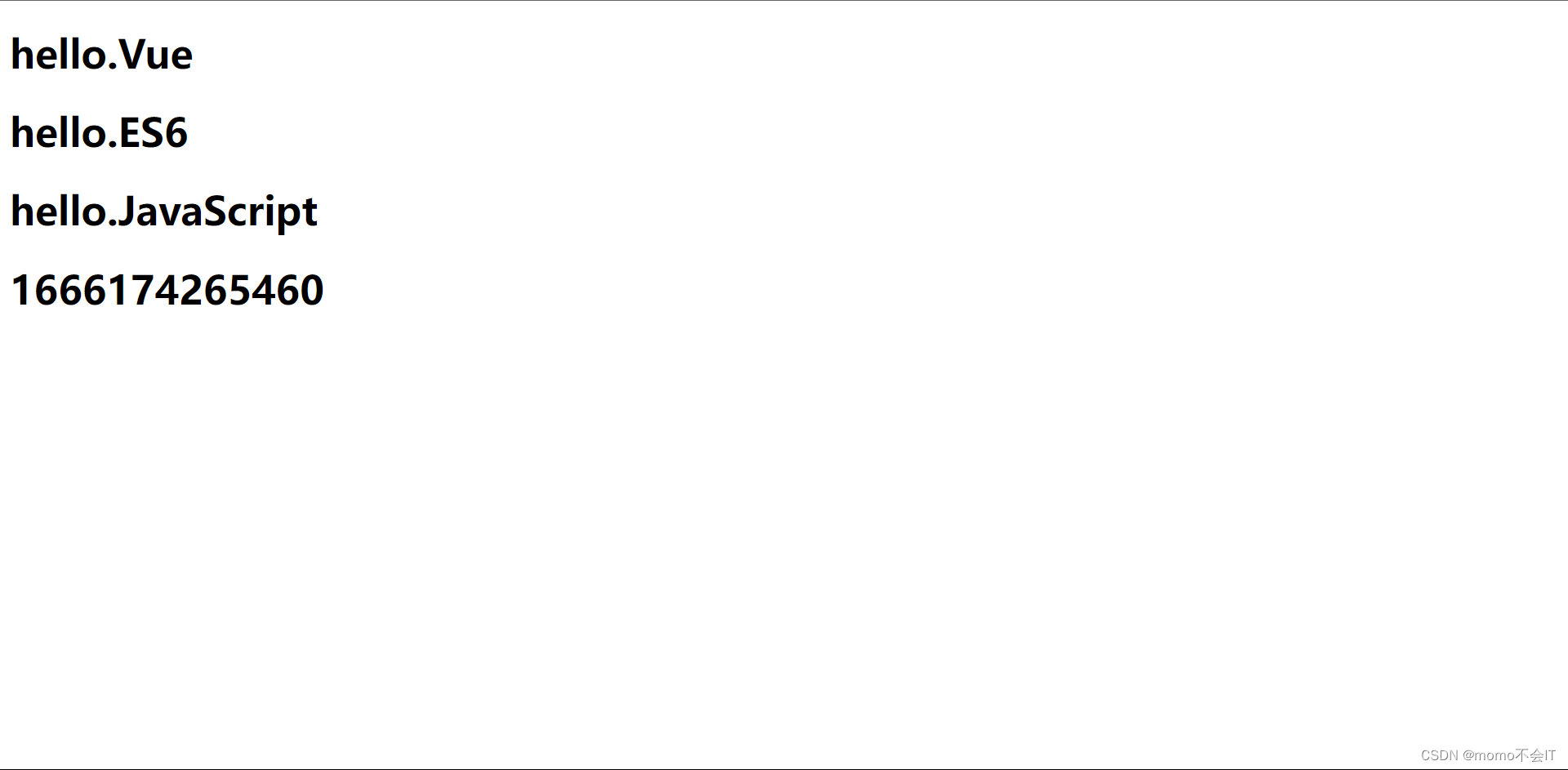
Vue的模板语法
<!DOCTYPE html>
<html lang="en">
<head>
<meta charset="UTF-8">
<meta http-equiv="X-UA-Compatible" content="IE=edge">
<meta name="viewport" content="width=device-width, initial-scale=1.0">
<title>模板语法</title>
<!-- 引入vue -->
<script type="text/javascript" src="../js/vue.js"></script>
</head>
<body>
<!-- 准备好一个容器 -->
<div id="root">
<h1>插值语法</h1>
<h3>你好,{
{name}}</h3>
<hr/>
<h1>指令语法</h1>
<a v-bind:href="url">百度1</a>
<!-- 简写 -->
<a :href="url">百度2</a>
</div>
</body>
<script type="text/javascript">
Vue.config.productionTip = false; //阻止 vue 在启动时生成生产提示。
new Vue({
el:'#root',
data:{
name:'jack',
url:'http://www.baidu.com',
}
});
</script>
</html>
<!-- 总结 -->
<!--
Vue模板语法有两大类:
1.插值语法:
功能:用于解析标签体内容
写法:{
{xxx}} xxx是js表达式,而且可以直接读取带data中的所有属性
2.指令语法:
功能:用于解析标签(包括:标签属性、标签体内容、绑定事件...)
举例:v-bind:href="xxx" 或 简写为 :href="xxx", xxx同样要写js表达式,且可以直接读取到data中的所有属性
备注:Vue中有很多的命令,且形式都是:v-??? 此处拿v-bind举例子
-->Vue的数据绑定
<!DOCTYPE html>
<html lang="en">
<head>
<meta charset="UTF-8">
<meta http-equiv="X-UA-Compatible" content="IE=edge">
<meta name="viewport" content="width=device-width, initial-scale=1.0">
<title>数据绑定</title>
<script type="text/javascript" src="../js/vue.js"></script>
</head>
<body>
<!-- 准备好一个盒子 -->
<div id="root">
<!-- 普通写法 -->
单向数据绑定:<input type="text" v-bind:value="name"></br>
双向数据绑定:<input type="text" v-model:value="name"></br>
<!-- 简写 -->
单向数据绑定:<input type="text" :value="name"></br>
双向数据绑定:<input type="text" v-model="name"></br>
<!-- 如下代码是错误的,因为v-mode只能应用在表单类元素(输入类元素) -->
<!-- <h2 v-mobel:x="name">你好</h2> -->
</div>
</body>
<script type="text/javascript">
Vue.config.productionTip = false; //阻止 vue 在启动时生成生产提示。
new Vue({
el:'#root',
data:{
name:'嗷嗷',
}
});
</script>
</html>
<!-- 总结 -->
<!--
Vue中有两种数据绑定的方式:
1.单向绑定(v-bind):数据只能从data流向页面
2.双向绑定(v-model):数据不能能从data流向页面,还可从页面流向data
备注:
1.双向绑定一般都应用在表单类元素上(如:input、select等)
2.v-model:value 可以简写为v-model ,因为v-model默认收集的就是value值
-->el和data的两种写法
<!DOCTYPE html>
<html lang="en">
<head>
<meta charset="UTF-8">
<meta http-equiv="X-UA-Compatible" content="IE=edge">
<meta name="viewport" content="width=device-width, initial-scale=1.0">
<title>el和data的两种写法</title>
<script type="text/javascript" src="../js/vue.js"></script>
</head>
<body>
<!-- 准备好一个盒子 -->
<div id="root">
<h1>你好,{
{name}}</h1>
</div>
</body>
<script type="text/javascript">
Vue.config.productionTip = false; //阻止 vue 在启动时生成生产提示。
//el的两种写法
// const vm = new Vue({
// // el:'#root', //第一种写法
// data:{
// name:'嗷嗷'
// }
// })
// console.log(vm);
// v.$mount('#root'); //第二种写法
// 定时器
// setTimeout(() => {
// vm.$mount('#root');
// }, 4000);
// data的两种写法
new Vue({
el:'#root',
// data的第一种写法:对象式
// data:{
// name:'嗷嗷'
// }
// data的第二种写法:函数式
data(){
console.log('@@@',this); //此处的this是Vue实例对象
return{
name:'嗷嗷'
}
}
})
</script>
</html>
<!-- 总结 -->
<!--
el和data的两种写法
1.el的两种写法:
(1)new Vue时候配置el属性
(2)先创建Vue实例,随后再通过vm.$mount('#root')指定el的值
2.data有两种写法:
(1)对象式
(2)函数式
如何选择:目前写哪种都可以,以后学习到组件时,data必须使用函数式,否则会报错
3.一个重要的原则:
由Vue管理的函数,一定不要写箭头函数,一旦写了箭头函数,this就不再是Vue实例了
函数:1.data:funtion(){} 2.data(){}
箭头函数:data:()=>{}
-->MVVM模型
<!DOCTYPE html>
<html lang="en">
<head>
<meta charset="UTF-8">
<meta http-equiv="X-UA-Compatible" content="IE=edge">
<meta name="viewport" content="width=device-width, initial-scale=1.0">
<title>MVVM模型</title>
<!--
MVVM模型
1.M:模型(model):对应data中的数据
2.V:视图(View):模板
3.VM:视图模型(ViewModel):Vue实例对象
观察发现:
1.data中所有的属性,最后都出行在vm身上
2.vm身上的所有属性 及 Vue原型上所有的属性,在Vue模板中都可以直接使用
-->
<script type="text/javascript" src="../js/vue.js"></script>
</head>
<body>
<!-- 准备好一个盒子 -->
<div id="root">
<h1>你好,{
{name}}</h1>
<h1>再见,{
{namee}}</h1>
<!-- <h1>测试1:{
{$options}}</h1>
<h1>测试2:{
{$mount}}</h1>
<h1>测试3:{
{_c}}</h1> -->
</div>
</body>
<script type="text/javascript">
Vue.config.productionTip = false; //阻止 vue 在启动时生成生产提示。
const vm = new Vue({
el:'#root',
data:{
name:'aoao',
namee:'嗷嗷',
}
})
console.log(vm);
</script>
</html>数据代理
Object.defineProperty方法
<!DOCTYPE html>
<html lang="en">
<head>
<meta charset="UTF-8">
<meta http-equiv="X-UA-Compatible" content="IE=edge">
<meta name="viewport" content="width=device-width, initial-scale=1.0">
<title>Object.defineProperty方法</title>
</head>
<body>
<script type="text/javascript">
let number = 18;
let person = {
name:'嘟嘟',
sex:'男',
}
Object.defineProperty(person,'age',{
// value:18,
// enumerable:true,
// writable:true,
// configurable:true,
// 当读取person的age属性时,get函数(getter)就会被调用,且返回值就是age值
get(){
console.log('读取age属性')
return(number)
},
// 当修改person的age属性时,set函数(setter)就会被调用,且会收到修改的具体值
set(value){
console.log('修改了age属性,值为',value)
}
})
console.log(person);
</script>
</body>
</html>何为数据代理
<!DOCTYPE html>
<html lang="en">
<head>
<meta charset="UTF-8">
<meta http-equiv="X-UA-Compatible" content="IE=edge">
<meta name="viewport" content="width=device-width, initial-scale=1.0">
<title>何为数据代理</title>
</head>
<body>
<!-- 数据代理:就是通过一个对象代理对另一个对象属性的操作(读/写) -->
<script type="text/javascript">
let obj = {x:100}
let obj2 = {y:200}
Object.defineProperty(obj2,'x',{
get(){
return obj.x;
},
set(value){
obj.x = value;
}
})
console.log(obj2);
</script>
</body>
</html>Vue中的数据代理
<!DOCTYPE html>
<html lang="en">
<head>
<meta charset="UTF-8">
<meta http-equiv="X-UA-Compatible" content="IE=edge">
<meta name="viewport" content="width=device-width, initial-scale=1.0">
<title>Vue中的数据代理</title>
<script type="text/javascript" src="../js/vue.js"></script>
</head>
<body>
<!-- 准备好一个盒子 -->
<div id="root">
<h2>名字:{
{name}}</h2>
<h2>性别:{
{sex}}</h2>
</div>
</body>
<script type="text/javascript">
Vue.config.productionTip = false; //阻止 vue 在启动时生成生产提示。
const vm = new Vue({
el:'#root',
data:{
name:'嘟嘟',
sex:'男',
}
})
</script>
</html>
<!-- 总结 -->
<!--
1.Vue中的数据代理:
通过vm对象来处理data对象中的属性的操作(读/写)
2.Vue中数据代理的好处:
更加方便地操作data中的数据
3.基本原理:
通过Object.defineProperty()把data对象中的所有属性添加到vm上
为每一个添加到vm上的属性,都指定一个getter/setter
在getter/setter内部去操作(读/写)data中相应的属性
-->事件处理
事件的基本使用
<!DOCTYPE html>
<html lang="en">
<head>
<meta charset="UTF-8">
<meta http-equiv="X-UA-Compatible" content="IE=edge">
<meta name="viewport" content="width=device-width, initial-scale=1.0">
<title>事件的基本使用</title>
<script type="text/javascript" src="../js/vue.js"></script>
</head>
<body>
<!-- 准备好一个盒子 -->
<div id="root">
<h1>{
{name}}学习</h1>
<button @click="showInfo1">点击提示信息1(不传参)</button>
<button @click="showInfo2(66,$event)">点击提示信息2(传参)</button>
</div>
</body>
<script type="text/javascript">
Vue.config.productionTip = false; //阻止 vue 在启动时生成生产提示。
const vm = new Vue({
el:'#root',
data:{
name:'Vue',
},
methods:{
showInfo1(event){
console.log(event.target.innerText);
console.log(this);//此处的this是vm
alert('你好!');
},
showInfo2(number,event){
console.log(number,event);
console.log(this);//此处的this是vm
alert('你好!!!');
}
}
})
</script>
</html>
<!-- 总结 -->
<!--
事件的基本使用:
1.使用v-on:xxx 或 @xxx 绑定事件,其中xxx是文件名
2.事件的回调需要配置在methods对象中,最终会在vm上
3.methods中配置的函数,不要用箭头函数!否则this就不是vm的this了
4.methods中配置的函数,都是被Vue所管理的函数,this的指向是vm 或 组件实例对象
5.@click="demo" 和 @click="demo($event)" 效果一样,但后者可以传参
-->事件修饰符
<!DOCTYPE html>
<html lang="en">
<head>
<meta charset="UTF-8">
<meta http-equiv="X-UA-Compatible" content="IE=edge">
<meta name="viewport" content="width=device-width, initial-scale=1.0">
<title>事件修饰符</title>
<script type="text/javascript" src="../js/vue.js"></script>
<style type="text/css">
*{
margin-top: 10px;
}
.demo1{
height: 50px;
background-color: skyblue;
}
.box1{
padding: 5px;
background-color: skyblue;
}
.box2{
padding: 5px;
background-color: orange;
}
.list{
width: 200px;
height: 200px;
background-color: yellow;
overflow: auto;
}
li{
height: 100px;
}
</style>
</head>
<body>
<!-- 准备好一个盒子 -->
<div id="root">
<h1>{
{name}}学习</h1>
<!-- 阻止默认事件(常用) -->
<a href="http://www.baidu.com" @click.prevent="showInfo">点击提示信息1</a>
<!-- 阻止事件冒泡 -->
<div class="demo1" @click="showInfo">
<button @click.stop="showInfo">点击提示信息2</button>
<!-- 修饰符可以连续写 -->
<!-- <a href="http://www.baidu.com"n @click.stop.prevent="showInfo">点击提示信息2</a> -->
</div>
<!-- 事件只触发一次(常用) -->
<button @click.once="showInfo">事件只触发一次</button>
<!-- 使用事件的捕获模式 -->
<div class="box1" @click.capture="showMag(1)">
div1
<div class="box2" @click="showMag(2)">
div2
</div>
</div>
<!-- 只有event.target是当前操作的元素时才触发事件 -->
<div class="demo1" @click.self="showInfo">
<button @click="showInfo">点击提示信息</button>
</div>
<!-- 事件的默认行为立即执行,无需等待事件回调执行完毕 -->
<!-- wheel -->
<ul @wheel.passive="demo" class="list">
<li>1</li>
<li>2</li>
<li>3</li>
<li>4</li>
</ul>
</div>
</body>
<script type="text/javascript">
Vue.config.productionTip = false; //阻止 vue 在启动时生成生产提示。
const vm = new Vue({
el:'#root',
data:{
name:'Vue',
},
methods:{
showInfo(e){
alert('hello!');
// console.log(e.target)
},
showMag(msg){
console.log(msg);
},
demo(){
// console.log('@');
for (let i = 0; i < 10000; i++) {
console.log('#');
}
console.log('嘟嘟');
}
}
})
</script>
</html>
<!-- 总结 -->
<!--
Vue中的事件修饰符:
1.prevent:阻止默认事件(常用)
2.stop:阻止事件冒泡(常用)
3.once:事件只触发一次(常用)
4.capture:使用事件的捕获模式
5.self:只有event.target是当前操作的元素时才触发事件
6.passive:事件的默认行为立即执行,无需等待事件回调执行完毕
-->键盘事件
<!DOCTYPE html>
<html lang="en">
<head>
<meta charset="UTF-8">
<meta http-equiv="X-UA-Compatible" content="IE=edge">
<meta name="viewport" content="width=device-width, initial-scale=1.0">
<title>Document</title>
<script type="text/javascript" src="../js/vue.js"></script>
</head>
<body>
<!-- 准备好一个盒子 -->
<div id="root">
<h1>{
{name}}学习</h1>
<input type="text" placeholder="按下回车提示消息" @keyup.ctrl.y="showInfo">
</div>
</body>
<script type="text/javascript">
Vue.config.productionTip = false; //阻止 vue 在启动时生成生产提示。
const vm = new Vue({
el:'#root',
data:{
name:'Vue',
showInfo(e){
// if(e.keyCode !== 13) return
console.log(e.target.value);
}
}
})
</script>
</html>
<!-- 总结 -->
<!--
1.Vue中常用的按键别名:
回车 => enter
删除 => delete(捕获"删除"和"退格"键)
退出 => esc
空格 => space
换行 => tab(特殊,必须配合keydowm去使用)
上 => up
下 => down
左 => left
右 => right
2.Vue未提供别名的按键,可以使用按键原始的key值去绑定,但注意转为kebab-case(短横线命名)
3.系统修饰键(用特殊法)ctrl、alt、shift、meta
(1)配合keyup使用:按下修饰键的同时,再按下其他键,随后释放其他键,事件才被处罚
(2)配合keydown使用:正常触发事件
4.也可以使用ketCodes去指定具体的按键(不推荐)
5.Vue.config.keyCodes.自定义名 = 键码,可以定制按键别名
-->计算属性
插值语法实现
<!DOCTYPE html>
<html lang="en">
<head>
<meta charset="UTF-8">
<meta http-equiv="X-UA-Compatible" content="IE=edge">
<meta name="viewport" content="width=device-width, initial-scale=1.0">
<title>姓名案例_插值语法实现</title>
<script type="text/javascript" src="../js/vue.js"></script>
</head>
<body>
<!-- 准备好一个盒子 -->
<div id="root">
姓:<input type="text" v-model="firstName"></br></br>
名:<input type="text" v-model="lastName"></br></br>
全名:<span>{
{firstName}}-{
{lastName}}</span>
</div>
</body>
<script type="text/javascript">
Vue.config.productionTip = false; //阻止 vue 在启动时生成生产提示。
const vm = new Vue({
el:'#root',
data:{
firstName:'张',
lastName:'三',
},
})
</script>
</html>methods实现
<!DOCTYPE html>
<html lang="en">
<head>
<meta charset="UTF-8">
<meta http-equiv="X-UA-Compatible" content="IE=edge">
<meta name="viewport" content="width=device-width, initial-scale=1.0">
<title>姓名案例.methods实现</title>
<script type="text/javascript" src="../js/vue.js"></script>
</head>
<body>
<!-- 准备好一个盒子 -->
<div id="root">
姓:<input type="text" v-model="firstName"></br></br>
名:<input type="text" v-model="lastName"></br></br>
全名:<span>{
{fullName()}}</span>
</div>
</body>
<script type="text/javascript">
Vue.config.productionTip = false; //阻止 vue 在启动时生成生产提示。
const vm = new Vue({
el:'#root',
data:{
firstName:'张',
lastName:'三',
},
methods:{
fullName(){
return this.firstName + '-' + this.lastName;
}
}
})
</script>
</html> 计算属性实现
计算属性实现
<!DOCTYPE html>
<html lang="en">
<head>
<meta charset="UTF-8">
<meta http-equiv="X-UA-Compatible" content="IE=edge">
<meta name="viewport" content="width=device-width, initial-scale=1.0">
<title>姓名案例.计算属性实现</title>
<script type="text/javascript" src="../js/vue.js"></script>
</head>
<body>
<!-- 准备好一个盒子 -->
<div id="root">
姓:<input type="text" v-model="firstName"></br></br>
名:<input type="text" v-model="lastName"></br></br>
全名:<span>{
{fullName}}</span></br></br>
<!-- 全名:<span>{
{fullName}}</span></br></br>
全名:<span>{
{fullName}}</span></br></br>
全名:<span>{
{fullName}}</span></br></br>
全名:<span>{
{fullName}}</span></br></br>
全名:<span>{
{fullName}}</span></br></br> -->
</div>
</body>
<script type="text/javascript">
Vue.config.productionTip = false; //阻止 vue 在启动时生成生产提示。
const vm = new Vue({
el:'#root',
data:{
firstName:'张',
lastName:'三',
x:'你好',
},
computed:{
fullName:{
// get有什么作用?当有人读取fullName时,get就会被调用,且返回值就作为fullName的值
// get什么时候调用?1.初次读取fullName时 2.所依赖的数据发生变化时
get(){
console.log('get被调用了');
// console.log(this); //此处的this是vm
return this.firstName + '-' + this.lastName;
},
// set什么时候调用?当fullName被修改时
set(value){
console.log('set',value);
const arr = value.split('-');
this.firstName = arr[0];
this.lastName = arr[1];
}
}
}
})
</script>
</html>
<!-- 总结 -->
<!--
计算属性:
1.定义:要用的属性不存在,要通过已有属性计算得来
2.原理:底层借助了Object.defineproperty方法提供的getter和setter
3.get函数什么时候执行?
(1)初次读取时会执行一次
(2)当依赖的数据发生改变时会再次被调用
4.优势:与methods实现相比,内部有缓存机制(复用),效率更高,调试方便
5.备注:
1.计算属性最终会出现在vm上,直接读取使用即可
2.如果计算属性要被修改,那必须写set函数去响应修改,且set中要引起计算时依赖的数据发生变化
-->计算属性简写
<!DOCTYPE html>
<html lang="en">
<head>
<meta charset="UTF-8">
<meta http-equiv="X-UA-Compatible" content="IE=edge">
<meta name="viewport" content="width=device-width, initial-scale=1.0">
<title>姓名案例_计算属性简写</title>
<script type="text/javascript" src="../js/vue.js"></script>
</head>
<body>
<div id="root">
姓:<input type="text" v-model="firstName"></br></br>
名:<input type="text" v-model="lastName"></br></br>
全名:<span>{
{fullName}}</span></br></br>
</div>
</body>
<script type="text/javascript">
Vue.config.productionTip = false; //阻止 vue 在启动时生成生产提示。
const vm = new Vue({
el:'#root',
data:{
firstName:'张',
lastName:'三',
x:'你好',
},
computed:{
// 完整写法:
// fullName:{
// get(){
// console.log('get被调用了');
// return this.firstName + '-' + this.lastName;
// },
// set(value){
// console.log('set',value);
// const arr = value.split('-');
// this.firstName = arr[0];
// this.lastName = arr[1];
// }
// }
// 简写:
fullName(){
console.log('get被调用了');
return this.firstName + '-' + this.lastName;
}//只考虑读,不考虑修改的时候才能用
}
})
</script>
</html>监视属性
天气案例
<!DOCTYPE html>
<html lang="en">
<head>
<meta charset="UTF-8">
<meta http-equiv="X-UA-Compatible" content="IE=edge">
<meta name="viewport" content="width=device-width, initial-scale=1.0">
<title>天气案例</title>
<script type="text/javascript" src="../js/vue.js"></script>
</head>
<body>
<div id="root">
<h2>今天天气很{
{info}}</h2>
<button @click="changeWeather">切换天气</button>
<!-- 绑定事件的时候:@xxx=yyy yyy可以写一些简单的语句 -->
<!-- <button @click="isHot = !isHot">切换天气</button> -->
</div>
</body>
<script type="text/javascript">
Vue.config.productionTip = false; //阻止 vue 在启动时生成生产提示。
const vm = new Vue({
el:'#root',
data:{
isHot:true,
},
computed:{
info(){
return this.isHot? '炎热' : '凉爽';
}
},
methods: {
changeWeather(){
this.isHot = !this.isHot;
}
},
})
</script>
</html>
天气案例_监视属性
<!DOCTYPE html>
<html lang="en">
<head>
<meta charset="UTF-8">
<meta http-equiv="X-UA-Compatible" content="IE=edge">
<meta name="viewport" content="width=device-width, initial-scale=1.0">
<title>天气案例_监视属性</title>
<script type="text/javascript" src="../js/vue.js"></script>
</head>
<body>
<div id="root">
<h2>今天天气很{
{info}}</h2>
<button @click="changeWeather">切换天气</button>
<!-- 绑定事件的时候:@xxx=yyy yyy可以写一些简单的语句 -->
<!-- <button @click="isHot = !isHot">切换天气</button> -->
</div>
</body>
<script type="text/javascript">
Vue.config.productionTip = false; //阻止 vue 在启动时生成生产提示。
const vm = new Vue({
el:'#root',
data:{
isHot:true,
},
computed:{
info(){
return this.isHot? '炎热' : '凉爽';
}
},
methods: {
changeWeather(){
this.isHot = !this.isHot;
}
},
// watch:{
// isHot:{
// immediate:true,//初始化时让handler调用一下
// // handler什么时候调用?当isHot发生改变时
// handler(newValue,oldValue){
// console.log('isHot被修改了',newValue,oldValue);
// }
// }
// },
})
vm.$watch('isHot',{
immediate:true,//初始化时让handler调用一下
// handler什么时候调用?当isHot发生改变时
handler(newValue,oldValue){
console.log('isHot被修改了',newValue,oldValue);
}
})
</script>
</html>
<!-- 总结 -->
<!--
监视属性watch:
1.当被监视的属性变化时,回调函数自动调用,进行相关操作
2.监视的属性必须存在,才能进行监视!!
3.监视的两种写法:
(1)new.Vue时传入watch配置
(2)通过 vm.$watch监视
-->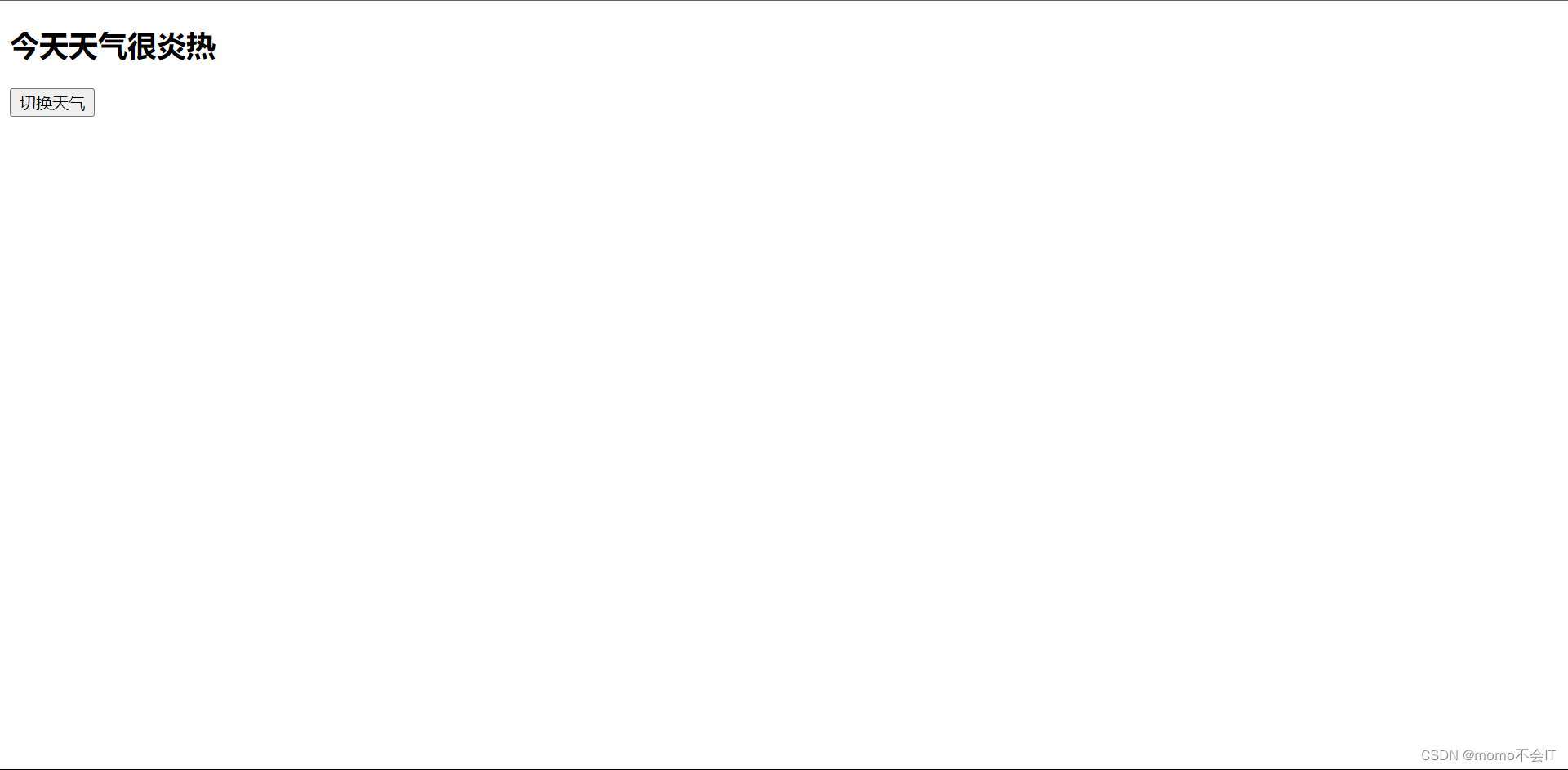
天气案例_深度监视
<!DOCTYPE html>
<html lang="en">
<head>
<meta charset="UTF-8">
<meta http-equiv="X-UA-Compatible" content="IE=edge">
<meta name="viewport" content="width=device-width, initial-scale=1.0">
<title>天气案例_深度监视</title>
<script type="text/javascript" src="../js/vue.js"></script>
</head>
<body>
<div id="root">
<h2>今天天气很{
{info}}</h2>
<button @click="changeWeather">切换天气</button>
</hr>
<h3>a的值是:{
{numbers.a}}</h3>
<button @click="numbers.a++">点击a+1</button>
<h3>b的值是:{
{numbers.b}}</h3>
<button @click="numbers.b++">点击b+1</button>
<button @click="numbers = {a:800,b:300}">彻底替换numbers</button>
</div>
</body>
<script type="text/javascript">
Vue.config.productionTip = false; //阻止 vue 在启动时生成生产提示。
const vm = new Vue({
el:'#root',
data:{
isHot:true,
numbers:{
a:1,
b:1,
}
},
computed:{
info(){
return this.isHot? '炎热' : '凉爽';
}
},
methods: {
changeWeather(){
this.isHot = !this.isHot;
}
},
watch:{
isHot:{
// immediate:true,//初始化时让handler调用一下
// handler什么时候调用?当isHot发生改变时
handler(newValue,oldValue){
console.log('isHot被修改了',newValue,oldValue);
}
},
// 监视多级结构中某个属性的改变
// 'numbers.a':{
// handler(){
// console.log('a被改变了');
// }
// }
// 监视多级结构中所有属性的改变
'numbers':{
deep:true,
handler(){
console.log('numbers被改变了');
}
}
},
})
</script>
</html>
<!-- 总结 -->
<!--
深度监视:
(1)Vue中的watch默认不检测对象内部值的改变(一层)
(2)配置deep:ture可以检测对象内部值改变(多层)
备注:
(1)Vue自身可以检测对象内部值的改变,但Vue提供的watch默认不可以!
(2)使用watch时根据数据的具体结构,决定是否采用深度检测
-->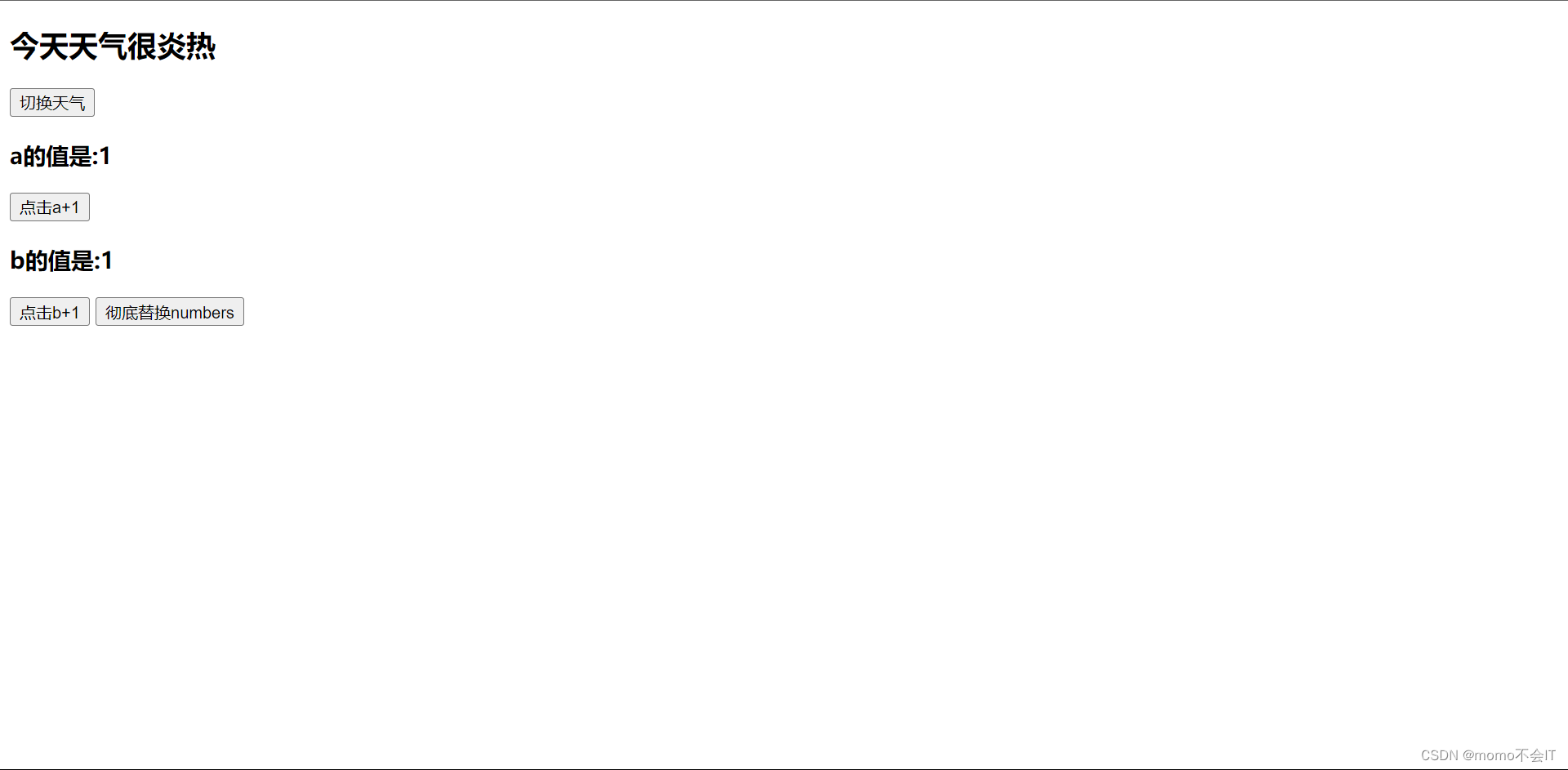
天气案例_监视属性_简写
<!DOCTYPE html>
<html lang="en">
<head>
<meta charset="UTF-8">
<meta http-equiv="X-UA-Compatible" content="IE=edge">
<meta name="viewport" content="width=device-width, initial-scale=1.0">
<title>天气案例_监视属性_简写</title>
<script type="text/javascript" src="../js/vue.js"></script>
</head>
<body>
<div id="root">
<h2>今天天气很{
{info}}</h2>
<button @click="changeWeather">切换天气</button>
</div>
</body>
<script type="text/javascript">
Vue.config.productionTip = false; //阻止 vue 在启动时生成生产提示。
const vm = new Vue({
el:'#root',
data:{
isHot:true,
},
computed:{
info(){
return this.isHot? '炎热' : '凉爽';
}
},
methods: {
changeWeather(){
this.isHot = !this.isHot;
}
},
watch:{
// 正常写法
// isHot:{
// // immediate:true,//初始化时让handler调用一下
// // deep:ture,//深度监视
// handler(newValue,oldValue){
// console.log('isHot被修改了',newValue,oldValue);
// }
// }
//简写
// isHot(newValue,oldValue){
// console.log('isHot被修改了',newValue,oldValue);
// }
},
})
// // 正常写法
// vm.$watch('isHot',{
// immediate:true,//初始化时让handler调用一下
// deep:ture,//深度监视
// handler(newValue,oldValue){
// console.log('isHot被修改了',newValue,oldValue);
// }
// })
//简写
vm.$watch('isHot',function(newValue,oldValue){
console.log('isHot被修改了',newValue,oldValue);
})
</script>
</html>
<!--
当不使用mmediate或deep 这两个属性时才可以进行简写
-->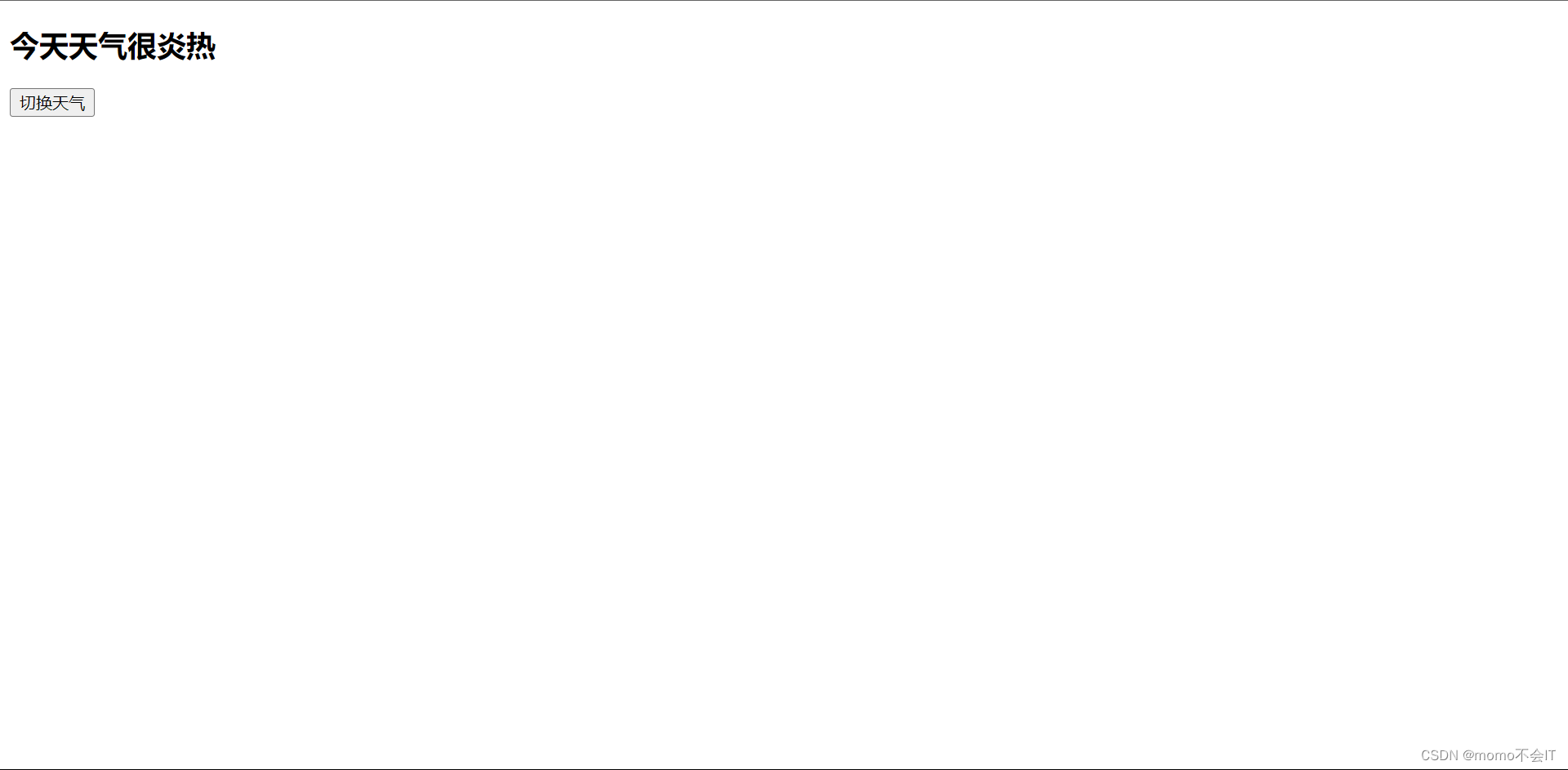
姓名案例_watch实现
<!DOCTYPE html>
<html lang="en">
<head>
<meta charset="UTF-8">
<meta http-equiv="X-UA-Compatible" content="IE=edge">
<meta name="viewport" content="width=device-width, initial-scale=1.0">
<title>姓名案例_watch实现</title>
<script type="text/javascript" src="../js/vue.js"></script>
</head>
<body>
<div id="root">
姓:<input type="text" v-model="firstName"></br></br>
名:<input type="text" v-model="lastName"></br></br>
全名:<span>{
{fullName}}</span></br></br>
</div>
</body>
<script type="text/javascript">
Vue.config.productionTip = false; //阻止 vue 在启动时生成生产提示。
const vm = new Vue({
el:'#root',
data:{
firstName:'张',
lastName:'三',
fullName:'张-三'
},
watch:{
firstName(val){
setInterval(() => { //定时器,延迟4秒出现
this.fullName = val + '-' + this.lastName;
}, 4000);
},
lastName(val){
this.fullName = this.firstName + '-' + val;
}
}
})
</script>
</html>
<!-- 总结 -->
<!--
computed和watch之间的区别:
1.computed能完成的功能,watch也可以完成
2.watch能完成的功能,computed不一定能完成,例如:watch可以进行异步操作
两个重要的小原则:
1.所被Vue管理的函数,最好写成普通函数这样this的指向才是vm 或 组件实例对象
2.所有不被Vue管理的函数(定时器的回调函数,ajax的回调函数,promise的回调函数等),最好写成箭头函数,
这样this的指向才是vm 或组件实例对象
-->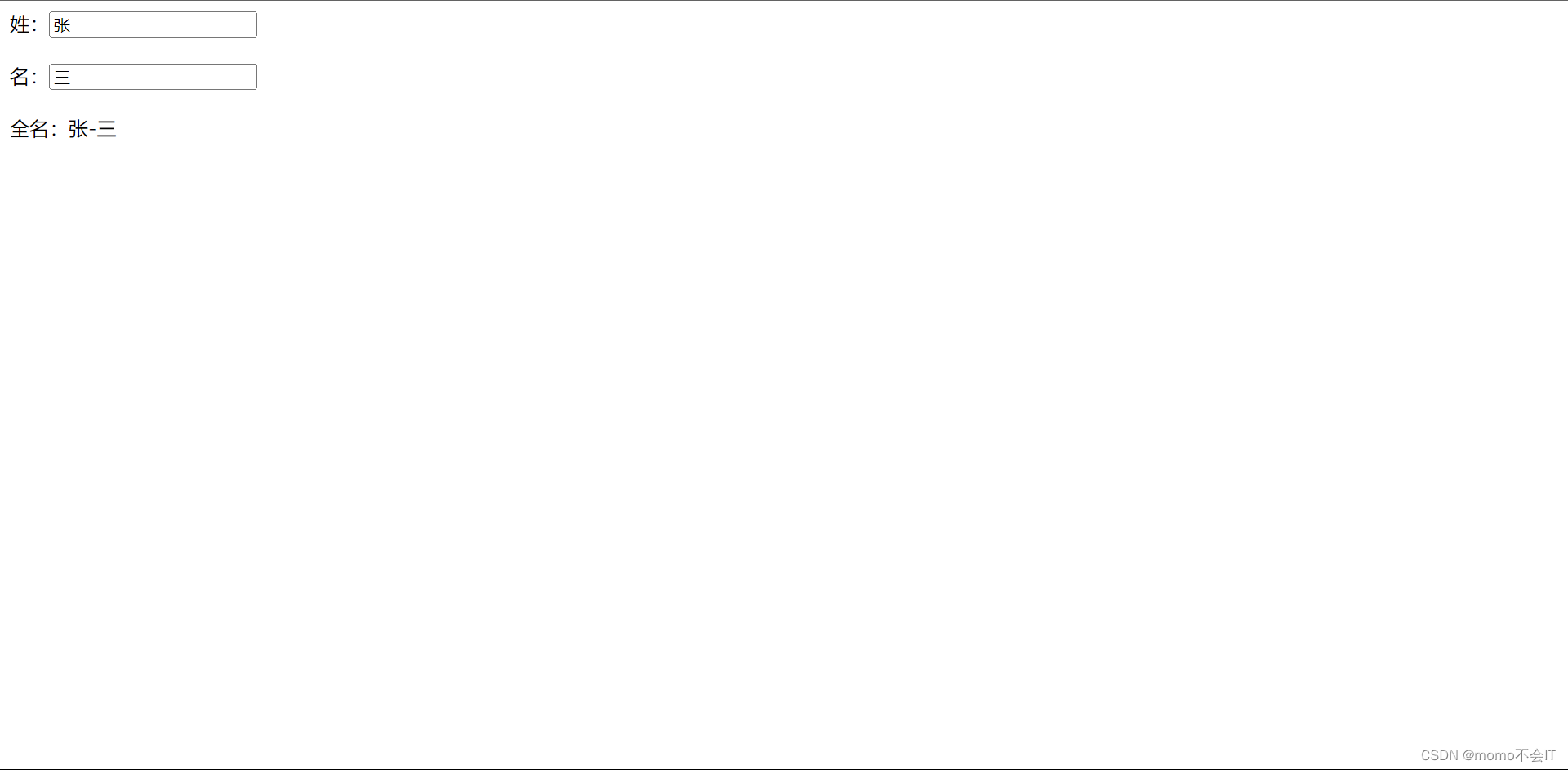
样式绑定
<!DOCTYPE html>
<html lang="en">
<head>
<meta charset="UTF-8">
<meta http-equiv="X-UA-Compatible" content="IE=edge">
<meta name="viewport" content="width=device-width, initial-scale=1.0">
<title>绑定样式</title>
<style>
.basic{
width: 400px;
height: 200px;
border: 1px solid red;
}
.happy{
background-color: plum;
}
.sad{
background-color: gray;
}
.normal{
background-color: skyblue;
}
.e1{
background-color: yellowgreen;
}
.e2{
font-size: 30px;
text-shadow: 2px 2px 10px red;
}
.e3{
border-radius: 20px;
}
</style>
<script type="text/javascript" src="../js/vue.js"></script>
</head>
<body>
<!-- 准备好一个盒子 -->
<div id="root">
<!-- 绑定class样式--字符串写法,适用于:样式的类名不确定,需要动态指定 -->
<div class="basic" :class="mood" @click="changeMood">{
{name}}</div><br/><br/>
<!-- 绑定class样式--数组写法,适用于:要绑定样式个数不确定、名字也不确定 -->
<div class="basic" :class="classArr">{
{name}}</div><br/><br/>
<!-- 绑定class样式--对象写法,适用于:要绑定样式个数确定、名字也确定,但动态决定用不用 -->
<div class="basic" :class="classObj">{
{name}}</div>
<!-- 绑定style样式--对象写法 -->
<div class="basic" :style="styleObj">{
{name}}</div>
<!-- 绑定style样式--数组写法 -->
<div class="basic" :style="styleArr">{
{name}}</div>
</div>
</body>
<script type="text/javascript">
Vue.config.productionTip = false; //阻止 vue 在启动时生成生产提示。
const vm = new Vue({
el:'#root',
data:{
name:'Vue',
mood:'normal',
classArr:['e1','e2','e3'],
classObj:{
e1:true,
e2:false
},
styleObj:{
fontSize:'40px'
},
styleArr:[
{
fontSize:'40px',
color:'red',
},
{
backgroundColor:'yellow',
}
]
},
methods: {
changeMood(){
const arr = ['happy','sad','normal'];
const index = Math.floor(Math.random()*3)
this.mood =arr[index];
}
},
})
</script>
</html>
<!-- 总结 -->
<!--
绑定样式:
1.class样式:
写法:calss="xxx" xxx可以是字符串、对象、数组
字符串写法适用于:类名不确定,要动态获取
对象写法适用于:要绑定多个样式,个数不确定,名字也不确定
数组写法适用于:要绑定多个样式,个数确定,名字也确定,但不确定用不用
2.style样式:
:style="{fontSize: xxx}" 其中xxx是动态值
:style="[a,b]" 其中a、b是样式对象
-->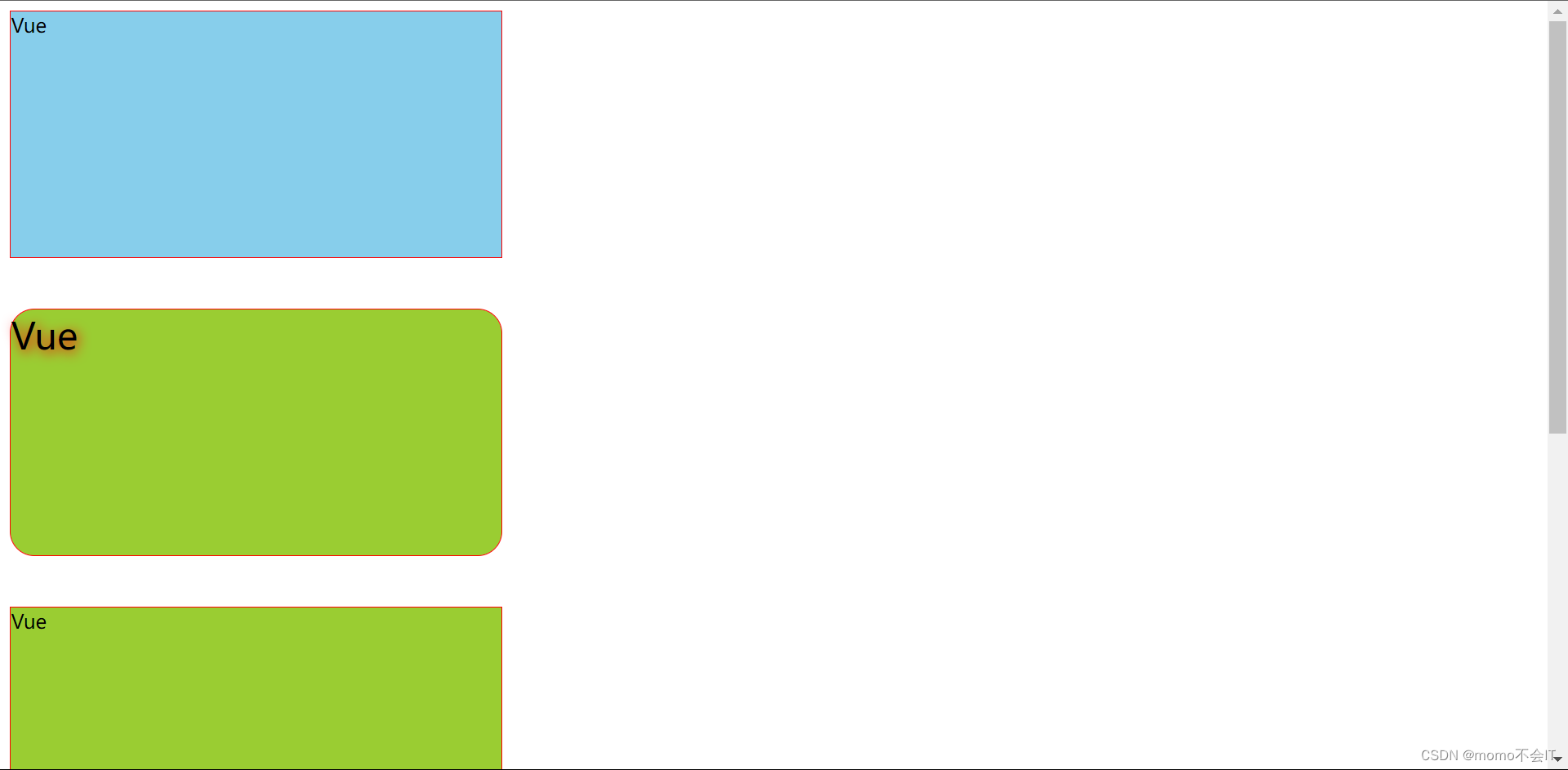
条件渲染
<!DOCTYPE html>
<html lang="en">
<head>
<meta charset="UTF-8">
<meta http-equiv="X-UA-Compatible" content="IE=edge">
<meta name="viewport" content="width=device-width, initial-scale=1.0">
<title>条件渲染</title>
<script type="text/javascript" src="../js/vue.js"></script>
</head>
<body>
<!-- 准备好一个盒子 -->
<div id="root">
<!-- 适用v-show做条件渲染 -->
<!-- <h2 v-show="flase">{
{name}}</h2>
<h2 v-show=" 1 === 1 ">{
{name}}</h2> -->
<!-- 适用v-if做条件渲染 -->
<!-- <h2 v-if="flase">{
{name}}</h2>
<h2 v-if=" 1 === 1 ">{
{name}}</h2> -->
<h2>当前的n值为:{
{n}}</h2>
<button @click="n++">点击n+1</button>
<!-- v-show -->
<!-- <div v-show=" n === 1 ">Angular</div>
<div v-show=" n === 2 ">React</div>
<div v-show=" n === 3 ">Vue</div> -->
<!-- v-if -->
<!-- <div v-if=" n === 1 ">Angular</div>
<div v-if=" n === 2 ">React</div>
<div v-if=" n === 3 ">Vue</div> -->
<!-- v-else-if -->
<!-- <div v-if=" n === 1 ">Angular</div>
<div v-else-if=" n === 2 ">React</div>
<div v-else-if=" n === 3 ">Vue</div> -->
<!-- v-else -->
<!-- <div v-if=" n === 1 ">Angular</div>
<div v-else-if=" n === 2 ">React</div>
<div v-else-if=" n === 3 ">Vue</div>
<div v-else>javascript</div> -->
<!-- v-if与template的配合使用 -->
<template v-if=" n === 1 ">
<h2>1</h2>
<h2>2</h2>
<h2>3</h2>
</template>
</div>
</body>
<script type="text/javascript">
Vue.config.productionTip = false; //阻止 vue 在启动时生成生产提示。
const vm = new Vue({
el:'#root',
data:{
name:'Vue',
n:0,
},
})
</script>
</html>
<!-- 总结 -->
<!--
条件渲染:
1.v-if
写法:
(1)v-if="表达式"
(2)v-else-if="表达式"
(3)v-else="表达式"
适用于:切换频率较低的场景
特点:不展示的DOM元素直接被移除
注意:v-if可以和v-else-if、v-else一起使用,但要求结构不能被"打断 "
2.v-show
写法:v-show="表达式"
适用于:切换频率较高的场景
特点:不展示的DOM元素未被移除,仅仅是使用样式隐藏掉
3.备注:使用v-if时,语速可能无法获取到,而使用v-show一定可以获取到
-->
列表渲染
基本列表
<!DOCTYPE html>
<html lang="en">
<head>
<meta charset="UTF-8">
<meta http-equiv="X-UA-Compatible" content="IE=edge">
<meta name="viewport" content="width=device-width, initial-scale=1.0">
<title>基本列表</title>
<script type="text/javascript" src="../js/vue.js"></script>
</head>
<body>
<!-- 准备好一个盒子 -->
<div id="root">
<!-- 遍历数组 -->
<h2>人员列表(遍历数组)</h2>
<ul>
<li v-for="(p,index) in presonals" :key="p.id"> <!-- <li v-for="p of presonals" :key="p.id"> -->
{
{p.name}}-{
{p.age}}
</li>
</ul>
<!-- 遍历对象 -->
<h2>汽车信息(遍历对象)</h2>
<ul>
<li v-for="(k,value) in car" :key="value">
{
{k}}-{
{value}}
</li>
</ul>
<!-- 遍历字符串 -->
<h2>测试遍历字符串</h2>
<ul>
<li v-for="(char,index) in str" :key="index">
{
{char}}-{
{index}}
</li>
</ul>
<!-- 遍历指定次数 -->
<h2>测试遍历指定次数(用得少)</h2>
<ul>
<li v-for="(number,index) in 5" :key="index">
{
{number}}-{
{index}}
</li>
</ul>
</div>
</body>
<script type="text/javascript">
Vue.config.productionTip = false; //阻止 vue 在启动时生成生产提示。
const vm = new Vue({
el:'#root',
data:{
presonals:[
{id:'001',name:'张三',age:18},
{id:'002',name:'李四',age:19},
{id:'003',name:'王五',age:20}
],
car:{
name:'奥迪',
price:'80w',
color:'black'
},
str:'hello'
},
})
</script>
</html>
<!-- 总结 -->
<!--
v-for指令:
1.用于展示列表数据
2.语法:v-if:"(item,index) in xxx" :key:"yyy"
3.可遍历:数组、对象、字符串(用得很少)、指定次数(用得很少)
-->
key的原理
<!DOCTYPE html>
<html lang="en">
<head>
<meta charset="UTF-8">
<meta http-equiv="X-UA-Compatible" content="IE=edge">
<meta name="viewport" content="width=device-width, initial-scale=1.0">
<title>key的原理</title>
<script type="text/javascript" src="../js/vue.js"></script>
</head>
<body>
<!-- 准备好一个盒子 -->
<div id="root">
<!-- 遍历数组 -->
<h2>人员列表(遍历数组)</h2>
<button @click.once="add">添加一个老刘</button>
<ul>
<li v-for="(p,index) in presonals" :key="p.id"> <!-- <li v-for="p of presonals" :key="p.id"> -->
{
{p.name}}-{
{p.age}}
<input type="text">
</li>
</ul>
</div>
</body>
<script type="text/javascript">
Vue.config.productionTip = false; //阻止 vue 在启动时生成生产提示。
const vm = new Vue({
el:'#root',
data:{
presonals:[
{id:'001',name:'张三',age:18},
{id:'002',name:'李四',age:19},
{id:'003',name:'王五',age:20}
]
},
methods: {
add(){
const p={id:004,name:'老刘',age:40}
this.presonals.unshift(p);
}
},
})
</script>
</html>
<!-- 总结 -->
<!--
面试题:react、Vue中的key、用什么用?(key的内部原理)
1.虚拟DOM中key的作用:
key是虚拟DOM对象的标识,当数据发生变化时,Vue会根据【新数据】生成【新的虚拟DOM】,
随后Vue进行【新虚拟DOM】和【旧虚拟DOM】的差异比较,比较规则如下:
2.对比规则:
(1)旧虚拟DOM中找到了与新虚拟DOM相同的key:
(1)若虚拟DOM中内容没变,直接使用之前的真实DOM!
(2)若虚拟DOM中内容变了,则生成新的真实DOM,随后替换掉页面中之前的真实DOM
(2)旧虚拟DOM中未找到ui新虚拟DOM相同的key
创建新的真实DOM,随货渲染到页面
3.用index作为key可能会引起的问题:
1. 若对数据进行:逆序添加、逆序删除等破坏顺序操作:
会产生没有必要的真实DOM更新==>界面效果没问题,但效率低
2.如果结构中还包含输入类的DOM:
会产生错误DOM更新 ==> 界面有问题
4.开发中如何选择key?
1.最好使用每条数据的唯一标识作为key,比如id、手机号、身份证号、学号等唯一值
2.如果不存在对数据的逆序添加、逆序删除等破坏顺序操作,仅用于渲染列表用于展示,
使用index作为key是没有问题的。
-->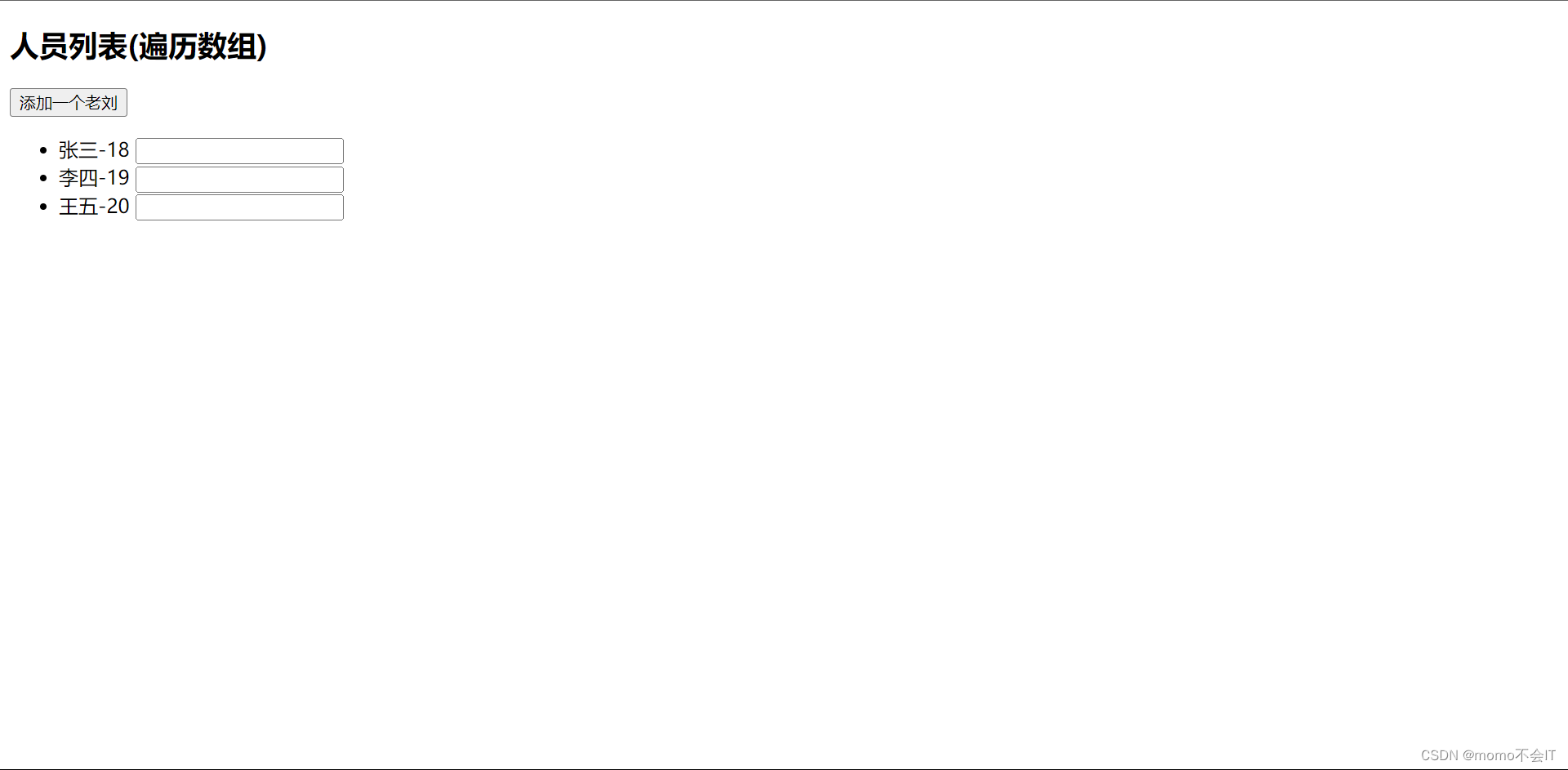
列表过滤
<!DOCTYPE html>
<html lang="en">
<head>
<meta charset="UTF-8">
<meta http-equiv="X-UA-Compatible" content="IE=edge">
<meta name="viewport" content="width=device-width, initial-scale=1.0">
<title>列表过滤</title>
<script type="text/javascript" src="../js/vue.js"></script>
</head>
<body>
<!-- 准备好一个盒子 -->
<div id="root">
<!-- 遍历数组 -->
<h2>人员列表</h2>
<input type="text" placeholder="请输入名字" v-model="keyWord">
<ul>
<li v-for="(p,index) in filPresonals" :key="index">
{
{p.name}}-{
{p.age}}-{
{p.sex}}
</li>
</ul>
</div>
</body>
<script type="text/javascript">
Vue.config.productionTip = false; //阻止 vue 在启动时生成生产提示。
// 用watch实现
// #region
// const vm = new Vue({
// el:'#root',
// data:{
// keyWord:'',
// presonals:[
// {id:'001',name:'马冬梅',age:36,sex:'女'},
// {id:'002',name:'周冬雨',age:30,sex:'女'},
// {id:'003',name:'周杰伦',age:44,sex:'男'},
// {id:'004',name:'温兆伦',age:58,sex:'男'}
// ],
// filPresonals:[],
// },
// watch:{
// keyWord:{
// immediate:true,
// handler(val){
// this.filPresonals = this.presonals.filter((p)=>{
// return p.name.indexOf(val) !== -1;
// })
// }
// }
// }
// })
// #endregion
// // 用computed实现
const vm = new Vue({
el:'#root',
data:{
keyWord:'',
presonals:[
{id:'001',name:'马冬梅',age:36,sex:'女'},
{id:'002',name:'周冬雨',age:30,sex:'女'},
{id:'003',name:'周杰伦',age:44,sex:'男'},
{id:'004',name:'温兆伦',age:58,sex:'男'}
],
},
computed:{
filPresonals(){
return this.presonals.filter((p)=>{ //filter过滤器
return p.name.indexOf(this.keyWord) !== -1
})
}
}
})
</script>
</html>
列表排序
<!DOCTYPE html>
<html lang="en">
<head>
<meta charset="UTF-8">
<meta http-equiv="X-UA-Compatible" content="IE=edge">
<meta name="viewport" content="width=device-width, initial-scale=1.0">
<title>列表排序</title>
<script type="text/javascript" src="../js/vue.js"></script>
</head>
<body>
<!-- 准备好一个盒子 -->
<div id="root">
<!-- 遍历数组 -->
<h2>人员列表</h2>
<input type="text" placeholder="请输入名字" v-model="keyWord">
<button @click="sortType = 2">年龄升序</button>
<button @click="sortType = 1">年龄降序</button>
<button @click="sortType = 0">原顺序</button>
<ul>
<li v-for="(p,index) in filPresonals" :key="p.id"> <!-- <li v-for="p of filPresonals" :key="p.id"> -->
{
{p.name}}-{
{p.age}}-{
{p.sex}} <input type="text">
</li>
</ul>
</div>
</body>
<script type="text/javascript">
Vue.config.productionTip = false; //阻止 vue 在启动时生成生产提示。
// 用watch实现
// #region
// const vm = new Vue({
// el:'#root',
// data:{
// keyWord:'',
// presonals:[
// {id:'001',name:'马冬梅',age:36,sex:'女'},
// {id:'002',name:'周冬雨',age:30,sex:'女'},
// {id:'003',name:'周杰伦',age:44,sex:'男'},
// {id:'004',name:'温兆伦',age:58,sex:'男'}
// ],
// filPresonals:[],
// },
// watch:{
// keyWord:{
// immediate:true,
// handler(val){
// this.filPresonals = this.presonals.filter((p)=>{
// return p.name.indexOf(val) !== -1;
// })
// }
// }
// }
// })
// #endregion
// // 用computed实现
const vm = new Vue({
el:'#root',
data:{
keyWord:'',
sortType:'0',//0原序,1降序,2升序
presonals:[
{id:'001',name:'马冬梅',age:36,sex:'女'},
{id:'002',name:'周冬雨',age:30,sex:'女'},
{id:'003',name:'周杰伦',age:44,sex:'男'},
{id:'004',name:'温兆伦',age:58,sex:'男'}
]
},
computed:{
filPresonals(){
const arr = this.presonals.filter((p)=>{ //filter()过滤器
return p.name.indexOf(this.keyWord) !== -1
})
if(this.sortType){
arr.sort((p1,p2)=>{ //sort()用来排序的函数
return this.sortType === 1 ? p2.age-p1.age : p1.age-p2.age
})
}
return arr;
}
}
})
</script>
</html>
更新时的一个问题
<!DOCTYPE html>
<html lang="en">
<head>
<meta charset="UTF-8">
<meta http-equiv="X-UA-Compatible" content="IE=edge">
<meta name="viewport" content="width=device-width, initial-scale=1.0">
<title>更新时的一个问题</title>
<script type="text/javascript" src="../js/vue.js"></script>
</head>
<body>
<!-- 准备好一个盒子 -->
<div id="root">
<ul>
<button @click="updataMei">点击修改马冬梅的信息</button>
<li v-for="(p,index) in presonals" :key="p.id"> <!-- <li v-for="p of presonals" :key="p.id"> -->
{
{p.name}}-{
{p.age}}-{
{p.sex}} <input type="text">
</li>
</ul>
</div>
</body>
<script type="text/javascript">
Vue.config.productionTip = false; //阻止 vue 在启动时生成生产提示。
const vm = new Vue({
el:'#root',
data:{
presonals:[
{id:'001',name:'马冬梅',age:36,sex:'女'},
{id:'002',name:'周冬雨',age:30,sex:'女'},
{id:'003',name:'周杰伦',age:44,sex:'男'},
{id:'004',name:'温兆伦',age:58,sex:'男'}
]
},
methods: {
updataMei(){
// this.presonals[0].name = 'momo',//奏效
// this.presonals[0].age = 22,//奏效
// this.presonals[0].sex = '男'//奏效
// this.presonals[0] = {id:'001',name:'momo',age:22,sex:'男'} //不奏效
this.presonals.splice(0,1,{id:'001',name:'momo',age:22,sex:'男'})
}
},
})
</script>
</html>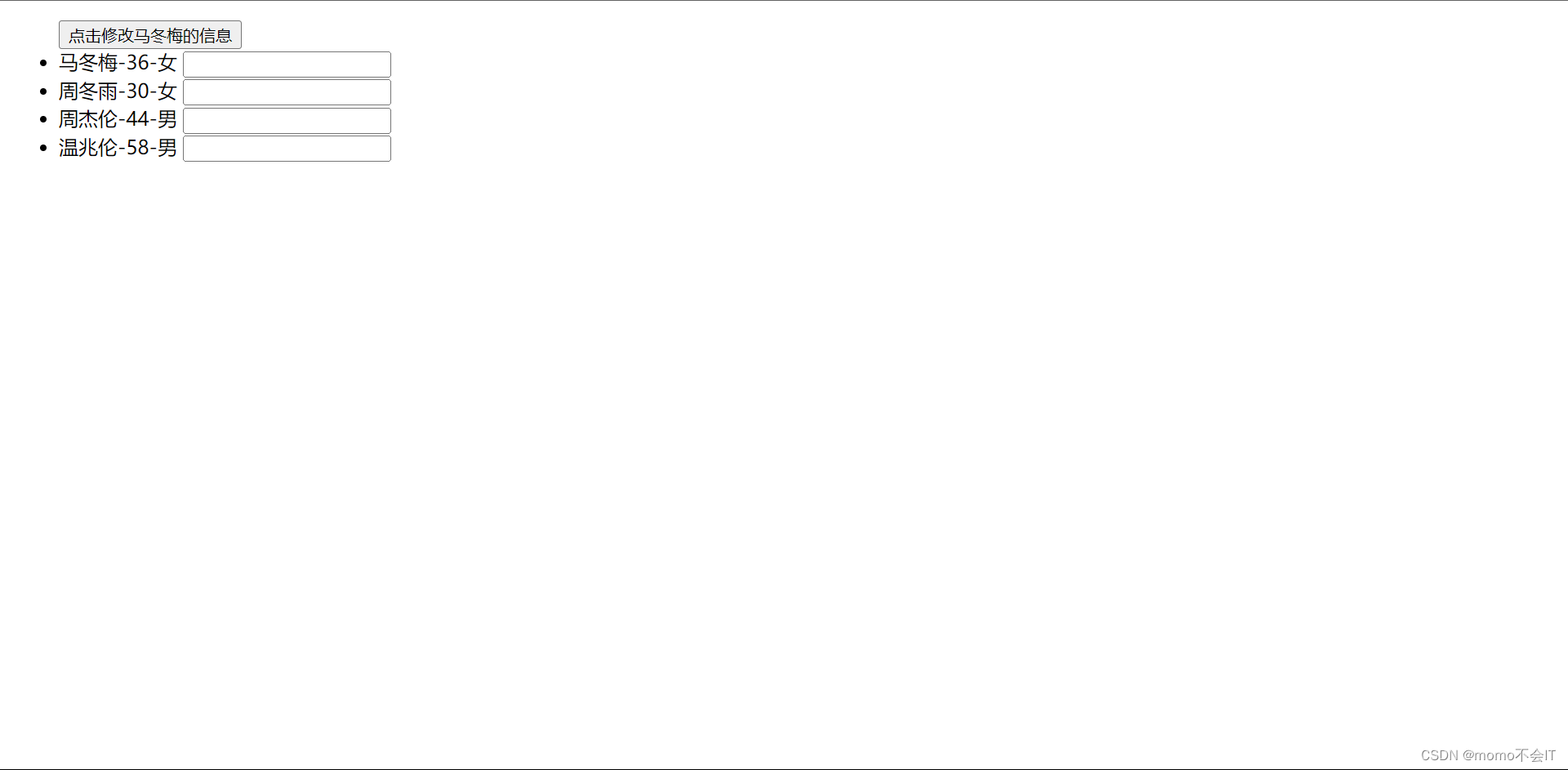
Vue检测数据改变的原理
<!DOCTYPE html>
<html lang="en">
<head>
<meta charset="UTF-8">
<meta http-equiv="X-UA-Compatible" content="IE=edge">
<meta name="viewport" content="width=device-width, initial-scale=1.0">
<title>Vue检测数据改变的原理</title>
<script type="text/javascript" src="../js/vue.js"></script>
</head>
<body>
<!-- 准备好一个盒子 -->
<div id="root">
<ul>
<button @click="updataMei">点击修改马冬梅的信息</button>
<li v-for="(p,index) in presonals" :key="p.id"> <!-- <li v-for="p of presonals" :key="p.id"> -->
{
{p.name}}-{
{p.age}}-{
{p.sex}} <input type="text">
</li>
</ul>
</div>
</body>
<script type="text/javascript">
Vue.config.productionTip = false; //阻止 vue 在启动时生成生产提示。
const vm = new Vue({
el:'#root',
data:{
presonals:[
{id:'001',name:'马冬梅',age:36,sex:'女'},
{id:'002',name:'周冬雨',age:30,sex:'女'},
{id:'003',name:'周杰伦',age:44,sex:'男'},
{id:'004',name:'温兆伦',age:58,sex:'男'}
]
},
methods: {
updataMei(){
// this.presonals[0].name = 'momo',//奏效
// this.presonals[0].age = 22,//奏效
// this.presonals[0].sex = '男'//奏效
this.presonals[0] = {id:'001',name:'momo',age:22,sex:'男'}
}
},
})
</script>
</html>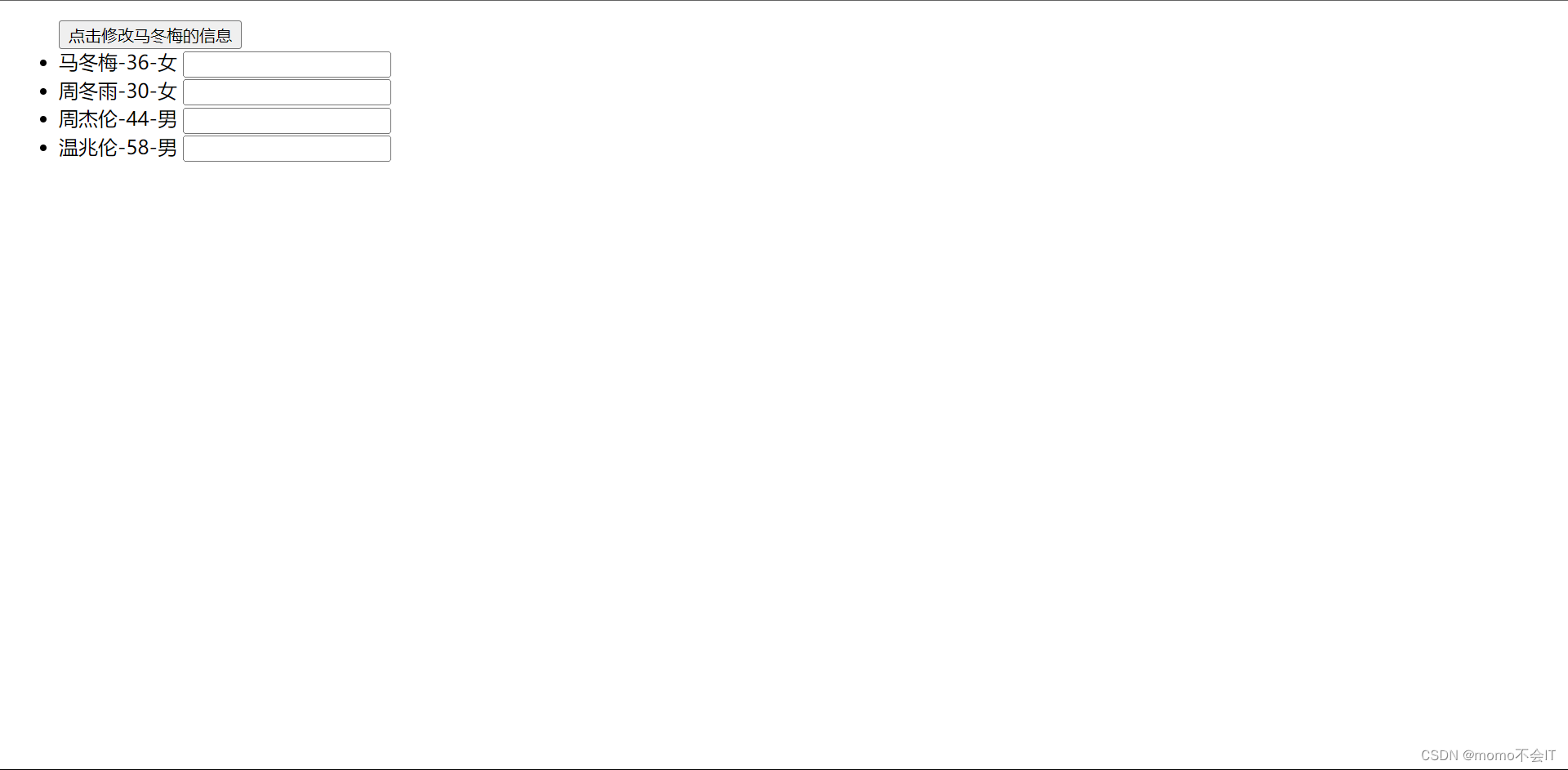
模拟一个数据检测
<!DOCTYPE html>
<html lang="en">
<head>
<meta charset="UTF-8">
<meta http-equiv="X-UA-Compatible" content="IE=edge">
<meta name="viewport" content="width=device-width, initial-scale=1.0">
<title>模拟一个数据检测</title>
<script type="text/javascript" src="../js/vue.js"></script>
</head>
<body>
<!-- 准备好一个盒子 -->
<div id="root">
<ul>
<button @click="updataMei">点击修改马冬梅的信息</button>
<li v-for="(p,index) in presonals" :key="p.id"> <!-- <li v-for="p of presonals" :key="p.id"> -->
{
{p.name}}-{
{p.age}}-{
{p.sex}} <input type="text">
</li>
</ul>
</div>
</body>
<script type="text/javascript">
Vue.config.productionTip = false; //阻止 vue 在启动时生成生产提示。
const vm = new Vue({
el:'#root',
data:{
presonals:[
{id:'001',name:'马冬梅',age:36,sex:'女'},
{id:'002',name:'周冬雨',age:30,sex:'女'},
{id:'003',name:'周杰伦',age:44,sex:'男'},
{id:'004',name:'温兆伦',age:58,sex:'男'}
]
},
methods: {
updataMei(){
// this.presonals[0].name = 'momo',//奏效
// this.presonals[0].age = 22,//奏效
// this.presonals[0].sex = '男'//奏效
this.presonals[0] = {id:'001',name:'momo',age:22,sex:'男'}
}
},
})
</script>
</html>
Vue.set的应用
<!DOCTYPE html>
<html lang="en">
<head>
<meta charset="UTF-8">
<meta http-equiv="X-UA-Compatible" content="IE=edge">
<meta name="viewport" content="width=device-width, initial-scale=1.0">
<title>Vue.set的应用</title>
<script type="text/javascript" src="../js/vue.js"></script>
</head>
<body>
<!-- 准备好一个盒子 -->
<div id="root">
<h1>学习内容</h1>
<h2>{
{name}}学习</h2>
<h2>{
{days}}</h2>
<h1>学生基本信息</h1>
<button @click="addSex">点击添加性别,默认为男</button>
<h2>姓名:{
{student.studentName}}</h2>
<h2 v-if="student.sex">性别:{
{student.sex}}</h2>
<h2>年龄(对外):{
{student.age.sAge}}</h2>
<h2>年龄(真实):{
{student.age.rAge}}</h2>
<h1>朋友们:</h1>
<ul>
<li v-for="(f,index) in student.friend" ::key="index">
{
{f.fName}}-{
{f.age}}
</li>
</ul>
</div>
</body>
<script type="text/javascript">
Vue.config.productionTip = false; //阻止 vue 在启动时生成生产提示。
const vm = new Vue({
el:'#root',
data:{
name:'Vue',
days:'all day',
student:{
studentName:'momo',
age:{
rAge:22,
sAge:21
},
friend:[
{fName:'jojo',age:21},
{fName:'maomao',age:22}
]
}
},
methods: {
addSex(){
// Vue.set(this.student,'sex','男')
this.$set(this.student,'sex','男')
}
},
})
</script>
</html>
Vue检测数据改变的原理_数组
<!DOCTYPE html>
<html lang="en">
<head>
<meta charset="UTF-8">
<meta http-equiv="X-UA-Compatible" content="IE=edge">
<meta name="viewport" content="width=device-width, initial-scale=1.0">
<title>Vue检测数据改变的原理_数组</title>
<script type="text/javascript" src="../js/vue.js"></script>
</head>
<body>
<!-- 准备好一个盒子 -->
<div id="root">
<h1>学习内容</h1>
<h2>{
{name}}学习</h2>
<h2>{
{days}}</h2>
<h1>学生基本信息</h1>
<button @click="addSex">点击添加性别,默认为男</button>
<h2>姓名:{
{student.studentName}}</h2>
<h2 v-if="student.sex">性别:{
{student.sex}}</h2>
<h2>年龄(对外):{
{student.age.sAge}}</h2>
<h2>年龄(真实):{
{student.age.rAge}}</h2>
<h1>朋友们:</h1>
<ul>
<li v-for="(f,index) in student.friend" ::key="index">
{
{f.fName}}-{
{f.age}}
</li>
</ul>
</div>
</body>
<script type="text/javascript">
Vue.config.productionTip = false; //阻止 vue 在启动时生成生产提示。
const vm = new Vue({
el:'#root',
data:{
name:'Vue',
days:'all day',
student:{
studentName:'momo',
age:{
rAge:22,
sAge:21
},
friend:[
{fName:'jojo',age:21},
{fName:'maomao',age:22}
]
}
},
methods: {
addSex(){
// Vue.set(this.student,'sex','男')
this.$set(this.student,'sex','男')
}
},
})
</script>
</html>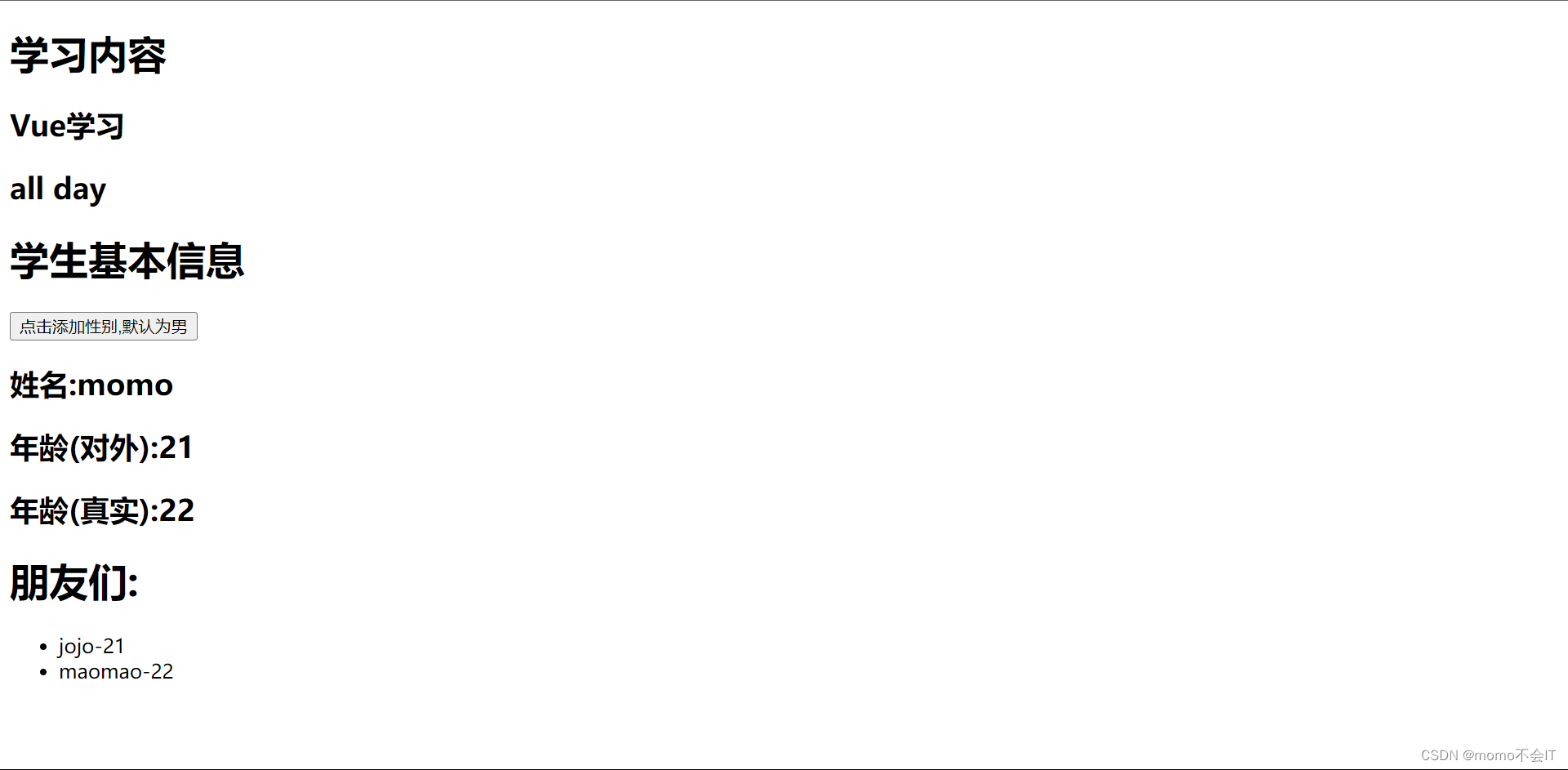
总结Vue数据监测
<!DOCTYPE html>
<html lang="en">
<head>
<meta charset="UTF-8">
<meta http-equiv="X-UA-Compatible" content="IE=edge">
<meta name="viewport" content="width=device-width, initial-scale=1.0">
<title>总结Vue数据监测</title>
<script type="text/javascript" src="../js/vue.js"></script>
</head>
<body>
<!-- 准备好一个盒子 -->
<div id="root">
<h1>学习内容</h1>
<h2>{
{name}}学习</h2>
<h2>{
{days}}</h2>
<h1>学生基本信息</h1>
<button @click="student.age.rAge++,student.age.sAge++">年龄+1</button><br/>
<button @click="addSex">点击添加性别,默认为男</button><br/>
<button @click=" student.sex = '女' ">点击修改性别,女</button><br/>
<button @click="addFriend">在列表首位添加一位朋友</button><br/>
<button @click="updateFirstFriendName">修改第一个朋友的名字为:张三</button><br/>
<button @click="addHobby">添加一个爱好</button><br/>
<button @click="updaFirstHobby">修改第一个爱好为:开车</button><br/>
<h2>姓名:{
{student.studentName}}</h2>
<h2 v-if="student.sex">性别:{
{student.sex}}</h2>
<h2>年龄(对外):{
{student.age.sAge}}</h2>
<h2>年龄(真实):{
{student.age.rAge}}</h2>
<h1>朋友们:</h1>
<ul>
<li v-for="(f,index) in student.friend" ::key="index">
{
{f.fName}}-{
{f.age}}
</li>
</ul>
<h1>爱好:</h1>
<ul>
<li v-for="(h,index) in student.hobby" ::key="index">
{
{h}}
</li>
</ul>
</div>
</body>
<script type="text/javascript">
Vue.config.productionTip = false; //阻止 vue 在启动时生成生产提示。
const vm = new Vue({
el:'#root',
data:{
name:'Vue',
days:'all day',
student:{
studentName:'momo',
age:{
rAge:22,
sAge:21
},
friend:[
{fName:'jojo',age:21},
{fName:'maomao',age:22}
],
hobby:['抽烟','喝酒','烫头']
}
},
methods: {
addSex(){
// Vue.set(this.student,'sex','男')
this.$set(this.student,'sex','男')
},
addFriend(){
this.student.friend.unshift({fName:'bobo',age:22})
},
updateFirstFriendName(){
this.student.friend[0].fName = 'popo'
this.student.friend[0].age = 60
},
addHobby(){
this.student.hobby.push('打代码')
},
updaFirstHobby(){
// this.student.hobby.splice(0,1,'开车')
// Vue.set(this.student.hobby,0,'开车')
this.$set(this.student.hobby,0,'开车')
}
},
})
</script>
</html>
<!-- 总结 -->
<!--
Vue检测数据的原理:
1.Vue会监视data中所有层次的数据
2.如何检测对象中的数据?
通过setter实现监视,且要在new Vue时就传入要监测的数据。
(1)对象中后追加的属性,Vue默认不做响应式处理
(2)如需给后添加的属性做响应式,请使用一下API:
Vue.set(target.propertyName/index,value)或
this.$set(target.propertyName/index,value)
3.如何检测数组中的数据?
通过包裹数组更新元素的方法实现,本质就是做了两件事:
(1)调用原生对应的方法对数组进行更新。
(2)重新解析模板,进而更新页面。
4.在Vue修改数组中的某个元素一定要用如下方法:
1.使用这些API:push()、pop()、shift()、unshift()、splice()、sort()、reverse()
2.Vue.set() 或 vm.$set()
特别注意:Vue.set() 和 vm.$set() 不能给vm 或 vm的根数据对象 添加属性!!!
-->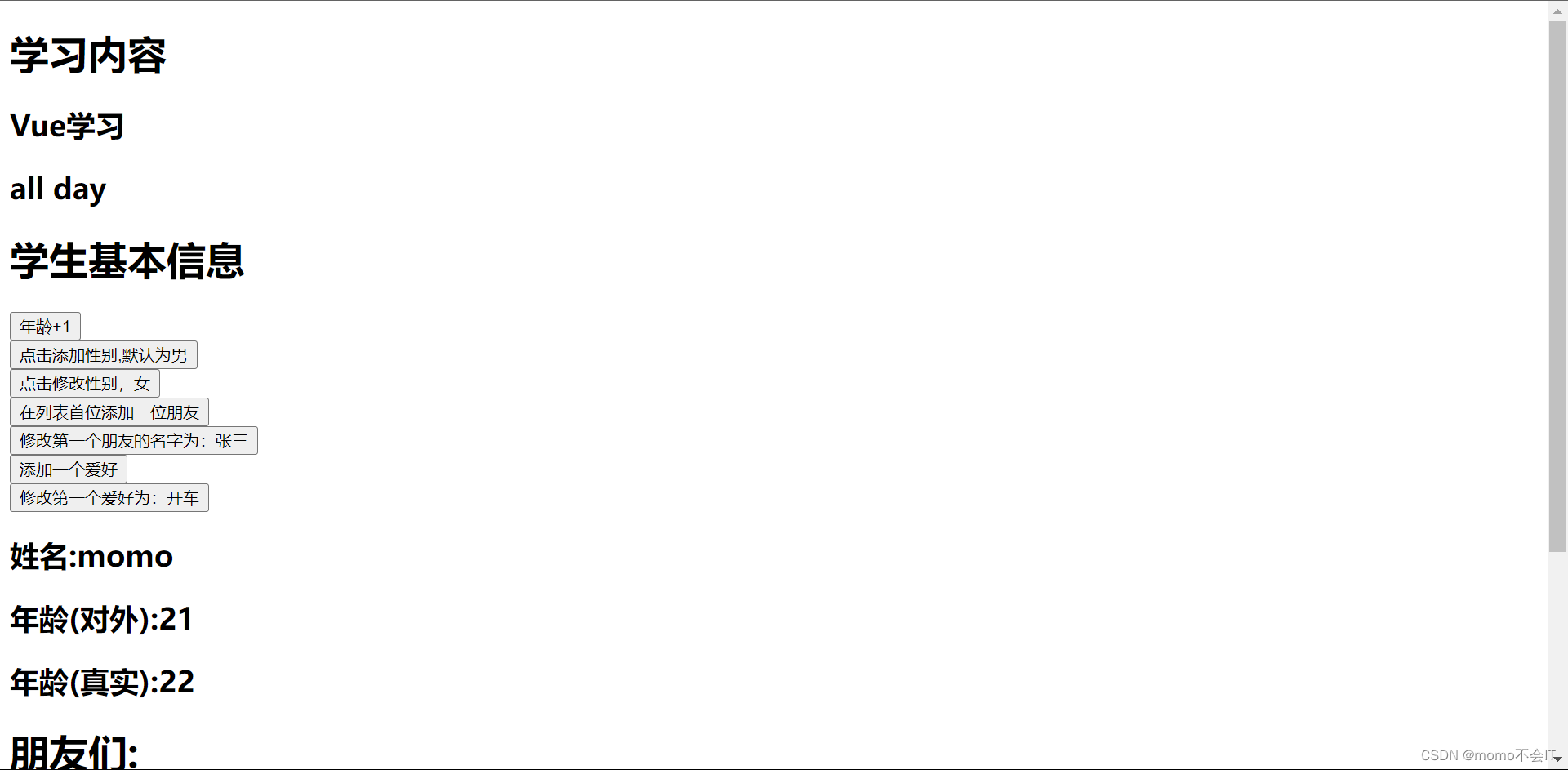
收集表单数据
<!DOCTYPE html>
<html lang="en">
<head>
<meta charset="UTF-8">
<meta http-equiv="X-UA-Compatible" content="IE=edge">
<meta name="viewport" content="width=device-width, initial-scale=1.0">
<title>收集表单数据</title>
<script type="text/javascript" src="../js/vue.js"></script>
</head>
<body>
<!-- 准备好一个盒子 -->
<div id="root">
<form @submit.prevent="demo">
<label>账号:<input type="text" v-model.trim="userInfo.account"></label><br/><br/>
<label>密码:<input type="password" v-model="userInfo.password"></label><br/><br/>
<label>年龄:<input type="number" v-model.number="userInfo.age"></label><br/><br/>
<form action="" method="post" name="formName">
性别:<input type="radio" name="sex" checked v-model="userInfo.sex" value="女">女
<input type="radio" name="sex" checked v-model="userInfo.sex" value="男">男
<button type="reset">重置</button>
<form action="" method="post" name="formName"><br/><br/><br/>
爱好:<input type="checkbox" name="hobby" v-model="userInfo.hobby" value="抽烟">抽烟
<input type="checkbox" name="hobby" v-model="userInfo.hobby" value="喝酒">喝酒
<input type="checkbox" name="hobby" v-model="userInfo.hobby" value="烫头">烫头
</form>
所属校区
<select v-model="userInfo.city">
<option>请选择校区</option>
<option>西校区</option>
<option>北校区</option>
</select><br/><br/><br/>
其他信息:
<textarea v-model.lazy="userInfo.other"></textarea><br/><br/><br/>
<input type="checkbox" v-model="userInfo.agree">阅读并接受<a href="http://www.baidu.com">《用户协议》</a><br/><br/><br/>
<button>提交</button>
<h1>{
{userInfo.name}}学习</h1>
</form>
</div>
</body>
<script type="text/javascript">
Vue.config.productionTip = false; //阻止 vue 在启动时生成生产提示。
const vm = new Vue({
el:'#root',
data:{
userInfo:{
name:'Vue',
account:'',
password:'',
age:'',
sex:'女',
hobby:[],
city:'',
other:'',
agree:''
}
},
methods: {
demo(){
console.log(JSON.stringify(this.userInfo))
}
},
})
</script>
</html>
<!-- 总结 -->
<!--
收集表单数据:
若:<input type="text"/>,则v_model收集的是value值,用户输入的就是value值
若:<input type="radio"/>,则v_model收集的是value值,且要给标签配置value
若:<input type="checked"/>
1.没有配置input的value属性,那么收集的就是checked(勾选 or 未勾选,是布尔值)
2.配置input的value属性:
(1)v-model的初始值是非数组,那么收集的就是checked(勾选 or 未勾选,是布尔值)
(2)v-model的初识值是数组,那么收集的就是value组成的数组
备注:v-model的三个修饰符:
lazy:失去焦点再收集数据
number:输入字符串转为有效数字
trim:输入首位空格过滤
-->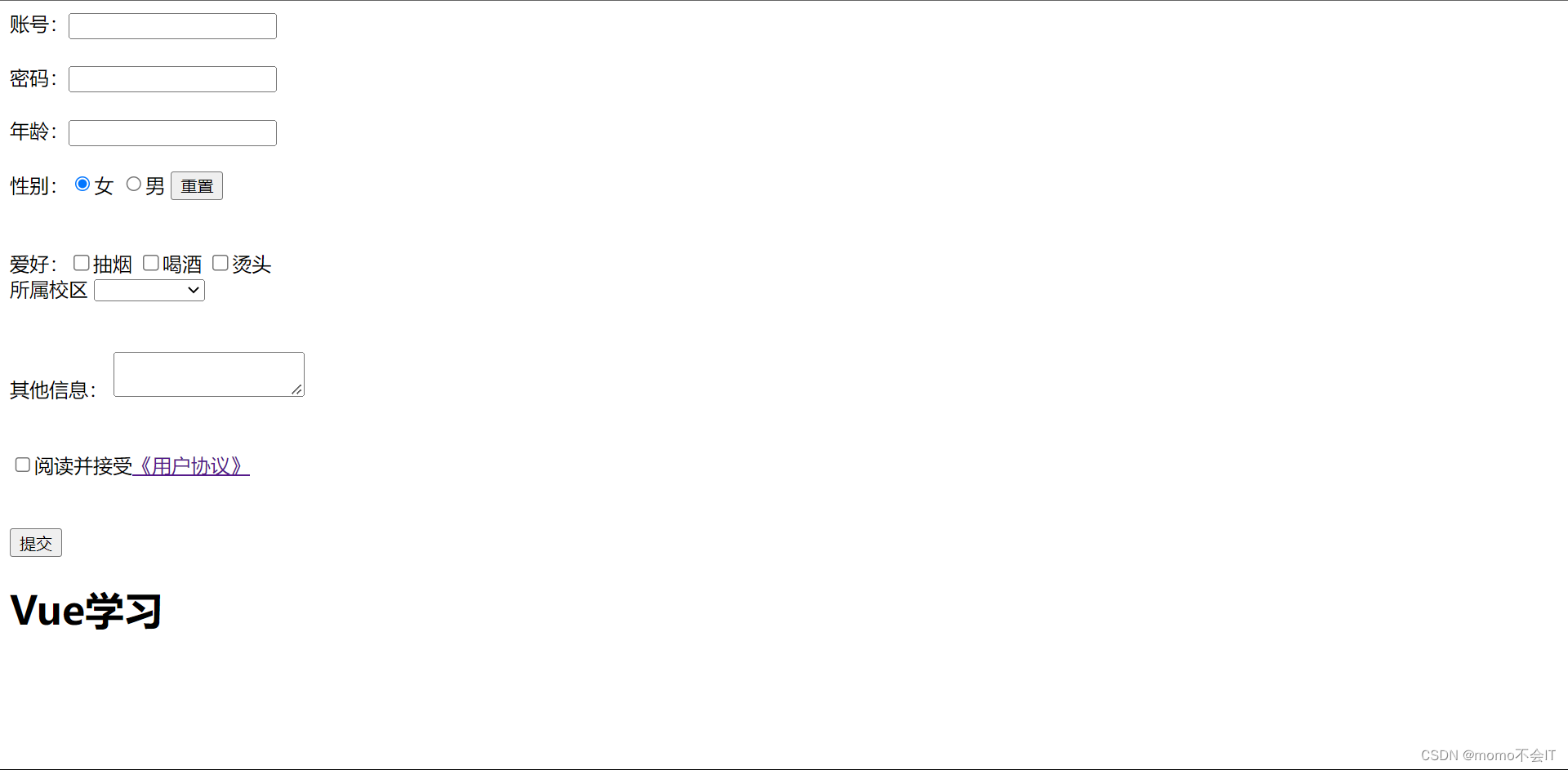
过滤器
<!DOCTYPE html>
<html lang="en">
<head>
<meta charset="UTF-8">
<meta http-equiv="X-UA-Compatible" content="IE=edge">
<meta name="viewport" content="width=device-width, initial-scale=1.0">
<title>过滤器</title>
<script type="text/javascript" src="../js/vue.js"></script>
<script type="text/javascript" src="../js/dayjs.min.js"></script> <!-- 引入dayjs -->
</head>
<body>
<!-- 准备好一个盒子 -->
<div id="root">
<h1>{
{name}}学习</h1>
<h2>显示格式化后的时间</h2>
<!-- 计算属性实现 -->
<h3>现在是:{
{fmtTime}}</h3>
<!-- methods实现 -->
<h3>现在是:{
{getFmtTime()}}</h3>
<!-- 过滤器实现 (传参) -->
<h3>现在是:{
{time | timeFormater}}</h3>
<h3>现在是:{
{time | timeFormater('YYYY-MM-DD')}}</h3>
<h3>现在是:{
{time | timeFormater('YYYY-MM-DD') | mySlice}}</h3>
</div>
</body>
<script type="text/javascript">
Vue.config.productionTip = false; //阻止 vue 在启动时生成生产提示。
// //全局过滤器
// Vue.filter('mySlice',function(value){
// return value.slice(0,4)
// })
const vm = new Vue({
el:'#root',
data:{
name:'Vue',
time:1666175957000, //时间戳
},
computed:{
fmtTime(){
return dayjs(this.time).format('YYYY-MM-DD HH:mm:ss')
}
},
methods: {
getFmtTime(){
return dayjs(this.time).format('YYYY-MM-DD HH:mm:ss')
}
},
//局部过滤器
filters:{
timeFormater(value,str='YYYY-MM-DD HH:mm:ss'){
return dayjs(value).format(str)
},
mySlice(value){
return value.slice(0,4)
}
}
})
</script>
</html>
<!-- 总结 -->
<!--
过滤器:
定义:对要显示的数据进行特定格式化后再显示(适用于一些简单逻辑的处理)
语法:
1.注册过滤器:Vue.filter(name,callback) 或 new Vue{filter:{}}
2.使用过滤器:{
{xxx | 过滤器名(自己起)}} 或 v-bind:属性="xxx | 过滤器名"
备注:
1.过滤器也可以接收额外的参数、多个过滤器可以串联
2.并没有改变原来的数据,是产生新的对应的数据
-->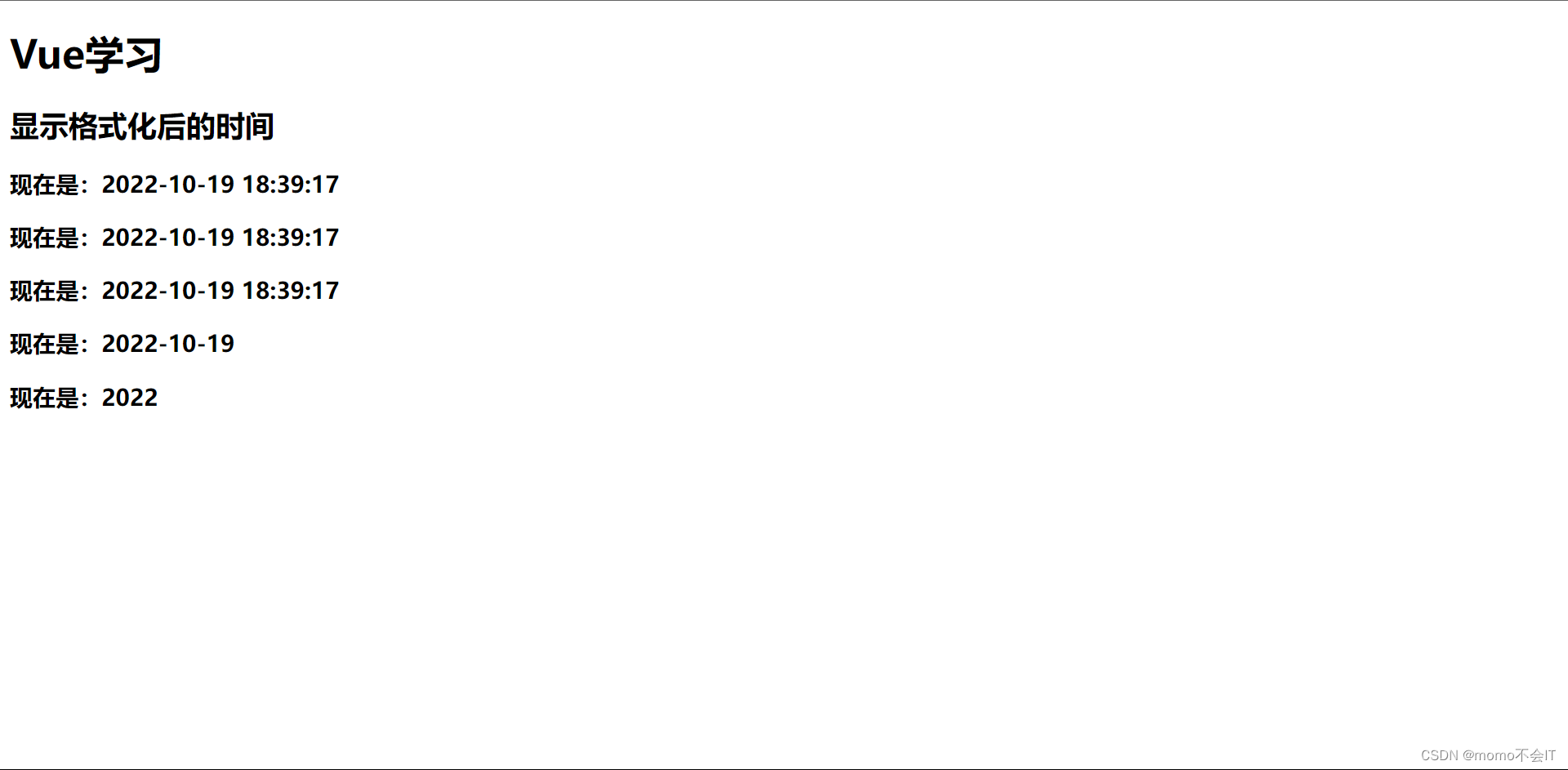
内置指令
text_指令
<!DOCTYPE html>
<html lang="en">
<head>
<meta charset="UTF-8">
<meta http-equiv="X-UA-Compatible" content="IE=edge">
<meta name="viewport" content="width=device-width, initial-scale=1.0">
<title>v-text_指令</title>
<script type="text/javascript" src="../js/vue.js"></script>
</head>
<body>
<!-- 准备好一个盒子 -->
<div id="root">
<h1>{
{name}}学习</h1>
<div v-text="name"></div>
</div>
</body>
<script type="text/javascript">
Vue.config.productionTip = false; //阻止 vue 在启动时生成生产提示。
const vm = new Vue({
el:'#root',
data:{
name:'Vue',
},
})
</script>
</html>
<!--
我们学过的指令:
v-bin:单向绑定数据,可简写为 :xxx
v-model: 双向数据绑定
v-for : 遍历数组/对象/字符串
v-on : 绑定事件监听,可简写为@
v-if : 条件渲染(动态控制节点是否存在)
v-else : 条件渲染(动态控制节点是否存在)
v-show : 条件渲染(动态控制节点是否展示)
v-text指令:
1.作用:向其所在的节点中渲染文本内容
2.与插值语法的区别:v-text会替换掉节点中的内容,{
{xxx}}则不会
-->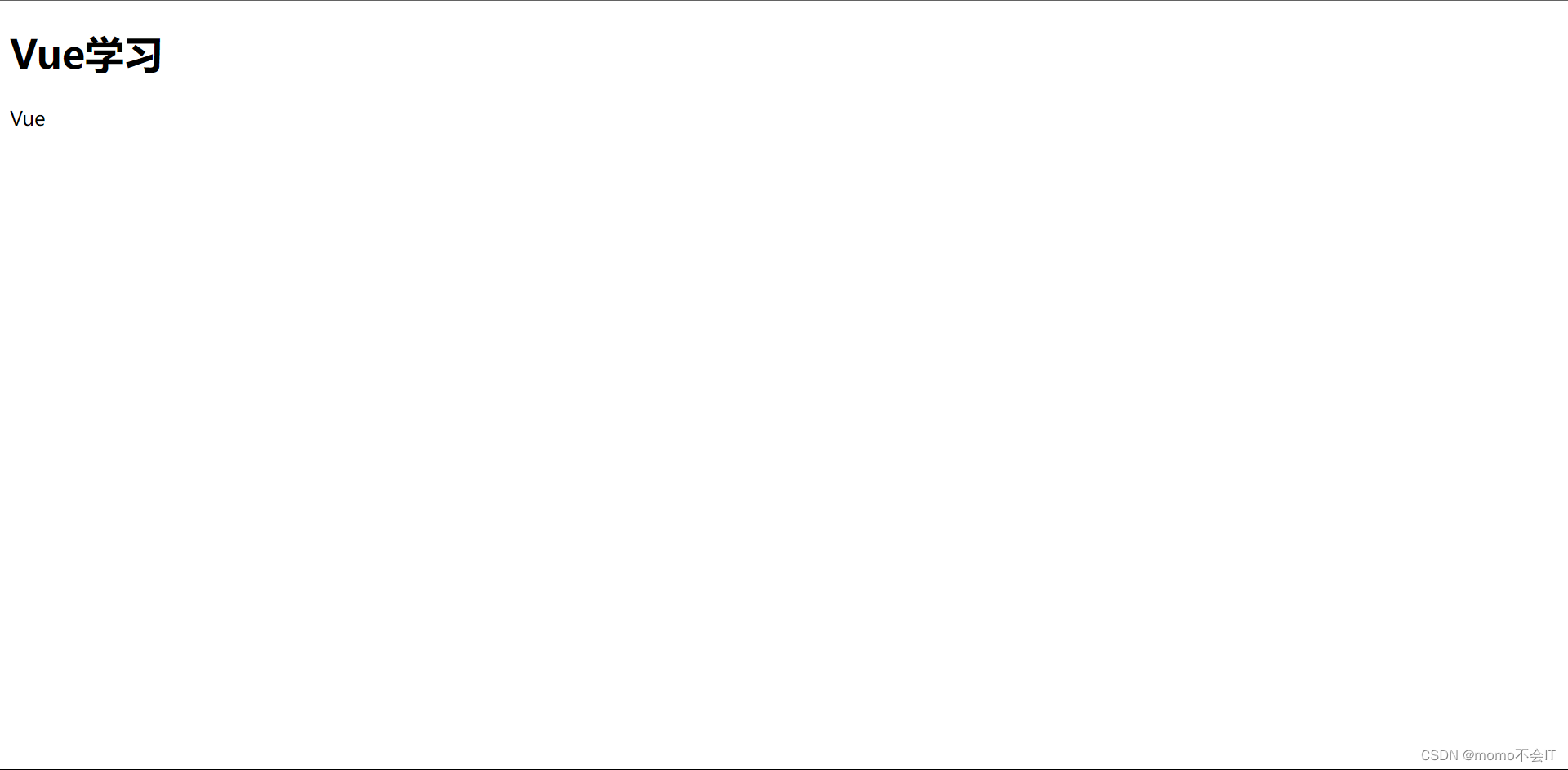
v-html_指令
<!DOCTYPE html>
<html lang="en">
<head>
<meta charset="UTF-8">
<meta http-equiv="X-UA-Compatible" content="IE=edge">
<meta name="viewport" content="width=device-width, initial-scale=1.0">
<title>v-html_指令</title>
<script type="text/javascript" src="../js/vue.js"></script>
</head>
<body>
<!-- 准备好一个盒子 -->
<div id="root">
<h1>{
{name}}学习</h1>
<div v-text="name"></div>
<div v-text="srt"></div> <!-- //v-text不支持结构的解析 v-html支持结构解析 -->
<div v-html="srt">132</div>
</div>
</body>
<script type="text/javascript">
Vue.config.productionTip = false; //阻止 vue 在启动时生成生产提示。
const vm = new Vue({
el:'#root',
data:{
name:'Vue',
srt:'<h3>Vue</h3>'
},
})
</script>
</html>
<!-- 总结 -->
<!--
v-html指令:
1.作用:向指定节点中渲染包含html结构的内容
2.与插值语法的区别:
1.v-html会替换掉节点的所有内容,{
{xxx}}则不会
2.v-html可以识别html结构
3.严重注意:v-html有安全性问题!!!
(1)在网站上动态渲染任意HTML是非常危险的,容易导致XSS攻击
(2)一定要在可信的内容上使用v-html,永不要用在用户提交的内容上
获取cookie进行登录
-->
v-cloak_指令
<!DOCTYPE html>
<html lang="en">
<head>
<meta charset="UTF-8">
<meta http-equiv="X-UA-Compatible" content="IE=edge">
<meta name="viewport" content="width=device-width, initial-scale=1.0">
<title>v-cloak_指令</title>
</head>
<body>
<!-- 准备好一个盒子 -->
<div id="root">
<h1 v-cloak>{
{name}}学习</h1>
</div>
<script type="text/javascript" src="http://localhost:8080/resource/5s/vue.js"></script>
</body>
<script type="text/javascript">
Vue.config.productionTip = false; //阻止 vue 在启动时生成生产提示。
const vm = new Vue({
el:'#root',
data:{
name:'Vue',
},
})
</script>
</html>
<!-- 总结 -->
<!--
v-cloak指令(没有值):
1.本质是一个特殊属性,Vue实例创建完毕并接管容器后,会删除v-cloak属性
2.使用css配合v-cloak可以解决网速慢时页面展现出{
{xxx}}的问题
-->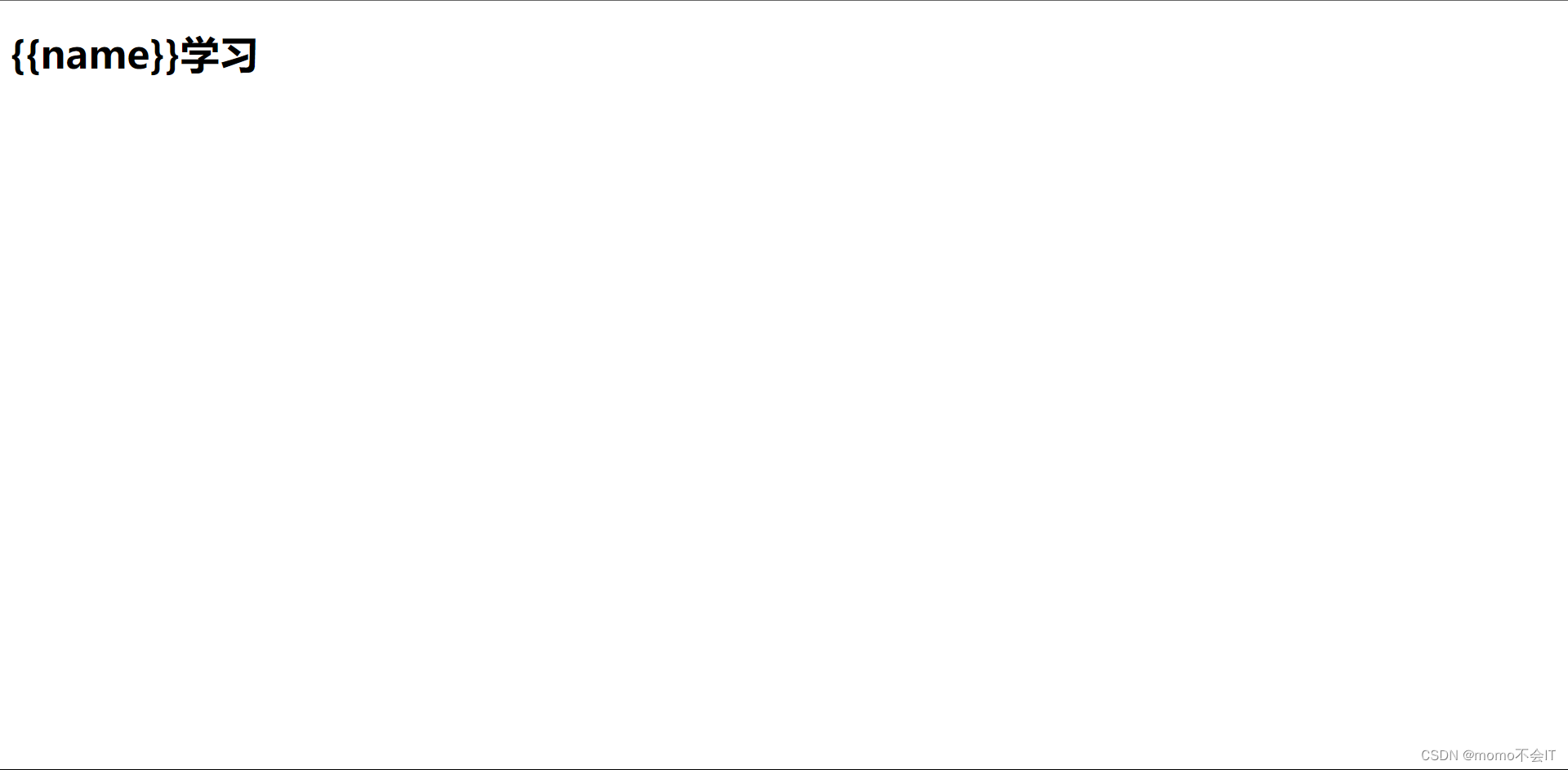
v-once_指令
<!DOCTYPE html>
<html lang="en">
<head>
<meta charset="UTF-8">
<meta http-equiv="X-UA-Compatible" content="IE=edge">
<meta name="viewport" content="width=device-width, initial-scale=1.0">
<title>v-once_指令</title>
<script type="text/javascript" src="../js/vue.js"></script>
</head>
<body>
<!-- 准备好一个盒子 -->
<div id="root">
<h1 v-once>初始化n的值是:{
{n}}</h1>
<h1>当前n的值是:{
{n}}</h1>
<button @click="n++">点我n+1</button>
</div>
</body>
<script type="text/javascript">
Vue.config.productionTip = false; //阻止 vue 在启动时生成生产提示。
const vm = new Vue({
el:'#root',
data:{
n:1
},
})
</script>
</html>
<!-- 总结 -->
<!--
v-once指令:
1.v-once所在节点在初次动态渲染后,就视为静态内容了
2.以后数据的改变不会引起v-once所在结构的更新,可以用于优化性能
-->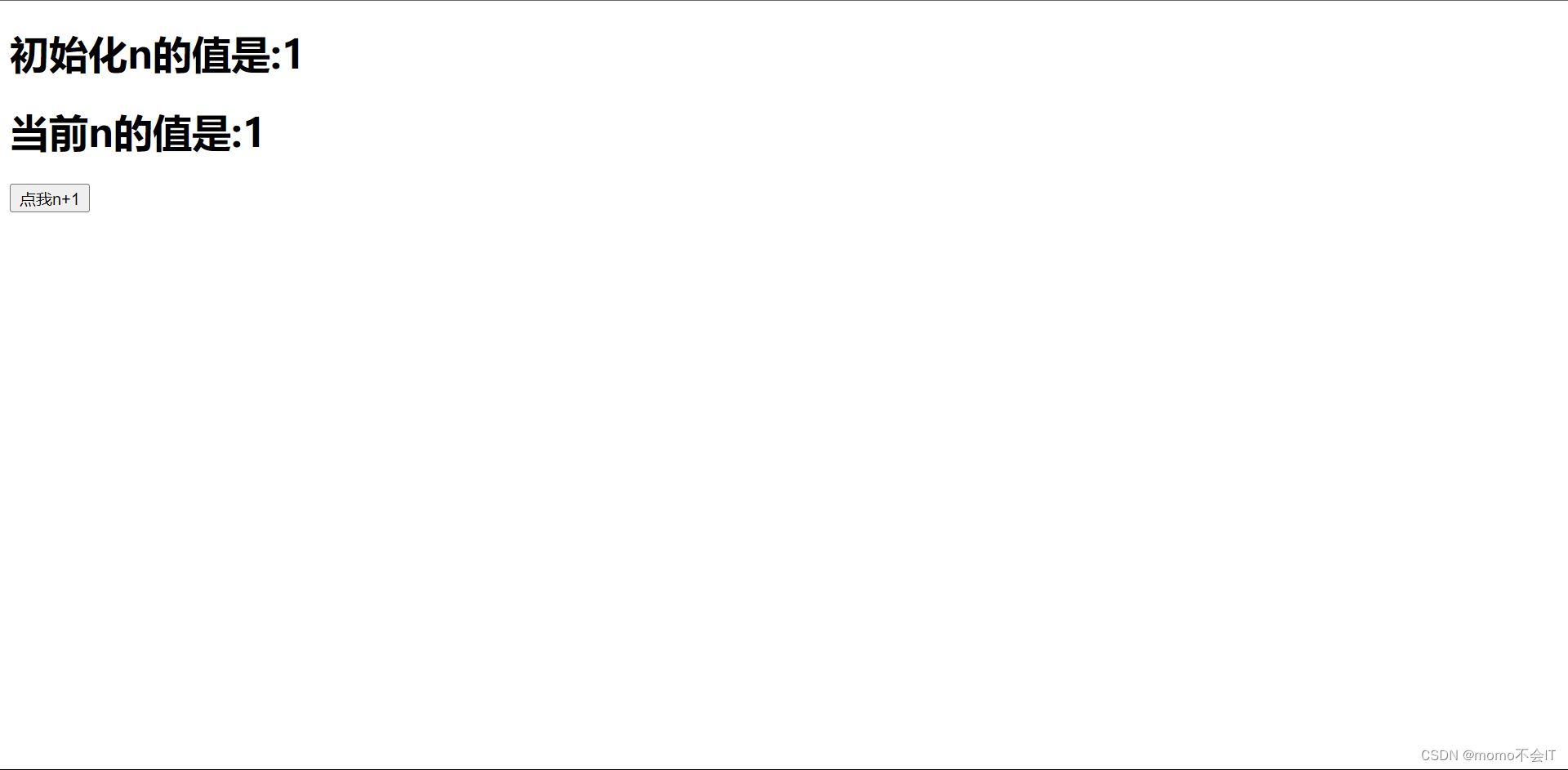
v-pre_指令
<!DOCTYPE html>
<html lang="en">
<head>
<meta charset="UTF-8">
<meta http-equiv="X-UA-Compatible" content="IE=edge">
<meta name="viewport" content="width=device-width, initial-scale=1.0">
<title>v-pre_指令</title>
<script type="text/javascript" src="../js/vue.js"></script>
</head>
<body>
<!-- 准备好一个盒子 -->
<div id="root">
<h1 v-pre>初始化n的值是:{
{n}}</h1>
<h1 v-pre>当前n的值是:{
{n}}</h1>
<button v-pre @click="n++">点我n+1</button>
</div>
</body>
<script type="text/javascript">
Vue.config.productionTip = false; //阻止 vue 在启动时生成生产提示。
const vm = new Vue({
el:'#root',
data:{
n:1,
},
})
</script>
</html>
<!-- 总结 -->
<!--
v-pre指令:
1.跳过其所在节点的编译过程
2.可利用它跳过:没有使用指令语法、没有使用插值语法的节点,会加快编译
-->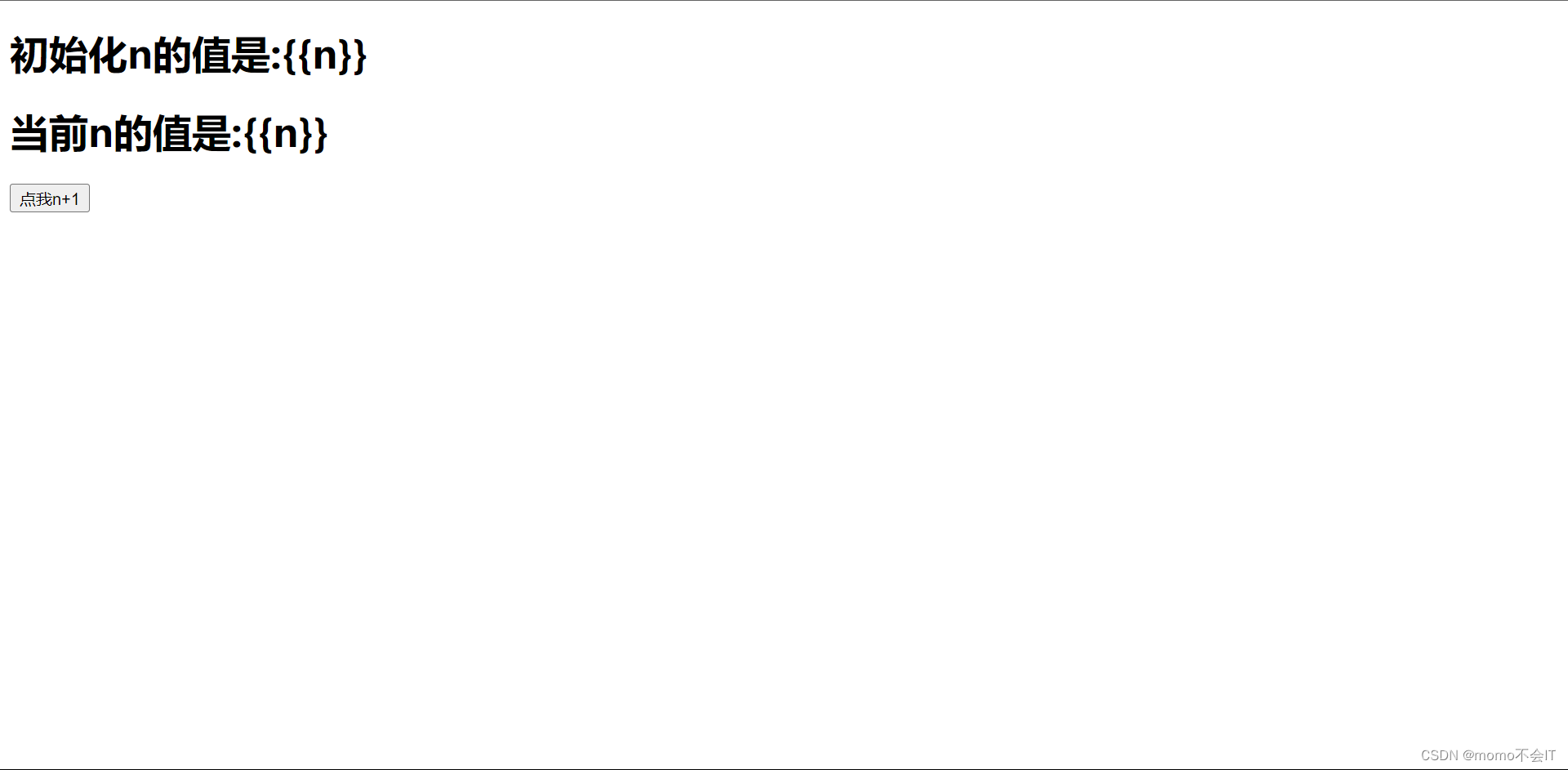
自定义指令
自定义指令
<!DOCTYPE html>
<html lang="en">
<head>
<meta charset="UTF-8">
<meta http-equiv="X-UA-Compatible" content="IE=edge">
<meta name="viewport" content="width=device-width, initial-scale=1.0">
<title>自定义指令</title>
<script type="text/javascript" src="../js/vue.js"></script>
</head>
<body>
<!-- 需求1:定义一个v-big指令,和v-text功能类似,但把绑定的数据放大十倍 -->
<!-- 需求2:定义一个v-fbind指令,和v-bing功能类似,但可以让其绑定的input元素默认获取焦点 -->
<div id="root">
<h1>{
{name}}</h1>
<h1>当前的n值是: <span v-text="n"></span></h1>
<h1>放大十倍的n值是: <span v-big="n"></span></h1>
<button @click="n++">点我n+1</button>
<hr/>
<input type="text" v-fbind:value="n">
</div>
</body>
<script type="text/javascript">
Vue.config.productionTip = false; //阻止 vue 在启动时生成生产提示。
const vm = new Vue({
el:'#root',
data:{
n:1,
name:'Vue'
},
directives:{
// big函数何时会被调用?1.指令与元素成功绑定时 2.指令所在模板被重新解析时
big(element,binding){
console.log(element)
element.innerText = binding.value * 10
},
fbind:{
bind(element,binding){
element.value = binding.value
},
insertde(element,binding){
element.focus()
},
update(element,binding){
element.value = binding.value
}
}
}
})
</script>
</html>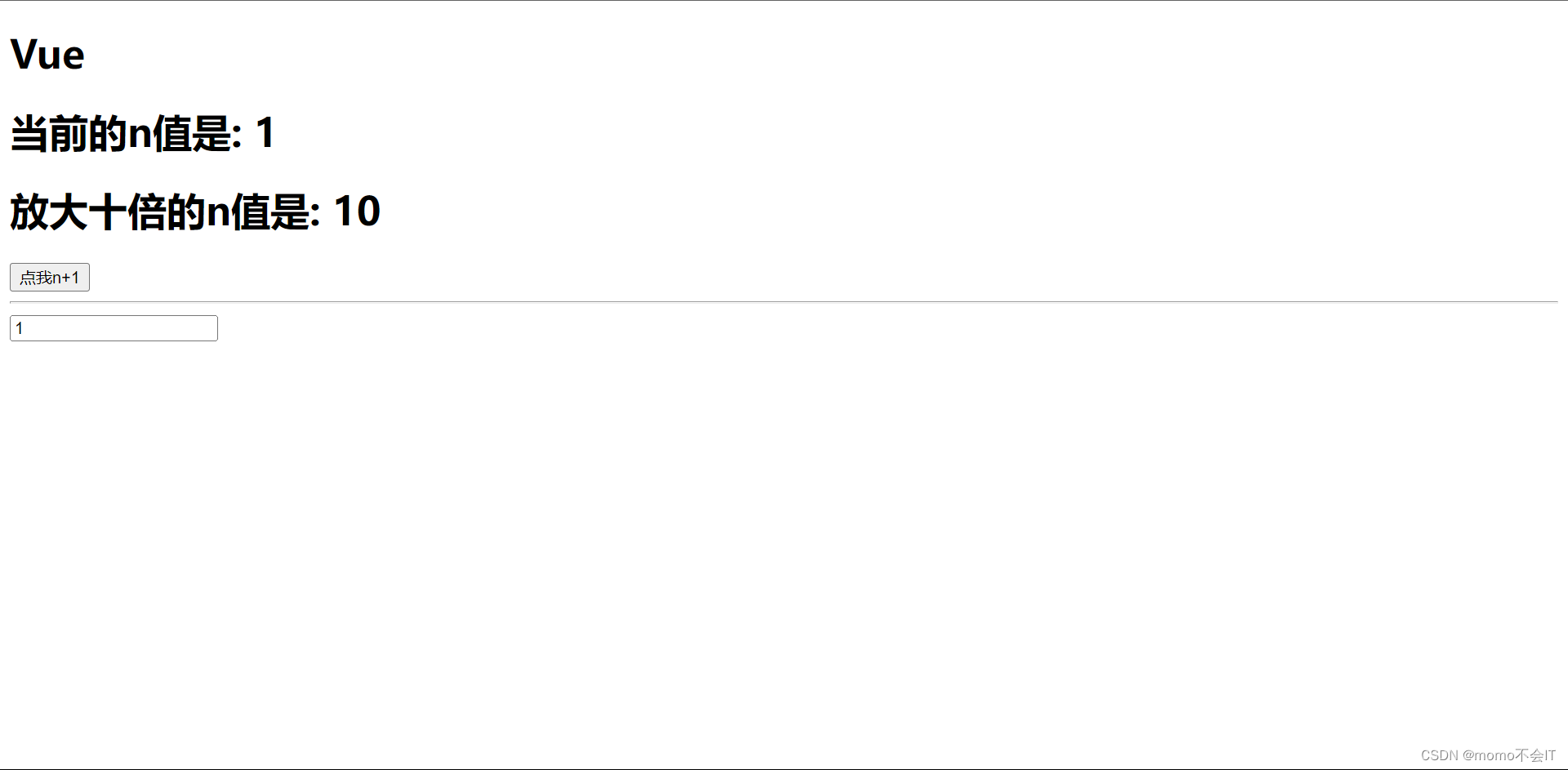
回顾一个DOM操作
<!DOCTYPE html>
<html lang="en">
<head>
<meta charset="UTF-8">
<meta http-equiv="X-UA-Compatible" content="IE=edge">
<meta name="viewport" content="width=device-width, initial-scale=1.0">
<title>回顾一个DOM操作</title>
<style>
.demo{
background-color: orange;
}
</style>
</head>
<body>
<button id="btn">点我创建一个输入框</button>
<script type="text/javascript">
const btn = document.getElementById('btn')
btn.onclick = () =>{
const input = document.createElement('input')
input.className = 'demo'
input.value = 99
input.click = () => {alert(1)}
document.body.appendChild(input)
input.focus()
input.parentElement.style.backgroundColor = 'skybule'
// console.log(input.parentElement)
}
</script>
</body>
</html>
总结
<!DOCTYPE html>
<html lang="en">
<head>
<meta charset="UTF-8">
<meta http-equiv="X-UA-Compatible" content="IE=edge">
<meta name="viewport" content="width=device-width, initial-scale=1.0">
<title>总结</title>
</head>
<body>
<!--
自定义指令总结:
一、定义语法:
(1)局部指令:
new Vue({ new Vue({
directives:{指令名:配置对象} 或 directives(){}
}) })
(2)全局指令:
Vue.directives:(指令名:配置对象) 或 Vue.directives:(指令名:回调函数)
二、配置对象中常用的3个回调:
(1)bind:指令与元素成功绑定时调用
(2)inserted:指令所在元素被插入页面时调用
(3)update:指令所在模板结构被重新解析时调用
三、备注:
1.指令定义时不加v-,但使用时要加v-
2.指令名如果不是多个单词,要使用kebab-case命名方式,不要用camelCase命名
(单词全小写,不用驼峰命名法)
-->
</body>
</html>生命周期
引出生命周期
<!DOCTYPE html>
<html lang="en">
<head>
<meta charset="UTF-8">
<meta http-equiv="X-UA-Compatible" content="IE=edge">
<meta name="viewport" content="width=device-width, initial-scale=1.0">
<title>引出生命周期</title>
<script type="text/javascript" src="../js/vue.js"></script>
</head>
<body>
<!-- 准备好一个盒子 -->
<div id="root">
<h1 :style="{opacity}">{
{name}}学习</h1>
</div>
</body>
<script type="text/javascript">
Vue.config.productionTip = false; //阻止 vue 在启动时生成生产提示。
const vm = new Vue({
el:'#root',
data:{
name:'Vue',
opacity:1
},
methods: {
},
// Vue完成模板的解析并把初始的真实DOM值元素放入页面后(挂载完毕)调用mounted
mounted() {
console.log('mounted',this)
setInterval(() => {
this.opacity -= 0.2
if(this.opacity<=0) this.opacity = 1
}, 0.00000000000001);
},
})
// setInterval(() => {
// vm.opacity -= 0.2
// if(vm.opacity<=0) vm.opacity = 1
// }, 0.00000000000001);
</script>
</html>
<!-- 总结 -->
<!--
生命周期:
1.又名:生命周期回调函数、生命周期函数、生命周期钩子
2.是什么:Vue在关键时刻帮我们调用的一些特殊名称的函数
3.生命周期函数的名字不可更改,但函数的具体内容是程序员根据需要编写的
4.生命周期中的this指向是vm 或 组件实例对象
-->
分析生命周期
<!DOCTYPE html>
<html lang="en">
<head>
<meta charset="UTF-8">
<meta http-equiv="X-UA-Compatible" content="IE=edge">
<meta name="viewport" content="width=device-width, initial-scale=1.0">
<title>分析生命周期</title>
<script type="text/javascript" src="../js/vue.js"></script>
</head>
<body>
<!-- 准备好一个盒子 -->
<div id="root">
<h1 :style="{opacity}">{
{name}}学习</h1>
</div>
</body>
<script type="text/javascript">
Vue.config.productionTip = false; //阻止 vue 在启动时生成生产提示。
const vm = new Vue({
el:'#root',
data:{
name:'Vue',
opacity:1
},
methods: {
},
beforeCreate() {
console.log('beforeCreate')
},
created() {
console.log('created')
},
beforeMount() {
console.log('beforeMount')
},
// Vue完成模板的解析并把初始的真实DOM值元素放入页面后(挂载完毕)调用mounted
mounted() {
console.log('mounted',this)
setInterval(() => {
this.opacity -= 0.2
if(this.opacity<=0) this.opacity = 1
}, 0.00000000000001);
},
beforeUpdate() {
console.log('beforeUpdate')
},
updated() {
console.log('updated ')
},
})
// setInterval(() => {
// vm.opacity -= 0.2
// if(vm.opacity<=0) vm.opacity = 1
// }, 0.00000000000001);
</script>
</html>
<!-- 总结 -->
<!--
常用的生命周期钩子:
1.mounted:发送ajax请求、启动定时器、绑定自定义事件、订阅消息等【初始化操作】
2.beforeDestroy:清除定时器、解除自定义事件、取消订阅消息等收尾工作【收尾工作】
关于销毁Vue实例
1.销毁后借助Vue开发者工具看不到任何消息
2.销毁后自定义事件会失效,但原生DOM事件依然有效
3.一般不会在beforeDestroy操作数据,因为即使操作数据,也不会在触发更新流程
-->
非单文件组件
基本使用
<!DOCTYPE html>
<html lang="en">
<head>
<meta charset="UTF-8">
<meta http-equiv="X-UA-Compatible" content="IE=edge">
<meta name="viewport" content="width=device-width, initial-scale=1.0">
<title>基本使用</title>
<script type="text/javascript" src="../js/vue.js"></script>
</head>
<body>
<!-- 准备好一个盒子 -->
<div id="root">
<!-- 第三步:编写组件标签 -->
<hello></hello>
<!-- 第三步:编写组件标签 -->
<contentss></contentss>
<hr/>
<!-- 第三步:编写组件标签 -->
<tego></tego>
</div>
<hr/>
<div id="root2">
<!-- 第三步:编写组件标签 -->
<hello>111</hello>
</div>
</body>
<script type="text/javascript">
Vue.config.productionTip = false; //阻止 vue 在启动时生成生产提示。
//第一步:创建content组件
const contentss = Vue.extend({
// el:'#root', //组件定义时, 一定不要写el配置项,以为最终所有的组件都要被一个Vue管理,由Vue决定服务哪个容器
//template只有一个根元素
template:`
<div>
<h1>{
{summer}}任务:</h1>
<h1>{
{name}}学习</h1>
<button @click='holiday'>点我提示学习时间</button>
</div>
`,
data(){
return{
summer:'暑假',
name:'Vue'
}
},
methods: {
holiday(){
alert(this.summer);
}
},
})
//第一步:创建tego组件
const tego = Vue.extend({
template:`
<div>
<h1></h1>
<h1></h1>
h1
</div>
`,
data(){
return{
need:'需要',
studys:'学习'
}
}
})
//第一步:创建hello组件
const hello = Vue.extend({
template:`
<div>
<h2>你好呀!{
{name}}</h2>
</div>
`,
data(){
return{
name:'Tom'
}
}
})
// 第三步:全局注册组件
Vue.component('hello',hello)
// 创建Vue
const vm = new Vue({
el:'#root',
// 第二步:注册组件(局部注册)
components:{
// 不同名
// neirong:content,
// jishu:tego
// 同名时可以这样简写
contentss,
tego
}
})
const vm2 =new Vue({
el:'#root2'
})
</script>
</html>
<!-- 总结 -->
<!--
Vue中使用组件的三大步骤:
1.定义组件(创建组件)
2.注册组件
3.使用组件(写组件标签)
一、如何定义一个组件?
使用Vue.extend(options)创建,其中options和new Vue(options)时传入的那个options几乎一样,但也有点区别
区别如下:
1.el不要写,为什么? —— 最终所有组件都要经过一个vm的管理,由vm中的el决定服务哪个容器
2.data必须写成函数,为什么? —— 避免组件被复用时,数据存在引用关系
备注:使用template可以配置组件结构
二、如何注册组件?
1.局部注册:靠new Vue的时候传入completes选项
2.全局注册:靠Vue.complete('组件名',组件)
三、编写组件标签
<hello></hello>
-->
几个注意点
<!DOCTYPE html>
<html lang="en">
<head>
<meta charset="UTF-8">
<meta http-equiv="X-UA-Compatible" content="IE=edge">
<meta name="viewport" content="width=device-width, initial-scale=1.0">
<title>几个注意点</title>
<script type="text/javascript" src="../js/vue.js"></script>
</head>
<body>
<!-- 准备好一个盒子 -->
<div id="root">
<!-- 第三步:编写组件标签 -->
<hello></hello>
<!-- 第三步:编写组件标签 -->
<contentss></contentss>
<hr/>
<!-- 第三步:编写组件标签 -->
<tego></tego>
</div>
<hr/>
<div id="root2">
<!-- 第三步:编写组件标签 -->
<hello>111</hello>
</div>
</body>
<script type="text/javascript">
Vue.config.productionTip = false; //阻止 vue 在启动时生成生产提示。
//第一步:创建content组件
const contentss = Vue.extend({
// el:'#root', //组件定义时, 一定不要写el配置项,以为最终所有的组件都要被一个Vue管理,由Vue决定服务哪个容器
//template只有一个根元素
template:`
<div>
<h1>{
{summer}}任务:</h1>
<h1>{
{name}}学习</h1>
<button @click='holiday'>点我提示学习时间</button>
</div>
`,
data(){
return{
summer:'暑假',
name:'Vue'
}
},
methods: {
holiday(){
alert(this.summer);
}
},
})
//第一步:创建tego组件
const tego = Vue.extend({
template:`
<div>
<h1>{
{need}}学习什么?</h1>
<h1>要{
{studys}}ES6</h1>
</div>
`,
data(){
return{
need:'需要',
studys:'学习'
}
}
})
//第一步:创建hello组件
const hello = {
template:`
<div>
<h2>你好呀!{
{name}}</h2>
</div>
`,
data(){
return{
name:'Tom'
}
}
}
// 第三步:全局注册组件
Vue.component('hello',hello)
// 创建Vue
const vm = new Vue({
el:'#root',
// 第二步:注册组件(局部注册)
components:{
// 不同名
// neirong:content,
// jishu:tego
// 同名时可以这样简写
contentss,
tego
}
})
const vm2 =new Vue({
el:'#root2'
})
</script>
</html>
<!--
几个注意点:
1.关于组件名:
一个单词组成:
第一种写法(首字母大写):School
第二种写法(首字母小写):school
多个单词组成:
第一种写法(kebab-case命名):my-school
第二种写法(CamelCase命名):MySchool(需要Vue脚手架支持)
备注:
(1)组件名尽可能回避HTML中已有的元素名称,例如:h2、H2都不行
(2)可以使用 那么配置项指定组件在开发者工具中呈现的名字
2.关于组件标签:
第一种写法:<school></school>
第二种写法:</school>
备注:不使用脚手架时,</school>会导致后续组件不能渲染
3.一个简写方式:
const school = Vue.extend(options) 课简写为 const school = options(具体看hello组件)
-->
组件的嵌套
<!DOCTYPE html>
<html lang="en">
<head>
<meta charset="UTF-8">
<meta http-equiv="X-UA-Compatible" content="IE=edge">
<meta name="viewport" content="width=device-width, initial-scale=1.0">
<title>组件的嵌套</title>
<script type="text/javascript" src="../js/vue.js"></script>
</head>
<body>
<!-- 准备好一个盒子 -->
<div id="root">
<app></app>
</div>
</body>
<script type="text/javascript">
Vue.config.productionTip = false; //阻止 vue 在启动时生成生产提示。
//第一步:创建student组件
const student = Vue.extend({
template:`<h1>学生姓名:{
{namee}}</h1>`,
data(){
return{
namee:'jojo'
}
}
})
//第一步:创建school组件
const school = Vue.extend({
template:`
<div>
<h1>学校名称:{
{name}}</h1>
<student></student>
</div>
`,
data(){
return{
name:'广东白云学院'
}
},
components:{
student
}
})
//第一步:创建app组件
const app = Vue.extend({
template:`
<school></school>
`,
components:{
school
}
})
const vm = new Vue({
el:'#root',
components:{
app
}
})
</script>
</html>
VueComponent
<!DOCTYPE html>
<html lang="en">
<head>
<meta charset="UTF-8">
<meta http-equiv="X-UA-Compatible" content="IE=edge">
<meta name="viewport" content="width=device-width, initial-scale=1.0">
<title>VueComponent</title>
<script type="text/javascript" src="../js/vue.js"></script>
</head>
<body>
<!-- 准备好一个盒子 -->
<div id="root">
<h1>{
{name}}学习</h1>
</div>
</body>
<script type="text/javascript">
Vue.config.productionTip = false; //阻止 vue 在启动时生成生产提示。
const vm = new Vue({
el:'#root',
data:{
name:'Vue',
},
})
</script>
</html>
<!-- 总结 -->
<!--
关于VueComponent
1.school组件本质是一个名为VueComponent的构造函数,且不是程序员定义的,是Vue.extend生成的
2.我们只需要写<school></school> 或 </school>,Vue解析时会帮我们创建school组件的实例对象,
即Vue帮我们执行的:new VueComponent(options)
3.特别注意:每次调用Vue.extend,返回都是一个全新的VueComponent!!!
4.关于this指向:
(1)组件配置:
data函数、methods中的函数、watch中的函数、computed中的函数、它们的this均是【VueComponent实例对象】
(2)new Vue(options)配置中:
data函数、methods中的函数、watch中的函数、computed中的函数、它们的this均是【Vue实例对象】
5.VueComponent的实例对象,以后简称为vc(也可以称之为:组件实例对象)
Vue的实例对象,以后简称vm
-->
一个重要的内置对象
<!DOCTYPE html>
<html lang="en">
<head>
<meta charset="UTF-8">
<meta http-equiv="X-UA-Compatible" content="IE=edge">
<meta name="viewport" content="width=device-width, initial-scale=1.0">
<title>一个重要的内置对象</title>
<script type="text/javascript" src="../js/vue.js"></script>
</head>
<body>
<!-- 准备好一个盒子 -->
<div id="root">
<h1>{
{name}}学习</h1>
</div>
</body>
<script type="text/javascript">
Vue.config.productionTip = false; //阻止 vue 在启动时生成生产提示。
// // 定义一个构造函数
// function Demo (){
// this.a = 1
// this.b = 2
// }
// // 创建一个Demo的实例对象
// const d = new Demo()
// console.log(Demo.prototype) //显示原型属性
// console.log(d.__proto__) //隐式原型属性
// console.log(Demo.prototype === d.__proto__)
// // 程序员通过显示原型属性操作原型对象,追加一个x属性,值为99
// Demo.prototype.x = 99
// console.log(d)
const vm = new Vue({
el:'#root',
data:{
name:'Vue',
},
})
</script>
</html>
<!-- 总结 -->
<!--
1.一个重要的内置关系:VueComponent.prototype.__proto__===Vue.prototype
(school.prototype.__proto__===Vue.prototype)
2.为什么要有这个关系:让组件实例对象(vc)可以访问到 Vue原型上的属性、方法
-->
单组件文件
首先创建一个Vue文件

在Visual Studio Code 中安装插件
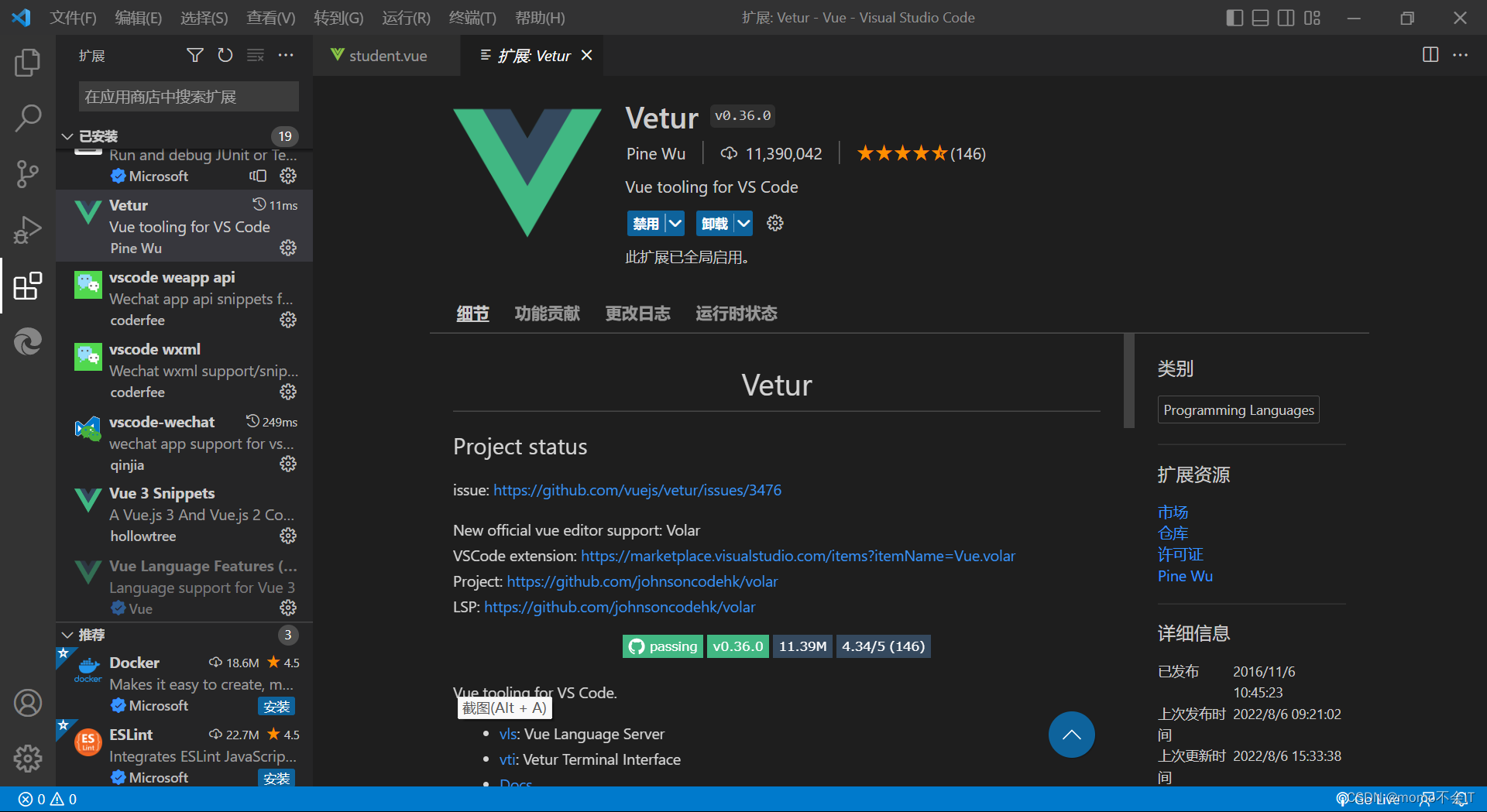
插件安装成功后只要打上一个<就可以把模板编写出来

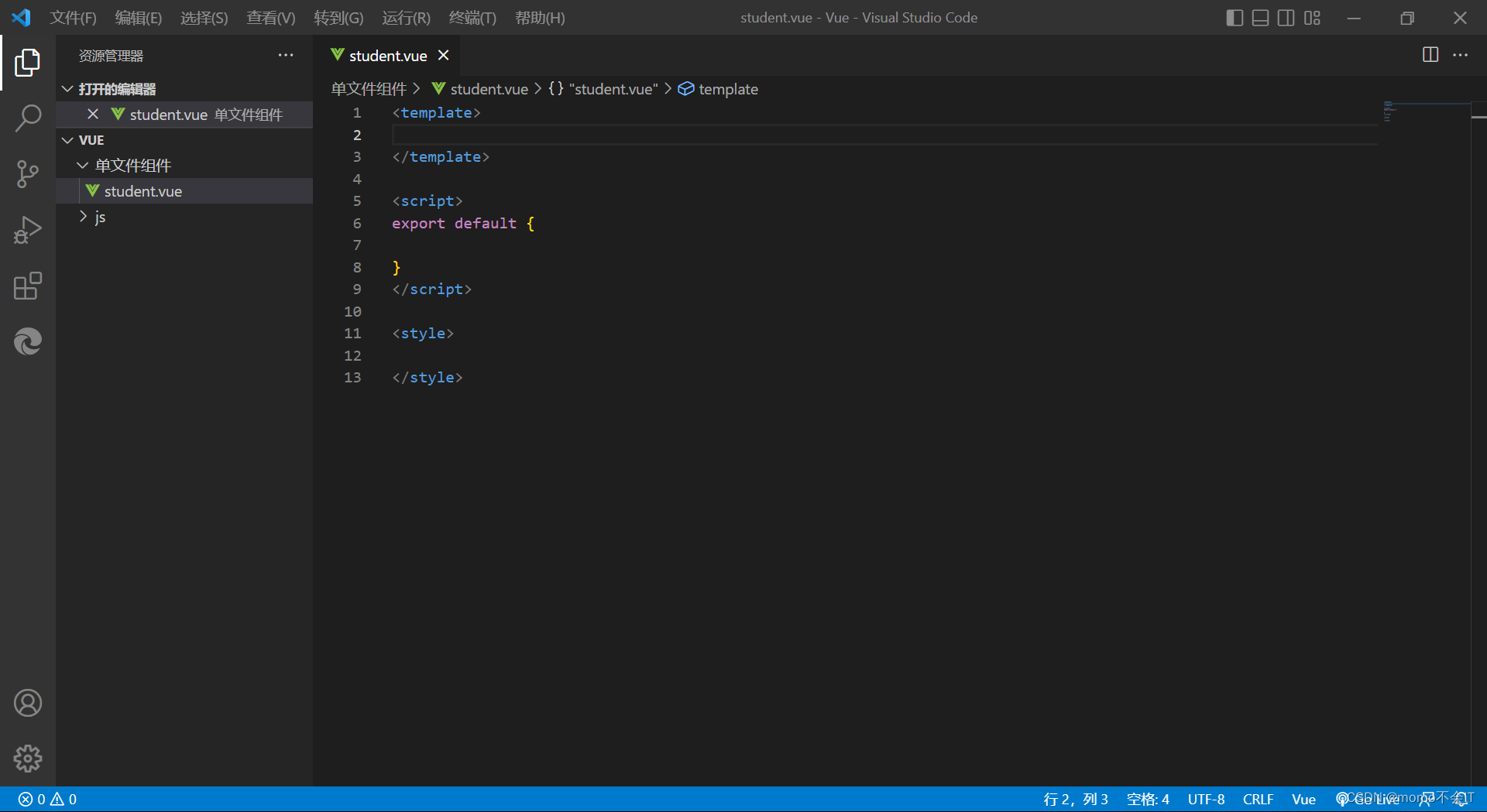
<template>
<!-- 组件的结构 -->
<div>
<h1>学生姓名:{
{name}}</h1>
<h1>学生年龄:{
{age}}</h1>
<button @click='year'>点我提示学生年龄</button>
</div>
</template>
<script>
// 组件交互相关的代码(数据、方法等等)
export default {
name:'student',
data(){
return{
name:'jojo',
age:21
}
},
methods: {
year(){
alert(this.age);
}
}
}
</script>再创建一个school.vue文件
<template>
<!-- 组件的结构 -->
<div class="demo">
<h1>{
{summer}}任务:</h1>
<h1>{
{name}}学习</h1>
<button @click='holiday'>点我提示学习时间</button>
</div>
</template>
<script>
// 组件交互相关的代码(数据、方法等等)
export default {
name:'school',
data(){
return{
summer:'暑假',
name:'Vue'
}
},
methods: {
holiday(){
alert(this.summer);
}
}
}
</script>
<style>
/* 组件的样式 */
.demo{
background-color: orange;
}
</style>创建一个app.vue文件,简单来说app.Vue是其他的Vue文件的大哥,其他的Vue文件想使用时都要在app.vue文件中进行注册
<template>
<div>
<school></school>
<student></student>
</div>
</template>
<script>
import school from './school.vue'
// 引入组件
import school from './school.vue'
import student from './student.vue'
export default {
components: { school,student },
name:'app',
comments:{
school,
student
}
}
</script>
<style>
</style>在html中是无法直接使用Vue文件的需要将Vue文件引入在JS文件中,在html文件调用JS文件
import app from './app.vue'
new Vue({
el:'#root',
components:{
app
}
})创建index页面
<!DOCTYPE html>
<html lang="en">
<head>
<meta charset="UTF-8">
<meta http-equiv="X-UA-Compatible" content="IE=edge">
<meta name="viewport" content="width=device-width, initial-scale=1.0">
<title>index</title>
</head>
<body>
<div id="root">
<app></app>
</div>
<script type="text/javascript" src="../js/vue.js"></script>
<script type="text/javascript" src="./main.js"></script>
</body>
</html>但是浏览器是无法识别Vue文件的,这时候我们就需要创建一个Vue的脚手架了
在电脑上打开命令提示符
配置npm淘宝镜像(大多数配置时下载速度比较缓慢配置淘宝镜像可以加快下载速度):npm config set registry https://registry.npm.taobao.org
配置成功后进行全局安装Vue脚手架:npm install -g @Vue/cli(下载时卡主住了可以尝试按下回车)
配置成功后使用命令提示符创建Vue脚手架
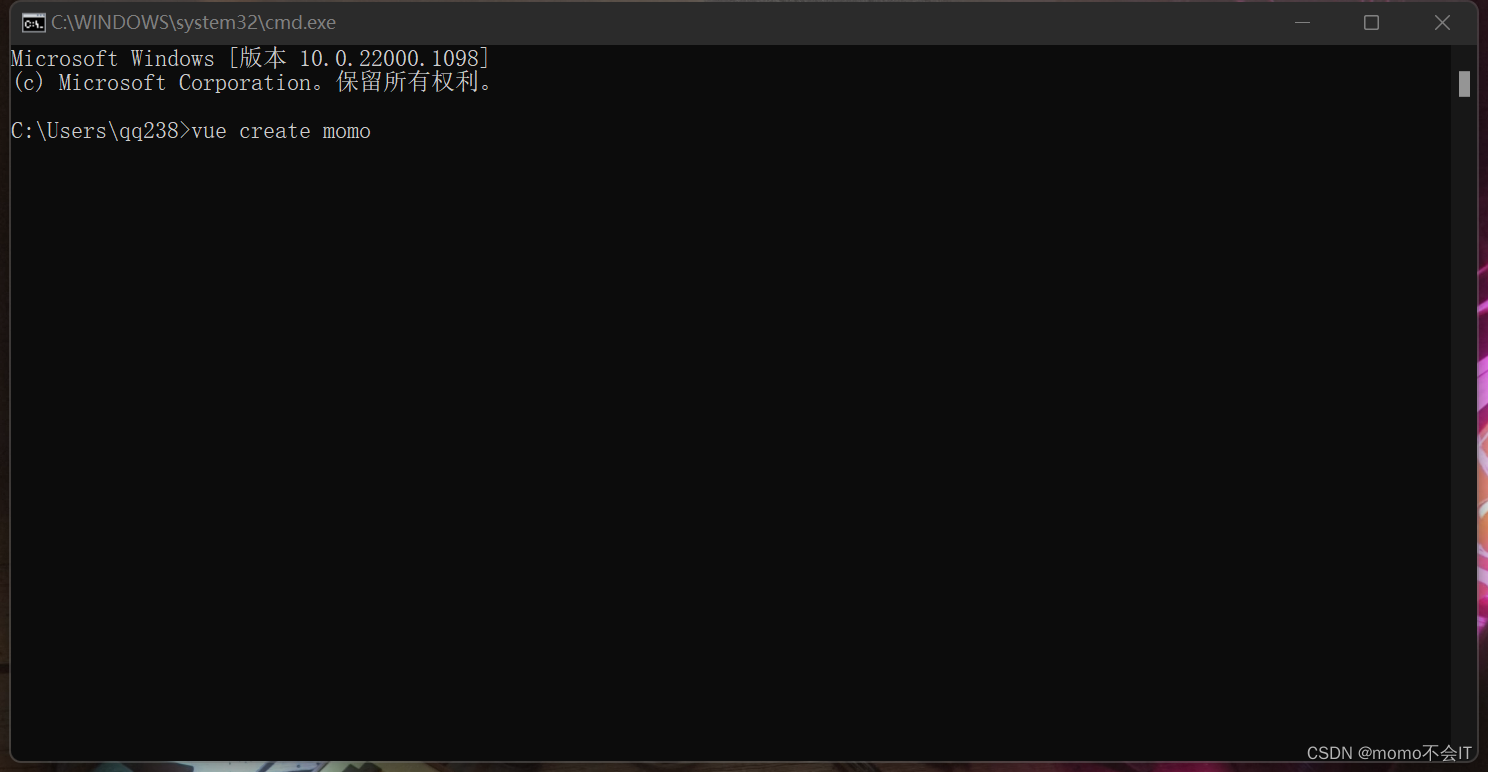


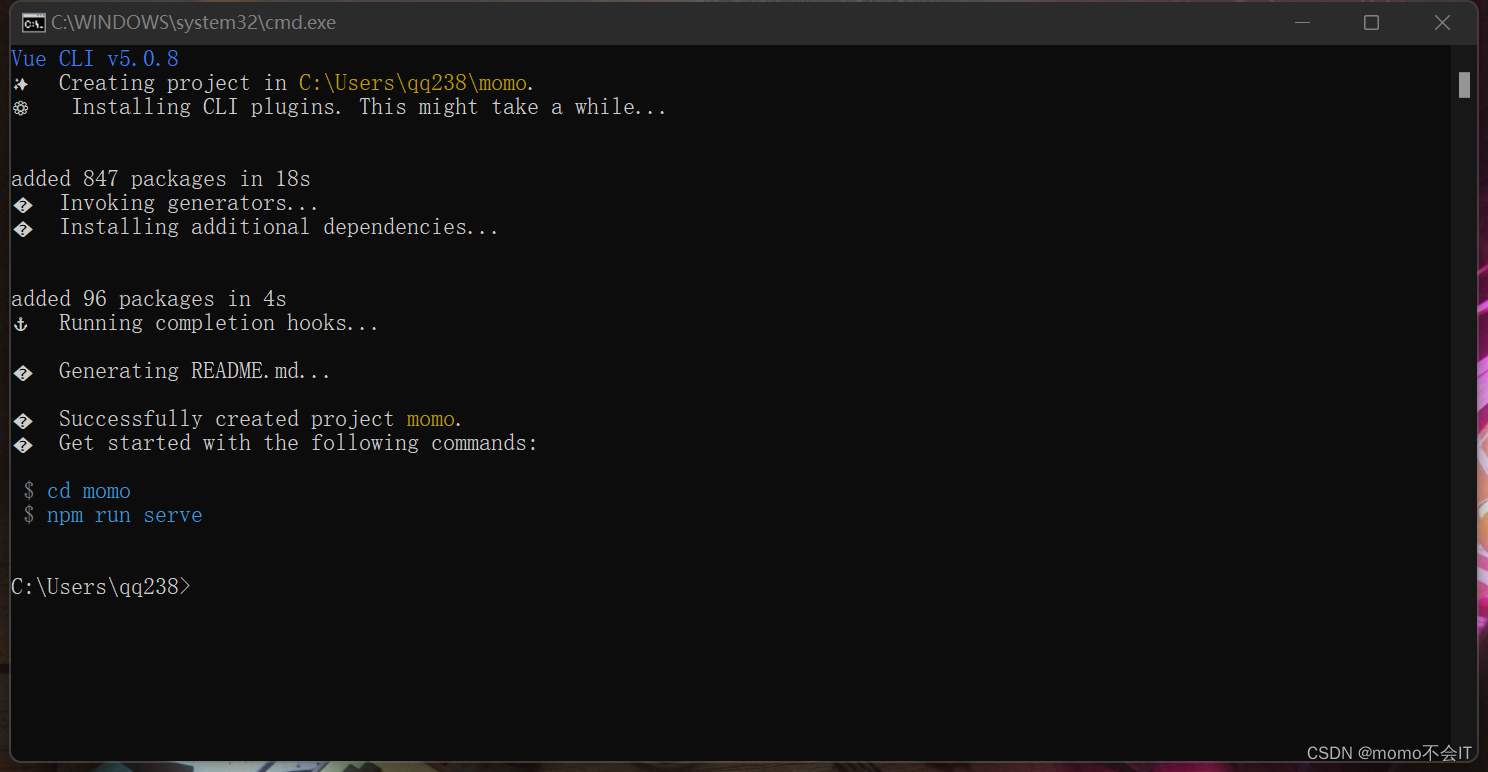
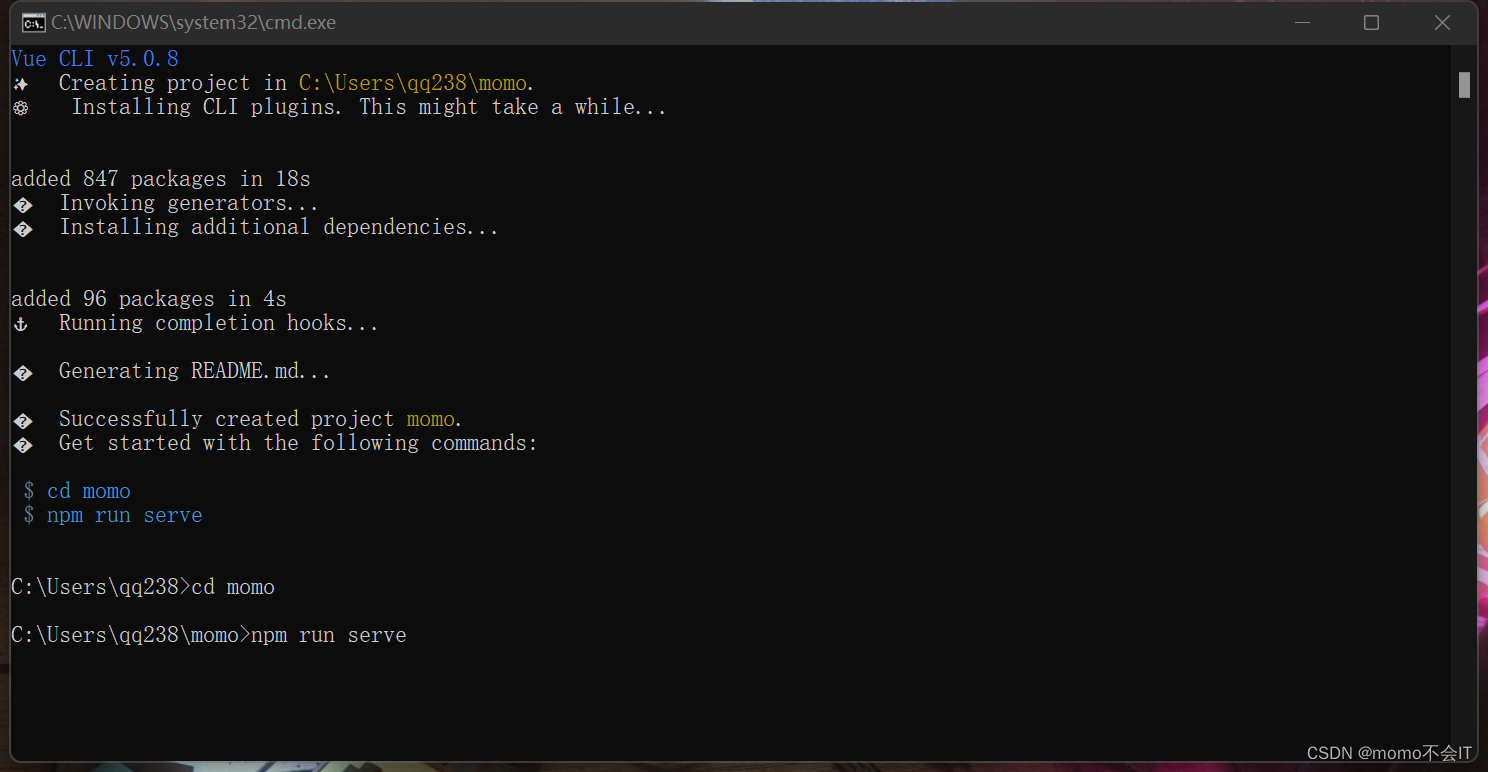

将local发网址复制到浏览器运行即可
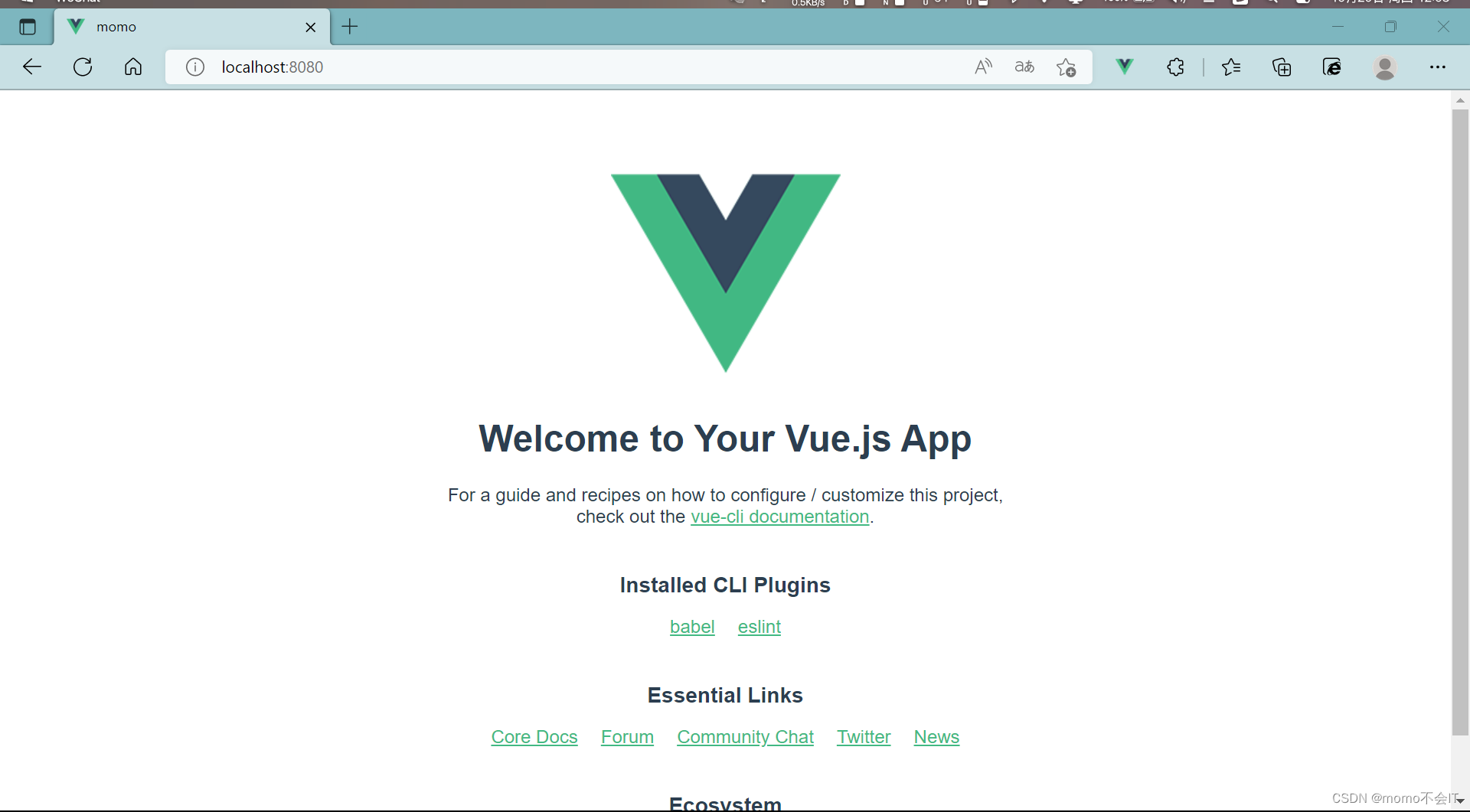
使用Visual Studio Code将我们刚创建的文件夹打开就可以了看到刚才页面的代码

因此创建脚手架后,我们每次运行都需要在终端中使用npm run serve


node_module
public
favicon.ico:页签图标
index.html:主页面
src
assets:存放静态资源
logo.png
component:存放组件
HelloWorld.vue
App.vue:汇总所有组件
main.js:入口文件
gitignore:git版本管制忽略的配置
babel.config.js:babel的配置文件
package.json:应用包配置文件
README.md:应用描述文件
package-lock.json:包版本控制文件
关于不同版本的Vue:
- vue.js与vue.runtime.xxx.js的区别:
(1)vue.js即使完整版的Vue,包含:核心功能+模板解析器
(2)vue.runtime.xxx.js就是运行版的vue,只包含:核心功能;没有模板解析器
- 因为vue.runtime.xxx.js没有模板解析器,所所以不能使用template配置项,需要使用
render函数接收到的createElement函数去指定具体内容
vue.config.js配置文件
> 使用vue.inspect > output.js可以查看到Vue脚手架的默认配置
> 使用vue.config.js可以对脚手架进行个性化定制,详情见:http://cli.vuejs.org/zh
ref属性
components/school.vue
<template>
<div class="xuexiao">
<h1>学校名字:{
{name}}</h1>
<h1>地址:{
{address}}</h1>
</div>
</template>
<script>
export default {
name:'school',
data() {
return {
name:'广东白云学院',
address:'广东省广州市白云区江高镇学苑路1号'
}
},
}
</script>
<style>
.xuexiao{
background-color: grey;
}
</style>App.vue
<template>
<div>
<h1 v-text="name" ref="title"></h1>
<button @click="showDOM" ref="btn">点我输出上面的DOM元素</button>
<school ref="sch" />
</div>
</template>
<script>
import school from './components/school';
export default {
name:'App',
components:{school},
data() {
return {
name:'欢迎学习Vue'
}
},
methods: {
showDOM(){
console.log(this.$refs.title) //真实DOM
console.log(this.$$refs.btn) //真实DOM
console.log(this.$refs.sch) //School组件实例对象(vc)
}
},
}
</script>
<style>
</style>main.js
import Vue from 'vue'
import App from './App.vue'
Vue.config.productionTip = false
new Vue({
el:'#app',
render: h => h(App)
})ref属性
1.被用来给元素或子组件注册引用信息(id的替代者)
2.应用在html标签上获取的是真实的DOM元素,应用在组件标签上是组件实例对象(vc)
3.使用方式:
打标识:<h1 ref="xxx">......</h1> 或 <School ref="xxx"</School>
获取:this.$ref.xxx
props配置
components/student.vue
<template>
<div>
<h1>{
{msg}}</h1>
<h2>学生名字:{
{name}}</h2>
<h2>年龄:{
{age-1}}</h2>
<h2>性别:{
{sex}}</h2>
<button @click="tipAge">点我提示年龄</button>
</div>
</template>
<script>
export default {
name:'student',
// 简单声明接收
props:['name','age','sex'],
// 接收的同时对数据进行类型限制
// props:{
// name:String,
// age:Number,
// sex:String
// }
// 接收的同时对数据:进行类型限制+默认值指定+必要性的限制
// props:{
// name:{
// type:String,//name的类型是字符串
// require:true//name是必要的
// },
// age:{
// type:Number,
// default:99 //默认值
// },
// sex:{
// type:String,
// require:true
// }
// },
data() {
return {
msg:'欢迎学习Vue',
myAge:this.age
}
}, //props优先级比data高
methods: {
tipAge(){
alert(this.myAge)
}
},
}
</script>
<style>
</style>App.vue
<template>
<div>
<student name="jojo" :age="21" sex="女" />
</div>
</template>
<script>
import Student from './components/student'
export default {
name:'App',
components:{Student},
data() {
return {
name:'欢迎学习Vue'
}
},
}
</script>
<style>
</style>main.js
import Vue from 'vue'
import App from './App.vue'
Vue.config.productionTip = false
new Vue({
el:'#app',
render: h => h(App)
})配置项props
功能:让组件接收外部传过来的数据
(1)传递数据
<Demo name="xxx"/>
(2)接收数据:
第一种方式(只接收):
props:['name']
第二种方式(限制类型):
props:{
name:Number
}
第三种方式(限制类型、限制必要性、指定默认值):
props:{
name:{
type:String,//类型
required:ture,//必要性
default:'老王'//默认值
}
}
备注:props是只读,Vue底层会检测你对props的修改,如果进行了修改,就会发出警告,
若业务需求确实需要更改,那么请复制props的内容到data中一份,然后去修改data中
的数据。
mixin混入(合)
components/school.vue
<template>
<div>
<h1 @click="tipName">学校:{
{name}}</h1>
<h1>学校地址:{
{adress}}</h1>
</div>
</template>
<script>
import { mixin } from '../mixin';
export default {
name:'school',
data() {
return {
name:'广东白云学院',
adress:'广东省广州市白云区江高镇学苑路1号'
}
},
mixins:[mixin]
}
</script>
<style>
</style>components/student.vue
<template>
<div>
<h1 @click="tipName">学生姓名:{
{name}}</h1>
<h1>学生年龄:{
{age}}</h1>
</div>
</template>
<script>
import { mixin } from '../mixin';
export default {
name:'student',
data() {
return {
name:'jojo',
age:22
}
},
mixins:[mixin]
}
</script>
<style>
</style>App.vue
<template>
<div>
<student/>
<school/>
</div>
</template>
<script>
import School from './components/school'
import Student from './components/student'
export default {
name:'App',
components:{Student,School},
data() {
return {
name:'欢迎学习Vue'
}
},
}
</script>
<style>
</style>main.js
import Vue from 'vue'
import App from './App.vue'
import { mixin } from "./mixin";
Vue.config.productionTip = false
Vue.mixin(mixin)
new Vue({
el:'#app',
render: h => h(App)
})mixin.js
export const mixin = {
data() {
return {
x:100,y:200
}
},
methods: {
tipName(){
alert(this.name)
}
}
}mixin(混入)
功能:可以把多个组件公用的配置提取一个混入的对象
使用方式:
第一步定义混合,例如:
{
data(){....},
methods:{....}
....
}
第二步使用混合,例如:
(1)全局混入:Vue.mixin(xxx) 全局在main引入
(2)局部混入:mixins:['xxx']
插件
components/school.vue
<template>
<div>
<h1>学校:{
{name}}</h1>
<h1>学校地址:{
{adress}}</h1>
</div>
</template>
<script>
export default {
name:'school',
data() {
return {
name:'广东白云学院',
adress:'广东省广州市白云区江高镇学苑路1号'
}
},
}
</script>
<style>
</style>components/student.vue
<template>
<div>
<h1>学生姓名:{
{name}}</h1>
<h1>学生年龄:{
{age}}</h1>
</div>
</template>
<script>
export default {
name:'student',
data() {
return {
name:'jojo',
age:22
}
},
}
</script>
<style>
</style>App.vue
<template>
<div>
<student/>
<school/>
</div>
</template>
<script>
import School from './components/school'
import Student from './components/student'
export default {
name:'App',
components:{Student,School},
data() {
return {
name:'欢迎学习Vue'
}
},
}
</script>
<style>
</style>main.js
// 引入vue
import Vue from 'vue'
// 引入App
import App from './App.vue'
// 引入插件
import plugins from './plugins'
// 关闭vue的生产提示
Vue.config.productionTip = false
// 应用(使用)插件
Vue.use(plugins)
// 创建vm
new Vue({
el:'#app',
render: h => h(App)
})plugins.js
export default {
install(){
console.log('@@@install')
}
}插件
功能:用于增强Vue
本质:包含install方法的一个对象,install的第一个参数是Vue,第二个以后的参数是插件使用者传递的数据
定义插件:
对象.install = function(Vue,options){
//1.添加全局过滤器
Vue.filter(....)
//2.添加全局指令
Vue.mixin(....)
//3.添加实例方法
Vue.prototype.$myMethod = function(){....}
Vue.prototype.$myProperty = xxxx
}
使用插件:Vue.use()
scoped样式
components/MyFooter.vue
<template>
</template>
<script>
export default {
name:'MyFooter',
}
</script>
<style>
</style>components/MyHeader.vue
<template>
</template>
<script>
export default {
name:'MyHeader',
}
</script>
<style>
</style>components/MyList.vue
<template>
<div>
<my-item>
</div>
</template>
<script>
import MyItem from './MyItem.vue'
export default {
components: { MyItem },
name:'MyList',
}
</script>
<style>
</style>components/MyItem.vue
<template>
</template>
<script>
export default {
name:'MyItem',
}
</script>
<style>
</style>App.vue
<template>
<div>
<my-footer/>
<my-header/>
<my-list/>
</div>
</template>
<script>
import MyFooter from './components/MyFooter '
import MyHeader from './components/MyHeader'
import MyList from './components/MyList'
export default {
name:'App',
components:{
MyFooter,
MyHeader,
MyList
},
data(){
return {
name:'欢迎学习Vue'
}
},
}
</script>
<style>
</style>main.js
// 引入vue
import Vue from 'vue'
// 引入App
import App from './App.vue'
// 关闭vue的生产提示
Vue.config.productionTip = false
// 创建vm
new Vue({
el:'#app',
render: h => h(App)
})scoped样式
作用:让样式在局部生效,防止冲突
写法<style scoped>
浏览器本地存储
localStorage.html
<!DOCTYPE html>
<html lang="en">
<head>
<meta charset="UTF-8">
<meta http-equiv="X-UA-Compatible" content="IE=edge">
<meta name="viewport" content="width=device-width, initial-scale=1.0">
<title>localStorage</title>
</head>
<body>
<h2>localStorage</h2>
<button onclick="saveData()">点击保存数据</button>
<button onclick="readData()">点击查看数据</button>
<button onclick="deleteData()">点击删除数据</button>
<button onclick="deleteAllData()">点击清空所有数据</button>
<script type="text/javascript">
let p = {name:'张三',age:20}
function saveData(){
localStorage.setItem('msg','hello!!!')
localStorage.setItem('msg2',666)
localStorage.setItem('person',JSON.stringify(p))
}
function readData(){
console.log(localStorage.getItem('msg'))
console.log(localStorage.getItem('msg2'))
const result = localStorage.getItem('person')
console.log(JSON.parse(result))
console.log(localStorage.getItem('msg3'))
}
function deleteData(){
localStorage.removeItem('msg2')
}
function deleteAllData(){
localStorage.clear()
}
</script>
</body>
</html>sessionSrotage.html
<!DOCTYPE html>
<html lang="en">
<head>
<meta charset="UTF-8">
<meta http-equiv="X-UA-Compatible" content="IE=edge">
<meta name="viewport" content="width=device-width, initial-scale=1.0">
<title>sessionSrotage</title>
</head>
<body>
<h2>sessionStorage</h2>
<button onclick="saveData()">点击保存数据</button>
<button onclick="readData()">点击查看数据</button>
<button onclick="deleteData()">点击删除数据</button>
<button onclick="deleteAllData()">点击清空所有数据</button>
<script type="text/javascript">
let p = {name:'张三',age:20}
function saveData(){
sessionStorage.setItem('msg','hello!!!')
sessionStorage.setItem('msg2',666)
sessionStorage.setItem('person',JSON.stringify(p))
}
function readData(){
console.log(sessionStorage.getItem('msg'))
console.log(sessionStorage.getItem('msg2'))
const result = sessionStorage.getItem('person')
console.log(JSON.parse(result))
console.log(sessionStorage.getItem('msg3'))
}
function deleteData(){
sessionStorage.removeItem('msg2')
}
function deleteAllData(){
sessionStorage.clear()
}
</script>
</body>
</html>组件自定义事件
components/school.vue
<template>
<div class="sch">
<h1>学校:{
{name}}</h1>
<h1>学校地址:{
{adress}}</h1>
<button @click="sendSchoolName">点击获取学校名称</button>
</div>
</template>
<script>
export default {
name:'school',
props:['getSchoolName'],
data() {
return {
name:'广东白云学院',
adress:'广东省广州市白云区江高镇学苑路1号'
}
},
methods:{
sendSchoolName(){
this.getSchoolName(this.name)
}
}
}
</script>
<style scoped>
.sch{
background-color: skyblue;
}
</style>components/student.vue
<template>
<div class="stu">
<h2>学生姓名:{
{name}}</h2>
<h2>学生性别:{
{age}}</h2>
<h2>当前求和为:{
{number}}</h2>
<button @click="add">点击求和加1</button>
<button @click="sendStudentName">点击获取学生名称</button>
<button @click="unbind">点击解绑guangbai事件</button>
<button @click="death">销毁当前的student组件的实例</button>
</div>
</template>
<script>
export default {
name:'student',
data() {
return {
name:'jojo',
age:20,
number:0
}
},
methods:{
add(){
console.log('add被调用了!')
this.number++
},
sendStudentName(){
// 触发Student组件实例身上的guangbai事件
this.$emit('guangbai',this.name,666,888,999)
this.$emit('demo')
},
unbind(){
// this.$off('guangbai') //解绑一个自定义事件
// this.$off(['guangbai','demo']) //解绑多个自定义事件
this.$off() //解绑所有自定义事件
},
death(){
this.$destroy() //销毁了当前的student组件的实例,销毁后所有的student实例的自定义事件全都不奏效
}
}
}
</script>
<style scoped>
.stu{
background-color: orange;
}
</style>App.vue
<template>
<div class="demo">
<h2>{
{title}}</h2>
<h2>学生的姓名是:{
{studentName}}</h2>
<!-- 通过父组件给子组件传递函数类型的props实现:子给父传递数据 -->
<school :getSchoolName="getSchoolName"/>
<!-- 通过父组件给子组件绑定一个自定义事件实现:子给父传递数据 (第一种写法:使用@或v-on) -->
<!-- <student v-on:guangbai.once="getStudentName"/> -->
<!-- <student v-on:guangbai="getStudentName" @demo="m1"/> -->
<!-- 通过父组件给子组件绑定一个自定义事件实现:子给父传递数据 (第二种写法:使用ref) -->
<student ref="student" @click.native="show"/>
</div>
</template>
<script>
import School from './components/school'
import Student from './components/student'
export default {
name:'App',
components:{Student,School},
data() {
return {
title:'欢迎学习Vue',
studentName:''
}
},
methods:{
getSchoolName(name){
console.log('App收到了学校名:',name)
},
getStudentName(name,...params){
console.log('App收到了学生名:',name,params)
this.studentName = name
},
m1(){
console.log('demo被调用了!')
},
show(){
console.log('student组件被点击了')
}
},
mounted(){
//第一种写法:
this.$refs.student.$on('guangbai',this.getStudentName)
//第二种写法:
// this.$refs.student.$on('guangbai',(name,...params) => {
// console.log('App收到了学生名:',name,params)
// this.studentName = name
// }) //绑定自定义事件
// setTimeout(() => {
// this.$refs.student.$on('guangbai',this.getStudentName)
// }, 3000);
// this.$refs.student.$once('guangbai',this.getStudentName) //绑定自定义事件(一次)
},
}
</script>
<style>
.demo{
background-color: grey;
margin-top: 5px;
}
</style>main.js
// 引入vue
import Vue from 'vue'
// 引入App
import App from './App.vue'
// 关闭vue的生产提示
Vue.config.productionTip = false
// 创建vm
new Vue({
el:'#app',
render: h => h(App),
// mounted() {
// setInterval(() => {
// this.$destroy()
// }, 3000);
// },
})组件的自定义事件
1.一种组件间通信方式,适用于:子组件 ===> 父组件
2.使用场景:A是父组件,B是子组件,B想给A传数据,那么就要在A中给B绑定自定义事件(事件的回调在A中)
3.绑定自定义事件:
1.第一种方式,在父组件中:<Demo @guangbai="test"> 或 <Demo v-on:guangbai="test"/>
2.第二种方式,在父组件中:
<Demo ref="demo"/>
.....
mounted(){
this.$ref.xxx.$on('guangbai',this.test)
}
3.若想让自定义事件只能触发一次,可以使用once修饰符,或$once方法
4.触发自定义事件:this.$emit('guangbai',数据)
5.解绑自定义事件:this.$off('guangbai')
6.组件上也可以绑定原生DOM事件,需要使用native修饰符
7.注意:通过this.$refs.xxx.$on('guangbai',回调)绑定自定义事件时,回调要么配置在methods中,要么使用箭头函数,否则this指向会出问题。
全局事件总线
components/school.vue
<template>
<div class="sch">
<h1>学校:{
{name}}</h1>
<h1>学校地址:{
{adress}}</h1>
</div>
</template>
<script>
export default {
name:'school',
data() {
return {
name:'广东白云学院',
adress:'广东省广州市白云区江高镇学苑路1号'
}
},
mounted(){
// console.log('school',this)
this.$bus.$on('hello',data => {
console.log('我是school组件,收到了数据',data)
})
}
}
</script>
<style scoped>
.sch{
background-color: skyblue;
}
</style>components/student.vue
<template>
<div class="stu">
<h2>学生姓名:{
{name}}</h2>
<h2>学生性别:{
{sex}}</h2>
<button @click="sentStudentName">把学生名给school组件</button>
</div>
</template>
<script>
export default {
name:'student',
data() {
return {
name:'jojo',
sex:20,
}
},
mounted(){
// console.log('student',this.x)
},
methods:{
sentStudentName(){
this.$bus.$emit('hello',this.name)
}
}
}
</script>
<style scoped>
.stu{
background-color: orange;
}
</style>App.vue
<template>
<div class="demo">
<h2>{
{title}}</h2>
<school/>
<student/>
</div>
</template>
<script>
import School from './components/school'
import Student from './components/student'
export default {
name:'App',
components:{Student,School},
data() {
return {
title:'欢迎学习Vue'
}
}
}
</script>
<style>
.demo{
background-color: grey;
margin-top: 5px;
}
</style>main.js
// 引入vue
import Vue from 'vue'
// 引入App
import App from './App.vue'
// 关闭vue的生产提示
Vue.config.productionTip = false
// 创建vm
new Vue({
el:'#app',
render: h => h(App),
beforeCreate(){
Vue.prototype.$bus = this //安装全局事件总线
}
})全局事件总线(GlobalEventBus)
1.一种组件间的通讯方式,适用于任何组件间通讯
2.安装全局事件总线:
new Vue({
....
beforeCreate(){
Vue.prototype.$bus = this //安装全局事件总线,$bus就是当前应用的vm
},
....
})
3.使用事件总线:
1.接收数据:A组件想接收数据,则在A组件中给$bus绑定自定义事件,事件的回调留在A组件自身
methods(){
demo(data){...}
},
....
mounted(){
this.$bus.$on('xxx',this.demo)
}
2.提供数据:this.$bus.$emit('xxx',数据)
4.最好在beforeDestroy钩子中,用$off去解绑当前组件所用到的事件。
消息订阅与发布
components/school.vue
<template>
<div class="sch">
<h1>学校:{
{name}}</h1>
<h1>学校地址:{
{adress}}</h1>
</div>
</template>
<script>
import pubsub from 'pubsub-js'
export default {
name:'school',
data() {
return {
name:'广东白云学院',
adress:'广东省广州市白云区江高镇学苑路1号'
}
},
mounted(){
// console.log('school',this)
// this.$bus.$on('hello',data => {
// console.log('我是school组件,收到了数据',data)
// })
this.pubId = pubsub.subscribe('hello',function(msgName,data){
console.log('有人发布了hello消息,hello消息的回调执行了',msgName,data)
})
},
beforeDestroy(){
// this.$bus.$off('hello')
pubsub.unsubscribe(this.pubId)
}
}
</script>
<style scoped>
.sch{
background-color: skyblue;
}
</style>components/student.vue
<template>
<div class="stu">
<h2>学生姓名:{
{name}}</h2>
<h2>学生性别:{
{sex}}</h2>
<button @click="sentStudentName">把学生名给school组件</button>
</div>
</template>
<script>
import pubsub from 'pubsub-js'
export default {
name:'student',
data() {
return {
name:'jojo',
sex:20,
}
},
mounted(){
// console.log('student',this.x)
},
methods:{
sentStudentName(){
// this.$bus.$emit('hello',this.name)
pubsub.publish('hello',666)
}
}
}
</script>
<style scoped>
.stu{
background-color: orange;
}
</style>App.vue
<template>
<div class="demo">
<h2>{
{title}}</h2>
<school/>
<student/>
</div>
</template>
<script>
import School from './components/school'
import Student from './components/student'
export default {
name:'App',
components:{Student,School},
data() {
return {
title:'欢迎学习Vue'
}
}
}
</script>
<style>
.demo{
background-color: grey;
margin-top: 5px;
}
</style>main.js
// 引入vue
import Vue from 'vue'
// 引入App
import App from './App.vue'
// 关闭vue的生产提示
Vue.config.productionTip = false
// 创建vm
new Vue({
el:'#app',
render: h => h(App),
// beforeCreate(){
// Vue.prototype.$bus = this //安装全局事件总线
// }
})消息订阅与发布(pubsub)
1.一种组件间通讯方式,适用于任意组件间通讯
2.使用步骤:
1.安装pubsub:pubsub:npm i pubsub-js
2.引入:improt pubsub from 'pubsub-js'
3.接收数据:A组件想接收数据,则在A组件中订阅消息,订阅的回调留在A组件自身
methods(){
demo(data){....}
}
.....
mounted(){
this.pid = pubsub.subscribe('xxx',this.demo) //订阅消息
}
4.提供数据:pubsub.publish('XXX',数据)
5.最好在beforeDestroy钩子,用pubsub.unsubscirpbe(pid)去<sapn style="color:red>取消订阅</span>
Vue封装的过渡与动画
components/Test.vue
<template>
<div>
<button @click="isShow = !isShow">显示/隐藏</button>
<transition name="hello" :appear="true">
<h1 v-show="isShow">你好呀!</h1>
</transition>
<transition name="h2" appear>
<h2 v-show="isShow">Vue学习</h2>
</transition>
</div>
</template>
<script>
export default {
name:'Test',
data() {
return {
isShow:true
}
},
}
</script>
<style scoped>
h1{
background-color: orange;
}
h2{
background-color: skyblue;
}
.hello-enter-active{
animation: guangbai 1s;
}
.hello-leave-active{
animation: guangbai 1s reverse;
}
@keyframes guangbai{
from{
transform: translateX(100%);
}
to{
transform: translateX(0px);
}
}
.h2-enter-active{
animation: h2 1s;
}
.h2-leave-active{
animation: h2 1s reverse;
}
@keyframes h2{
from{
transform: translateX(100%);
}
to{
transform: translateX(0px);
}
}
</style>>
</style>components/Test2.vue
<template>
<div>
<button @click="isShow = !isShow">显示/隐藏</button>
<transition name="hello" :appear="true">
<h1 v-show="isShow">你好呀!</h1>
</transition>
<transition name="h2" appear>
<h2 v-show="isShow">Vue学习</h2>
</transition>
</div>
</template>
<script>
export default {
name:'Test',
data() {
return {
isShow:true
}
},
}
</script>
<style scoped>
h1{
background-color: orange;
/* transition: 0.5s linear; */
}
h2{
background-color: skyblue;
}
/* 进入的起点/离开的终点 */
.hello-enter,.hello-leave-to{
transform: translateX(-100%);
}
.hello-enter-to,.hello-leave-to{
transition: 0.75s linear;
}
/* 进入的终点/离开的起点 */
.hello-enter-to,.hello-leave{
transform: translateX(0);
}
/* 进入的起点/离开的终点 */
.h2-enter,.h2-leave-to{
transform: translateX(-100%);
}
.h2-enter-to,.h2-leave-to{
transition: 0.75s linear;
}
/* 进入的终点/离开的起点 */
.h2-enter-to,.h2-leave{
transform: translateX(0);
}
</style>components/Test3.vue
<template>
<div>
<button @click="isShow = !isShow">显示/隐藏</button>
<transition-group
name="animate__animated animate__bounce"
:appear="true"
enter-active-class="animate__tada"
leave-active-class="animate__backOutUp"
>
<h1 v-show="isShow" key="1">你好呀!</h1>
<h1 v-show="isShow" key="2">微信小程序</h1>
</transition-group>
<transition name="h2" appear>
<h2 v-show="isShow">Vue学习</h2>
</transition>
</div>
</template>
<script>
import 'animate.css'
export default {
name:'Test',
data() {
return {
isShow:true
}
},
}
</script>
<style scoped>
h1{
background-color: orange;
/* transition: 0.5s linear; */
}
h2{
background-color: skyblue;
}
</style>App.vue
<template>
<div>
<test/>
<test-2/>
<test-3/>
</div>
</template>
<script>
import Test from './components/Test.vue'
import Test2 from './components/Test2.vue'
import Test3 from './components/Test3.vue'
export default {
name:'App',
components:{Test, Test2, Test3},
data() {
return {
title:'欢迎学习Vue'
}
}
}
</script>
<style>
</style>main.js
// 引入vue
import Vue from 'vue'
// 引入App
import App from './App.vue'
// 关闭vue的生产提示
Vue.config.productionTip = false
// 创建vm
new Vue({
el:'#app',
render: h => h(App),
// beforeCreate(){
// Vue.prototype.$bus = this //安装全局事件总线
// }
})Vue封装的过渡与动画
1.作用:在插入、更新或移除DOM元素时,在合适的时候给元素添加样式类名
2.图示:(参考官网)
3.写法:
1.准备好样式:
*元素进入的样式:
1.v-enter:进入的起点
2.v-enter-active:进入过程中
3.v-enter-to:进入的终点
*元素离开的样式
1.v-leave:离开的起点
2.v-leave-active:离开过程中
3.v-leave-to:离开的终点
2.使用<transition>包裹要过渡的元素,并配置name属性:
<transition name="hello">
<h1 v-show="isShow">你好呀!</h1>
</transition>
3.备注:若有多个元素需要过渡,则需要使用:<transitong-group>,且每个元素都要指定key值
配置代理服务器
方法一
在vue.cnofig.js中添加如下配置:
devServer:{
proxy:"http://localhost:5000"
}
说明:
1.优点:配置简单,请求资源时直接发给前端(8080)即可
2.缺点:不能配置多个代理,不能灵活的控制请求是否走代理
3.工作方式:若按照上述配置代理,当请求了前端不存在的资源是,那么该请求会转发给服务器(优先匹配前端资源)
方法二
编写vue.cnofig.js配置具体代理规则:
moudule.exports = {
dexServer:{
'/api1':{//匹配所有以'/api1'开头的请求路径
target:'http://localhost:5000',//代理目标的基础路径
changeOrigin:ture,
pathRewirte:{'^/api1':''}
},
'/api2':{//匹配所有以'/api2'开头的请求路径
target:'http://localhost:5001',//代理目标的基础路径
changeOrigin:ture,
pathRewirte:{'^/api2':''}
}
}
}
/*
changeOrigin设置为ture时,服务器收到的请求头中的this为:localhost:5000
changeOrigin设置为false时,服务器收到的请求头中的this为:localhost:8080
changeOrigin默认值为ture
*/
说明:
1.优点:可以配置多个代理,且可以灵活的控制请求是否走代理
2.缺点:配置略微繁琐,请求资源是必须加前缀
vue.config.js
// vue.config.js
module.exports = {
lintOnSave:false,//关闭语法检查
// 开启代理服务器(方法一)
// devServer:{
// proxy:'https://localhost:5000'
// },
// 开启代理服务器(方法二)
// devServer:{
// proxy:{
// 'api':{
// traget:'',
// pathRewrite:{'^/api':''},
// ws: true,//用于支出websocket
// changeOrigin:true
// }
// }
// }
}插槽
具名插槽
components/Category.vue
<template>
<div class="category">
<h3>{
{title}}</h3>
<!-- 定义一个插槽(挖个坑,等着组件的使用者进行填充) -->
<slot name="test">我是一些默认值,当使用者没有传递具体结构时,我会出现</slot>
<slot name="text">我是一些默认值,当使用者没有传递具体结构时,我会出现</slot>
</div>
</template>
<script>
export default {
name:'Category',
props:['title']
}
</script>
<style scope>
.category{
background-color: skyblue;
width: 200px;
height: 300px;
}
h3{
text-align: center;
background-color: orange;
}
video{
width: 100%;
}
</style>App,vue
<template>
<div class="container">
<category title="美食">
<img slot="test" src="https://s1.imagehub.cc/images/2022/05/29/94b5c7fadaf819a2aa075fb44ae888fe.png" alt="">
<a slot="text" href="https://www.baidu.com">更多美食</a>
</category>
<category title="游戏">
<ul slot="test">
<li v-for="(g,index) in games" :key="index">{
{g}}</li>
</ul>
<a slot="text" href="https://www.baidu.com">网络游戏</a>
</category>
<category title="电影">
<video slot="test" controls src="http://clips.vorwaerts-gmbh.de/big_buck_bunny.mp4"></video>
<a slot="text" href="https://www.baidu.com">更多电影</a>
</category>
</div>
</template>
<script>
import category from './components/Category.vue';
export default {
name:'App',
components:{category},
data() {
return {
foods:['辣条','辣条','辣条','辣条','辣条'],
games:['cs','cs','cs','cs','cs','cs'],
films:['bay','bay','bay','bay','bay']
}
},
}
</script>
<style>
.container{
display: flex;
justify-content: space-around;
}
</style>main.js
// 引入vue
import Vue from 'vue'
// 引入App
import App from './App.vue'
// 引入插件
import vueResource from 'vue-resource';
// 关闭vue的生产提示
Vue.config.productionTip = false
// 使用插件
Vue.use(vueResource)
// 创建vm
new Vue({
el:'#app',
render: h => h(App),
// beforeCreate(){
// Vue.prototype.$bus = this //安装全局事件总线
// }
})默认插槽
components/Category.vue
<template>
<div class="category">
<h3>{
{title}}</h3>
<!-- 定义一个插槽(挖个坑,等着组件的使用者进行填充) -->
<slot>我是一些默认值,当使用者没有传递具体结构时,我会出现</slot>
</div>
</template>
<script>
export default {
name:'Category',
props:['title']
}
</script>
<style scope>
.category{
background-color: skyblue;
width: 200px;
height: 300px;
}
h3{
text-align: center;
background-color: orange;
}
video{
width: 100%;
}
</style>App.vue
<template>
<div class="container">
<category title="美食">
<img src="https://s1.imagehub.cc/images/2022/05/29/94b5c7fadaf819a2aa075fb44ae888fe.png" alt="">
</category>
<category title="游戏">
<ul>
<li v-for="(g,index) in games" :key="index">{
{g}}</li>
</ul>
</category>
<category title="电影">
<video controls src="http://clips.vorwaerts-gmbh.de/big_buck_bunny.mp4"></video>
</category>
</div>
</template>
<script>
import category from './components/Category.vue';
export default {
name:'App',
components:{category},
data() {
return {
foods:['辣条','辣条','辣条','辣条','辣条'],
games:['cs','cs','cs','cs','cs','cs'],
films:['bay','bay','bay','bay','bay']
}
},
}
</script>
<style>
.container{
display: flex;
justify-content: space-around;
}
</style>main.js
// 引入vue
import Vue from 'vue'
// 引入App
import App from './App.vue'
// 引入插件
import vueResource from 'vue-resource';
// 关闭vue的生产提示
Vue.config.productionTip = false
// 使用插件
Vue.use(vueResource)
// 创建vm
new Vue({
el:'#app',
render: h => h(App),
// beforeCreate(){
// Vue.prototype.$bus = this //安装全局事件总线
// }
})作用域插槽
components/Category.vue
<template>
<div class="category">
<h3>{
{title}}分类</h3>
<!-- 定义一个插槽(挖个坑,等着组件的使用者进行填充) -->
<slot :game="games" msg="hello">我是一些默认值,当使用者没有传递具体结构时,我会出现</slot>
</div>
</template>
<script>
export default {
name:'Category',
props:['title'],
data() {
return {
games:['cs','cs','cs','cs','cs','cs']
}
},
}
</script>
<style scope>
.category{
background-color: skyblue;
width: 200px;
height: 300px;
}
h3{
text-align: center;
background-color: orange;
}
video{
width: 100%;
}
</style>App.vue
<template>
<div class="container">
<category title="游戏">
<template scope="pass">
<ul>
<li v-for="(g,index) in pass.games" :key="index">{
{g}}</li>
</ul>
</template>
</category>
<category title="游戏">
<template scope="{games}">
<ol>
<li v-for="(g,index) in games" :key="index">{
{g}}</li>
</ol>
<h4>{
{pass.msg}}</h4>
</template>
</category>
<category title="游戏">
<template slot-scope="{games}">
<h4>
<li v-for="(g,index) in games" :key="index">{
{g}}</li>
</h4>
</template>
</category>
</div>
</template>
<script>
import category from './components/Category.vue';
export default {
name:'App',
components:{category},
}
</script>
<style>
.container{
display: flex;
justify-content: space-around;
}
</style>main.js
// 引入vue
import Vue from 'vue'
// 引入App
import App from './App.vue'
// 引入插件
import vueResource from 'vue-resource';
// 关闭vue的生产提示
Vue.config.productionTip = false
// 使用插件
Vue.use(vueResource)
// 创建vm
new Vue({
el:'#app',
render: h => h(App),
// beforeCreate(){
// Vue.prototype.$bus = this //安装全局事件总线
// }
})插槽
1.作用:让父组件可以向子组件指定位置插入html结构,也是组件间的一种通信方式,适用于父组件===>子组件
2.分类:默认插槽、具名插槽、作用域插槽
3.作用域插槽:
1.理解:数据在组件的本身,但根据数据生成的结构需要组件的使用者来决定。(games数据在Category组件中,但使用数据遍历出来的结构由App组件决定)
求和案例 纯vue版
打开终端,进入当前项目所在目录,输入指令
npm install vue-resource --save
然后等待安装,安装好了以后在main.js中引用

components/count.vue
<template>
<div>
<h1>当前求和为:{
{sum}}</h1>
<select v-model.number="n">
<option value="1">1</option>
<option value="2">2</option>
<option value="3">3</option>
</select>
<button @click="increment">+</button>
<button @click="decrement">-</button>
<button @click="incrementOdd">当前求和为奇数再相加</button>
<button @click="incrementWait">等一等再加</button>
</div>
</template>
<script>
export default {
name:'count',
data() {
return {
n:1,//用户选择的数字
sum:0,//当前的和
}
},
methods: {
increment(){
this.sum +=this.n
},
decrement(){
this.sum -=this.n
},
incrementOdd(){
if (this.sum % 2) {
this.sum +=this.n
}
},
incrementWait(){
setTimeout(() => {
this.sum +=this.n
}, 300);
}
},
}
</script>
<style lang="css">
button{
margin-left: 5px;
}
</style>store/index.js
<template>
<div>
<h1>当前求和为:{
{$store.state.sum}}</h1>
<select v-model.number="n">
<option value="1">1</option>
<option value="2">2</option>
<option value="3">3</option>
</select>
<button @click="increment">+</button>
<button @click="decrement">-</button>
<button @click="incrementOdd">当前求和为奇数再相加</button>
<button @click="incrementWait">等一等再加</button>
</div>
</template>
<script>
export default {
name:'count',
data() {
return {
n:1,//用户选择的数字
sum:0//当前和
}
},
methods: {
increment(){
this.sum += this.n
},
decrement(){
this.sum -= this.n
},
incrementOdd(){
if(this.sum%2){
this.sum += this.n
}
},
incrementWait(){
setTimeout(() => {
this.sum += this.n
}, 300);
}
},
}
</script>
<style lang="css">
button{
margin-left: 5px;
}
</style>App.vue
<template>
<div>
<count/>
</div>
</template>
<script>
import count from './components/count.vue';
export default {
name:'App',
components:{count}
}
</script>
main.js
// 引入vue
import Vue from 'vue'
// 引入App
import App from './App.vue'
// 引入插件
import vueResource from 'vue-resource';
// 引入store
import Store from './store/index';
// 关闭vue的生产提示
Vue.config.productionTip = false
// 使用插件
Vue.use(vueResource)
// 创建vm
new Vue({
el:'#app',
Store,
render: h => h(App),
// beforeCreate(){
// Vue.prototype.$bus = this //安装全局事件总线
// }
})Vuex
vuex工作原理图:
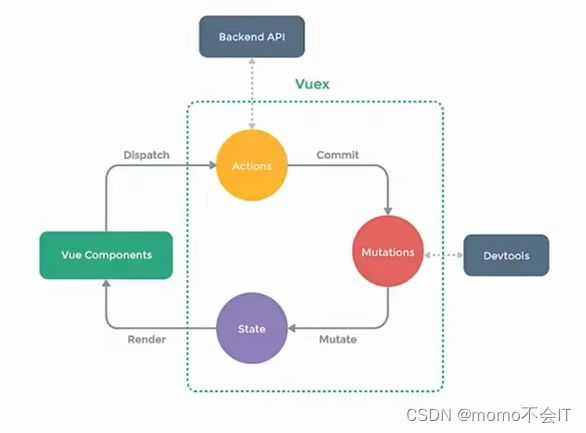
使用Vuex需要在终端中下载


若是使用npm i vuex 指令安装的就是vuex的4版本
vuex的4版本对应的就是Vue3,而我们这里目前为止只是在讲vue2,所以我们需要安装vue2所对应的vuex版本就是vuex3
求和案例_vuex版
components/count.vue
<template>
<div>
<h1>当前求和为:{
{$store.state.sum}}</h1>
<select v-model.number="n">
<option value="1">1</option>
<option value="2">2</option>
<option value="3">3</option>
</select>
<button @click="increment">+</button>
<button @click="decrement">-</button>
<button @click="incrementOdd">当前求和为奇数再相加</button>
<button @click="incrementWait">等一等再加</button>
</div>
</template>
<script>
export default {
name:'count',
data() {
return {
n:1,//用户选择的数字
}
},
methods: {
increment(){
this.$store.commit('JIA',this.n)
},
decrement(){
this.$store.commit('JIAN',this.n)
},
incrementOdd(){
this.$store.dispatch('jiaOdd',this.n)
},
incrementWait(){
this.$store.dispatch('jiaWait',this.n)
}
},
mounted(){
console.log('count',this)
}
}
</script>
<style lang="css">
button{
margin-left: 5px;
}
</style>store/index.js
// 该文件用于创建Vuex中最为核心的store
// 引入vue
import Vue from 'vue'
// 引入Vuex
import Vuex from 'vuex'
// 使用Vuex插件
Vue.use(Vuex)
// 准备actions——用于相应组件中的动作
const actions = {
jia(context,value){
console.log('actions中的jia被调用了')
context.commit('JIA',value)
},
jian(context,value){
console.log('actions中的jian被调用了')
context.commit('JIAN',value)
},
jiaOdd(context,value){
console.log('actions中的jiaOdd被调用了')
if(context.state.sum % 2){
context.commit('JIA',value)
}
},
jiaWait(context,value){
console.log('actions中的jiaWait被调用了')
setTimeout(()=>{
context.commit('JIA',value)
},300)
},
}
// 准备mutations——用于操作数据(state)
const mutations = {
JIA(state,value){
console.log('mutations中的JIA被调用了')
state.sum += value
},
JIAN(state,value){
console.log('mutations中的JIAN被调用了')
state.sum -= value
},
}
// 准备state——用于存储数据
const state = {
sum:0//当前和
}
// 创建并暴露store
export default new Vuex.Store({
actions,
mutations,
state
})App.vue
<template>
<div>
<count/>
</div>
</template>
<script>
import count from './components/count.vue';
export default {
name:'App',
components:{count},
mounted(){
console.log('App',this)
},
}
</script>
main.js
// 引入vue
import Vue from 'vue'
// 引入App
import App from './App.vue'
// 引入插件
import vueResource from 'vue-resource';
// 引入store
import store from './store/index'
// 关闭vue的生产提示
Vue.config.productionTip = false
// 使用插件
Vue.use(vueResource)
// 创建vm
new Vue({
el:'#app',
render: h => h(App),
store,
beforeCreate(){
Vue.prototype.$bus = this //安装全局事件总线
}
})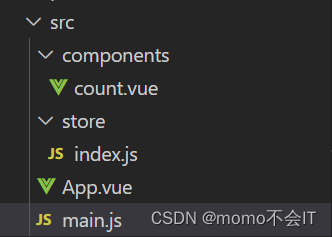
运行成功后在浏览器的控制台中可以看到store属性

Vuex基本使用
1.初始化数据、数据actions、配置mumutations、操作文件store.js
2.组件中读取vuex中的数据:$store.state.sum
3.组件中修改vuex中的数据:$store.dispatch('actions中的方法名',数据)或$store.commit('mutations中的方法名',数据)
备注:若没有网络请求或其他业务逻辑,组件也可以超越actions,即不写dispatch,直接编写commit
getters
components/count.vue
<template>
<div>
<h1>当前求和为:{
{$store.state.sum}}</h1>
<h3>当前求和放大十倍后为:{
{$store.getters.bigSum}}</h3>
<select v-model.number="n">
<option value="1">1</option>
<option value="2">2</option>
<option value="3">3</option>
</select>
<button @click="increment">+</button>
<button @click="decrement">-</button>
<button @click="incrementOdd">当前求和为奇数再相加</button>
<button @click="incrementWait">等一等再加</button>
</div>
</template>
<script>
export default {
name:'count',
data() {
return {
n:1,//用户选择的数字
}
},
methods: {
increment(){
this.$store.commit('JIA',this.n)
},
decrement(){
this.$store.commit('JIAN',this.n)
},
incrementOdd(){
this.$store.dispatch('jiaOdd',this.n)
},
incrementWait(){
this.$store.dispatch('jiaWait',this.n)
}
},
mounted(){
console.log('count',this)
}
}
</script>
<style lang="css">
button{
margin-left: 5px;
}
</style>store/index.js
// 该文件用于创建Vuex中最为核心的store
// 引入vue
import Vue from 'vue'
// 引入Vuex
import Vuex from 'vuex'
// 使用Vuex插件
Vue.use(Vuex)
// 准备actions——用于相应组件中的动作
const actions = {
jia(context,value){
console.log('actions中的jia被调用了')
context.commit('JIA',value)
},
jian(context,value){
console.log('actions中的jian被调用了')
context.commit('JIAN',value)
},
jiaOdd(context,value){
console.log('actions中的jiaOdd被调用了')
if(context.state.sum % 2){
context.commit('JIA',value)
}
},
jiaWait(context,value){
console.log('actions中的jiaWait被调用了')
setTimeout(()=>{
context.commit('JIA',value)
},300)
},
}
// 准备mutations——用于操作数据(state)
const mutations = {
JIA(state,value){
console.log('mutations中的JIA被调用了')
state.sum += value
},
JIAN(state,value){
console.log('mutations中的JIAN被调用了')
state.sum -= value
},
}
// 准备state——用于存储数据
const state = {
sum:0//当前和
}
// 准备getters——用于将state中的数据进行加工
const getters ={
bigSum(state){
return state.sum*10
}
}
// 创建并暴露store
export default new Vuex.Store({
actions,
mutations,
state,
getters
})App.vue
<template>
<div>
<count/>
</div>
</template>
<script>
import count from './components/count.vue';
export default {
name:'App',
components:{count},
mounted(){
console.log('App',this)
},
}
</script>
main.js
// 引入vue
import Vue from 'vue'
// 引入App
import App from './App.vue'
// 引入插件
import vueResource from 'vue-resource';
// 引入store
import store from './store/index'
// 关闭vue的生产提示
Vue.config.productionTip = false
// 使用插件
Vue.use(vueResource)
// 创建vm
new Vue({
el:'#app',
render: h => h(App),
store,
beforeCreate(){
Vue.prototype.$bus = this //安装全局事件总线
}
})getters的使用
1.概念:当state中的数据需要经过加工后再使用,可以使用getters加工
2.在store.js中追加getters配置
3.组件中读取数据:$store.getters.bigSum
mapState与mapGetters
components/count.vue
<template>
<div>
<h1>当前求和为:{
{sum}}</h1>
<h3>当前求和放大十倍后为:{
{bigSum}}</h3>
<h3>我是{
{name}},今年{
{age}}岁了</h3>
<select v-model.number="n">
<option value="1">1</option>
<option value="2">2</option>
<option value="3">3</option>
</select>
<button @click="increment">+</button>
<button @click="decrement">-</button>
<button @click="incrementOdd">当前求和为奇数再相加</button>
<button @click="incrementWait">等一等再加</button>
</div>
</template>
<script>
import {mapState,mapGetters} from 'vuex'
export default {
name:'count',
data() {
return {
n:1,//用户选择的数字
}
},
computed:{
// sum(){
// return this.$store.state.sum
// },
// name(){
// return this.$store.state.name
// },
// age(){
// return this.$store.state.age
// },
// 借助mapState生成计算属性,从state中读取属性。(对象写法)
// ...mapState({sum:'sum',name:'name',age:'age'}),
// 借助mapState生成计算属性,从state中读取属性。(数组写法)
...mapState(['sum','name','age']),
// bigSum(){
// return this.$store.getters.bigSum
// },
// 借助mapGetters生成计算属性,从state中读取属性。(对象写法)
// ...mapGetters({bigSum:'bigSum'}),
// 借助mapGetters生成计算属性,从state中读取属性。(数组写法)
...mapGetters(['bigSum']),
},
methods: {
increment(){
this.$store.commit('JIA',this.n)
},
decrement(){
this.$store.commit('JIAN',this.n)
},
incrementOdd(){
this.$store.dispatch('jiaOdd',this.n)
},
incrementWait(){
this.$store.dispatch('jiaWait',this.n)
}
},
mounted(){
console.log('count',this)
const x = mapState({sum:'sum',name:'name',age:'age'})
console.log(x)
}
}
</script>
<style lang="css">
button{
margin-left: 5px;
}
</style>store/index.js
// 该文件用于创建Vuex中最为核心的store
// 引入vue
import Vue from 'vue'
// 引入Vuex
import Vuex from 'vuex'
// 使用Vuex插件
Vue.use(Vuex)
// 准备actions——用于相应组件中的动作
const actions = {
jia(context,value){
console.log('actions中的jia被调用了')
context.commit('JIA',value)
},
jian(context,value){
console.log('actions中的jian被调用了')
context.commit('JIAN',value)
},
jiaOdd(context,value){
console.log('actions中的jiaOdd被调用了')
if(context.state.sum % 2){
context.commit('JIA',value)
}
},
jiaWait(context,value){
console.log('actions中的jiaWait被调用了')
setTimeout(()=>{
context.commit('JIA',value)
},300)
},
}
// 准备mutations——用于操作数据(state)
const mutations = {
JIA(state,value){
console.log('mutations中的JIA被调用了')
state.sum += value
},
JIAN(state,value){
console.log('mutations中的JIAN被调用了')
state.sum -= value
},
}
// 准备state——用于存储数据
const state = {
sum:0,//当前和
name:"momo",
age:21
}
// 准备getters——用于将state中的数据进行加工
const getters ={
bigSum(state){
return state.sum*10
}
}
// 创建并暴露store
export default new Vuex.Store({
actions,
mutations,
state,
getters
})Appvue
<template>
<div>
<count/>
</div>
</template>
<script>
import count from './components/count.vue';
export default {
name:'App',
components:{count},
mounted(){
console.log('App',this)
},
}
</script>
main.js
// 引入vue
import Vue from 'vue'
// 引入App
import App from './App.vue'
// 引入插件
import vueResource from 'vue-resource';
// 引入store
import store from './store/index'
// 关闭vue的生产提示
Vue.config.productionTip = false
// 使用插件
Vue.use(vueResource)
// 创建vm
new Vue({
el:'#app',
render: h => h(App),
store,
beforeCreate(){
Vue.prototype.$bus = this //安装全局事件总线
}
})mapState方法:用于帮助我们映射state中的数据为计算属性
mapGetters方法:用于帮助我们映射getters中的数据为计算属性
mapActions与mapMutations
components/count.vue
<template>
<div>
<h1>当前求和为:{
{sum}}</h1>
<h3>当前求和放大十倍后为:{
{bigSum}}</h3>
<h3>我是{
{name}},今年{
{age}}岁了</h3>
<select v-model.number="n">
<option value="1">1</option>
<option value="2">2</option>
<option value="3">3</option>
</select>
<button @click="increment(n)">+</button>
<button @click="decrement(n)">-</button>
<button @click="incrementOdd">当前求和为奇数再相加</button>
<button @click="incrementWait">等一等再加</button>
</div>
</template>
<script>
import {mapState,mapGetters,mapMutations,mapActions} from 'vuex'
export default {
name:'count',
data() {
return {
n:1,//用户选择的数字
}
},
computed:{
// 借助mapState生成计算属性,从state中读取属性。(对象写法)
// ...mapState({sum:'sum',name:'name',age:'age'}),
// 借助mapState生成计算属性,从state中读取属性。(数组写法)
...mapState(['sum','name','age']),
// 借助mapGetters生成计算属性,从state中读取属性。(对象写法)
// ...mapGetters({bigSum:'bigSum'}),
// 借助mapGetters生成计算属性,从state中读取属性。(数组写法)
...mapGetters(['bigSum']),
},
methods: {
// increment(){
// this.$store.commit('JIA',this.n)
// },
// decrement(){
// this.$store.commit('JIAN',this.n)
// },
// 借助mapMutations生成对应的方法,方法中会调用commit去联系mutations(对象写法)
// ...mapMutations({increment:'JIA',decrement:'JIAN'}),
// 借助mapMutations生成对应的方法,方法中会调用commit去联系mutations(数组写法)
...mapMutations(['increment','decrement']),
// incrementOdd(){
// this.$store.dispatch('jiaOdd',this.n)
// },
// incrementWait(){
// this.$store.dispatch('jiaWait',this.n)
// }
// 借助mapMutations生成对应的方法,方法中会调用commit去联系mutations(对象写法)
// ...mapActions({incrementOdd:'jiaOdd',incrementWait:'jiaWait'}),
// 借助mapMutations生成对应的方法,方法中会调用commit去联系mutations(数组写法)
...mapActions(['incrementOdd','incrementWait']),
},
mounted(){
console.log('count',this)
const x = mapState({sum:'sum',name:'name',age:'age'})
console.log(x)
}
}
</script>
<style lang="css">
button{
margin-left: 5px;
}
</style>store/index.js
// 该文件用于创建Vuex中最为核心的store
// 引入vue
import Vue from 'vue'
// 引入Vuex
import Vuex from 'vuex'
// 使用Vuex插件
Vue.use(Vuex)
// 准备actions——用于相应组件中的动作
const actions = {
jia(context,value){
console.log('actions中的jia被调用了')
context.commit('JIA',value)
},
jian(context,value){
console.log('actions中的jian被调用了')
context.commit('JIAN',value)
},
jiaOdd(context,value){
console.log('actions中的jiaOdd被调用了')
if(context.state.sum % 2){
context.commit('JIA',value)
}
},
jiaWait(context,value){
console.log('actions中的jiaWait被调用了')
setTimeout(()=>{
context.commit('JIA',value)
},300)
},
}
// 准备mutations——用于操作数据(state)
const mutations = {
JIA(state,value){
console.log('mutations中的JIA被调用了')
state.sum += value
},
JIAN(state,value){
console.log('mutations中的JIAN被调用了')
state.sum -= value
},
}
// 准备state——用于存储数据
const state = {
sum:0,//当前和
name:"momo",
age:21
}
// 准备getters——用于将state中的数据进行加工
const getters ={
bigSum(state){
return state.sum*10
}
}
// 创建并暴露store
export default new Vuex.Store({
actions,
mutations,
state,
getters
})App.vue
<template>
<div>
<count/>
</div>
</template>
<script>
import count from './components/count.vue';
export default {
name:'App',
components:{count},
mounted(){
console.log('App',this)
},
}
</script>
main.js
// 引入vue
import Vue from 'vue'
// 引入App
import App from './App.vue'
// 引入插件
import vueResource from 'vue-resource';
// 引入store
import store from './store/index'
// 关闭vue的生产提示
Vue.config.productionTip = false
// 使用插件
Vue.use(vueResource)
// 创建vm
new Vue({
el:'#app',
render: h => h(App),
store,
beforeCreate(){
Vue.prototype.$bus = this //安装全局事件总线
}
})mapActions方法:用于帮助我们生成与actions对话的方法,即:包含$store.dispatch(xxx)的函数
mapMutations方法:用于帮助我们生成与mutations对话的方法,即:包含$store.commit(xxx)的函数
多组件共享数据
components/count.vue
<template>
<div>
<h1>当前求和为:{
{sum}}</h1>
<h3>当前求和放大十倍后为:{
{bigSum}}</h3>
<h3>我是{
{name}},今年{
{age}}岁了</h3>
<h3>下面组件的人数是:{
{personList.length}}</h3>
<select v-model.number="n">
<option value="1">1</option>
<option value="2">2</option>
<option value="3">3</option>
</select>
<button @click="increment(n)">+</button>
<button @click="decrement(n)">-</button>
<button @click="incrementOdd(n)">当前求和为奇数再相加</button>
<button @click="incrementWait(n)">等一等再加</button>
</div>
</template>
<script>
import {mapState,mapGetters,mapMutations,mapActions} from 'vuex'
export default {
name:'count',
data() {
return {
n:1,//用户选择的数字
}
},
computed:{
// 借助mapState生成计算属性,从state中读取属性。(数组写法)
...mapState(['sum','name','age','personList']),
// 借助mapGetters生成计算属性,从state中读取属性。(数组写法)
...mapGetters(['bigSum']),
},
methods: {
// 借助mapMutations生成对应的方法,方法中会调用commit去联系mutations(对象写法)
...mapMutations({increment:'JIA',decrement:'JIAN'}),
// 借助mapMutations生成对应的方法,方法中会调用commit去联系mutations(对象写法)
...mapActions({incrementOdd:'jiaOdd',incrementWait:'jiaWait'}),
},
mounted(){
// console.log('count',this)
// const x = mapState({sum:'sum',name:'name',age:'age'})
// console.log(x)
}
}
</script>
<style lang="css">
button{
margin-left: 5px;
}
</style>components/person.vue
<template>
<div>
<h1>表</h1>
<h3>count组件的和为:{
{sum}}</h3>
<input type="text" placeholder="请输入名字" v-model="name">
<button @click="add">添加</button>
<ul>
<li v-for="p in personList" :key="p.id">{
{p.name}}</li>
</ul>
</div>
</template>
<script>
import {nanoid} from 'nanoid'
export default {
name :'person',
data(){
return{
name:''
}
},
computed:{
personList(){
return this.$store.state.personList
},
sum(){
return this.$store.state.sum
}
},
methods:{
add(){
const personObj = {id:nanoid(),name:this.name}
this.$store.commit('ADD_PERSON',personObj)
this.name= ''
}
}
}
</script>
<style>
</style>store/index.js
// 该文件用于创建Vuex中最为核心的store
// 引入vue
import Vue from 'vue'
// 引入Vuex
import Vuex from 'vuex'
// 使用Vuex插件
Vue.use(Vuex)
// 准备actions——用于相应组件中的动作
const actions = {
jia(context,value){
console.log('actions中的jia被调用了')
context.commit('JIA',value)
},
jian(context,value){
console.log('actions中的jian被调用了')
context.commit('JIAN',value)
},
jiaOdd(context,value){
console.log('actions中的jiaOdd被调用了')
if(context.state.sum % 2){
context.commit('JIA',value)
}
},
jiaWait(context,value){
console.log('actions中的jiaWait被调用了')
setTimeout(()=>{
context.commit('JIA',value)
},300)
},
}
// 准备mutations——用于操作数据(state)
const mutations = {
JIA(state,value){
console.log('mutations中的JIA被调用了')
state.sum += value
},
JIAN(state,value){
console.log('mutations中的JIAN被调用了')
state.sum -= value
},
ADD_PERSON(state,value){
console.log('mutations中的ADD_PERSON被调用了')
state.personList.unshift(value)
}
}
// 准备state——用于存储数据
const state = {
sum:0,//当前和
name:"momo",
age:21,
personList:[
{id:'001',name:'jojo'}
]
}
// 准备getters——用于将state中的数据进行加工
const getters ={
bigSum(state){
return state.sum*10
}
}
// 创建并暴露store
export default new Vuex.Store({
actions,
mutations,
state,
getters
})App.vue
<template>
<div>
<count/>
<hr/>
<person/>
</div>
</template>
<script>
import count from './components/count.vue';
import person from './components/person.vue';
export default {
name:'App',
components:{count,person},
mounted(){
console.log('App',this)
},
}
</script>
main.js
// 引入vue
import Vue from 'vue'
// 引入App
import App from './App.vue'
// 引入插件
import vueResource from 'vue-resource';
// 引入store
import store from './store/index'
// 关闭vue的生产提示
Vue.config.productionTip = false
// 使用插件
Vue.use(vueResource)
// 创建vm
new Vue({
el:'#app',
render: h => h(App),
store,
beforeCreate(){
Vue.prototype.$bus = this //安装全局事件总线
}
})路由
理解:一个路由(route)就是一组映射关系(key-value),多个路由需要路由器(route)进行管理
前端路由:key是路径,value是组件
路由的基本使用
安装vue-router,命令:npm i vue-router


与安装Vuex时一样,vue-router最新版本为4对应vue3,学习vue2就要安装vue-router3版本

components/About.vue
<template>
<h2>我是About的内容</h2>
</template>
<script>
export default {
name:'About',
}
</script>
<style>
</style>components/Home.vue
<template>
<h2>我是Home的内容</h2>
</template>
<script>
export default {
name:'Home',
}
</script>
<style>
</style>router/index.js
// 该文件专门用于创建整个应用的路由器
import VueRouter from 'vue-router'
// 引入组件
import About from '../components/About'
import Home from '../components/Home'
// 创建并暴露一个路由器
export default new VueRouter({
routes:[
{
path:'/about',
component:About
},
{
path:'/home',
component:Home
}
]
})App.vue
<template>
<div>
<div class="row">
<div class="col-xs-offset-2 col-xs-8">
<div class="page-header"><h2>Vue Router Demo</h2></div>
</div>
</div>
<div class="row">
<div class="col-xs-2 col-xs-offest-2">
<div class="list-group">
<!-- 原始html中我们使用a标签实现页面的跳转 -->
<!-- <a class="list-group-item active" href="./count.vue">About</a>
<a class="list-group-item active" href="./person.vue">Home</a> -->
<!-- Vue中借助router-link标签实现页面的转跳 -->
<router-link class="list-group-item" active-class="active" to="/about">About</router-link>
<router-link class="list-group-item" active-class="active" to="/home">Home</router-link>
</div>
</div>
<div class="col-xs-6">
<div class="panel">
<div class="panel-body">
<!-- 指定组件的呈现位置 -->
<router-view></router-view>
</div>
</div>
</div>
</div>
</div>
</template>
<script>
export default {
name:'App',
}
</script>
main.js
// 引入vue
import Vue from 'vue'
// 引入App
import App from './App.vue'
// 引入Vuerouter
import Vuerouter from 'vue-router'
// 引入路由器
import router from './router/index'
// 关闭vue的生产提示
Vue.config.productionTip = false
// 应用插件
Vue.use(Vuerouter)
// 创建vm
new Vue({
el:'#app',
render: h => h(App),
router:router
})在这个案例中,实现单页面转跳,并且引入了Bootstrap样式
public/index.html
<!DOCTYPE html>
<html lang="">
<head>
<meta charset="utf-8">
<!-- 针对IE浏览器的一个特殊配置,含义是让IE浏览器以最高的渲染级别渲染页面 -->
<meta http-equiv="X-UA-Compatible" content="IE=edge">
<!-- 开启移动端的理想视口 -->
<meta name="viewport" content="width=device-width,initial-scale=1.0">
<!-- 配置页签图标 -->
<link rel="icon" href="<%= BASE_URL %>favicon.ico">
<!-- 引入第三方样式 -->
<link rel="stylesheet" href="bootstrap-3.4.1-dist/css/bootstrap.min.css">
<!-- 配置网页标题 -->
<title><%= htmlWebpackPlugin.options.title %></title>
</head>
<body>
<!-- 当浏览器不支持JavaScript中的元素就会被渲染 -->
<noscript>
<strong>We're sorry but <%= htmlWebpackPlugin.options.title %> doesn't work properly without JavaScript enabled. Please enable it to continue.</strong>
</noscript>
<!-- 容器 -->
<div id="app"></div>
<!-- built files will be auto injected -->
</body>
</html>
路由基本使用为:
1.安装vue-router,命令:npm i vue-router
2.应用插件:Vue.use(VueRouter)
3.编写router配置项
4.实现切换(active-class可配置高亮样式)
5.指定展示位置(<router-view></router-view>)
路由注意点
路由组件通常放在pages文件夹,一般组件通常放在components文件夹
通过切换,“隐藏”了的路由组件,默认是被销毁的,需要的时候再去挂载
每个组件都有自己的$router属性,里面存储着自己的路由信息
整个应用只有一个router,可以通过组件的$router属性获取到
components/Banner.vue
<template>
<div class="col-xs-offset-2 col-xs-8">
<div class="page-header"><h2>Vue Router Demo</h2></div>
</div>
</template>
<script>
export default {
name:'Banner'
}
</script>
<style>
</style>pages/About.vue
<template>
<h2>我是About的内容</h2>
</template>
<script>
export default {
name:'About',
}
</script>
<style>
</style>pages/Home.vue
<template>
<h2>我是Home的内容</h2>
</template>
<script>
export default {
name:'Home',
}
</script>
<style>
</style>router/index.js
// 该文件专门用于创建整个应用的路由器
import VueRouter from 'vue-router'
// 引入组件
import About from '../pages/About'
import Home from '../pages/Home'
// 创建并暴露一个路由器
export default new VueRouter({
routes:[
{
path:'/about',
component:About
},
{
path:'/home',
component:Home
}
]
})App.vue
<template>
<div>
<div class="row">
<Banner/>
</div>
<div class="row">
<div class="col-xs-2 col-xs-offest-2">
<div class="list-group">
<!-- 原始html中我们使用a标签实现页面的跳转 -->
<!-- <a class="list-group-item active" href="./count.vue">About</a>
<a class="list-group-item active" href="./person.vue">Home</a> -->
<!-- Vue中借助router-link标签实现页面的转跳 -->
<router-link class="list-group-item" active-class="active" to="/about">About</router-link>
<router-link class="list-group-item" active-class="active" to="/home">Home</router-link>
</div>
</div>
<div class="col-xs-6">
<div class="panel">
<div class="panel-body">
<!-- 指定组件的呈现位置 -->
<router-view></router-view>
</div>
</div>
</div>
</div>
</div>
</template>
<script>
import Banner from './components/Banner.vue'
export default {
name:'App',
components:{Banner}
}
</script>
main.js
// 引入vue
import Vue from 'vue'
// 引入App
import App from './App.vue'
// 引入Vuerouter
import Vuerouter from 'vue-router'
// 引入路由器
import router from './router/index'
// 关闭vue的生产提示
Vue.config.productionTip = false
// 应用插件
Vue.use(Vuerouter)
// 创建vm
new Vue({
el:'#app',
render: h => h(App),
router:router
})镶嵌路由
components/banner.vue
<template>
<div class="col-xs-offset-2 col-xs-8">
<div class="page-header"><h2>Vue Router Demo</h2></div>
</div>
</template>
<script>
export default {
name:'Banner'
}
</script>
<style>
</style>pages/About.vue
<template>
<h2>我是About的内容</h2>
</template>
<script>
export default {
name:'About',
}
</script>
<style>
</style>pages/Home.vue
<template>
<div>
<h2>我是Home的内容</h2>
<div>
<ul class="nav nav-tabs">
<li>
<router-link class="list-group-item" active-class="active" to="/home/news">News</router-link>
</li>
<li>
<router-link class="list-group-item" active-class="active" to="/home/message">Messages</router-link>
</li>
</ul>
<ul>
<router-view></router-view>
</ul>
</div>
</div>
</template>
<script>
export default {
name:'Home',
}
</script>
<style>
</style>pages/News.vue
<template>
<div>
<ul>
<li>new1</li>
<li>new2</li>
<li>new3</li>
</ul>
</div>
</template>
<script>
export default {
name:'News'
}
</script>pages/Message.vue
<template>
<div>
<ul>
<li>
<a href="">message1</a>
</li>
<li>
<a href="">message2</a>
</li>
<li>
<a href="">message3</a>
</li>
</ul>
</div>
</template>
<script>
export default {
name:'Message'
}
</script>router/index.js
// 该文件专门用于创建整个应用的路由器
import VueRouter from 'vue-router'
// 引入组件
import About from '../pages/About'
import Home from '../pages/Home'
import News from '../pages/News'
import Message from '../pages/Message'
// 创建并暴露一个路由器
export default new VueRouter({
routes:[
{
path:'/about',
component:About
},
{
path:'/home',
component:Home,
children:[
{
path:'news',
component:News,
},
{
path:'message',
component:Message,
},
]
}
]
})App.vue
<template>
<div>
<div class="row">
<Banner/>
</div>
<div class="row">
<div class="col-xs-2 col-xs-offest-2">
<div class="list-group">
<!-- 原始html中我们使用a标签实现页面的跳转 -->
<!-- <a class="list-group-item active" href="./count.vue">About</a>
<a class="list-group-item active" href="./person.vue">Home</a> -->
<!-- Vue中借助router-link标签实现页面的转跳 -->
<router-link class="list-group-item" active-class="active" to="/about">About</router-link>
<router-link class="list-group-item" active-class="active" to="/home">Home</router-link>
</div>
</div>
<div class="col-xs-6">
<div class="panel">
<div class="panel-body">
<!-- 指定组件的呈现位置 -->
<router-view></router-view>
</div>
</div>
</div>
</div>
</div>
</template>
<script>
import Banner from './components/Banner.vue'
export default {
name:'App',
components:{Banner}
}
</script>
main.js
// 引入vue
import Vue from 'vue'
// 引入App
import App from './App.vue'
// 引入Vuerouter
import Vuerouter from 'vue-router'
// 引入路由器
import router from './router/index'
// 关闭vue的生产提示
Vue.config.productionTip = false
// 应用插件
Vue.use(Vuerouter)
// 创建vm
new Vue({
el:'#app',
render: h => h(App),
router:router
})query参数
components/banner.vue
<template>
<div class="col-xs-offset-2 col-xs-8">
<div class="page-header"><h2>Vue Router Demo</h2></div>
</div>
</template>
<script>
export default {
name:'Banner'
}
</script>
<style>
</style>pages/About.vue
<template>
<h2>我是About的内容</h2>
</template>
<script>
export default {
name:'About',
}
</script>
<style>
</style>pages/Home.vue
<template>
<div>
<h2>我是Home的内容</h2>
<div>
<ul class="nav nav-tabs">
<li>
<router-link class="list-group-item" active-class="active" to="/home/news">News</router-link>
</li>
<li>
<router-link class="list-group-item" active-class="active" to="/home/message">Messages</router-link>
</li>
</ul>
<ul>
<router-view></router-view>
</ul>
</div>
</div>
</template>
<script>
export default {
name:'Home',
}
</script>
<style>
</style>pages/Detail.vue
<template>
<ul>
<li>消息编号:{
{$router.query.id}}</li>
<li>消息标题:{
{$router.query.title}}</li>
</ul>
</template>
<script>
export default {
name:'Detail',
mounted(){
console.log(this.$router)
}
}
</script>
<style>
</style>pages/Message.vue
<template>
<div>
<ul>
<li v-for="m in messageList" :key="m.id">
<!-- 转跳路由并携带query参数,to的字符串写法 -->
<!-- <router-link :to="`/home/message/detail?id=${m.id}&title=${m.title}`">{
{m.title}}</router-link> -->
<!-- 转跳路由并携带query参数,to的对象写法 -->
<router-link :to="{
path:'/home/message/detail',
query:{
id:m.id,
title:m.title
}
}">
{
{m.title}}
</router-link>
</li>
</ul>
<hr/>
<router-view></router-view>
</div>
</template>
<script>
export default {
name:'Message',
data(){
return{
messageList:[
{id:'001',title:'消息1'},
{id:'002',title:'消息2'},
{id:'003',title:'消息3'}
]
}
}
}
</script>pages/News.vue
<template>
<div>
<ul>
<li>new1</li>
<li>new2</li>
<li>new3</li>
</ul>
</div>
</template>
<script>
export default {
name:'News'
}
</script>router/index.js
// 该文件专门用于创建整个应用的路由器
import VueRouter from 'vue-router'
// 引入组件
import About from '../pages/About'
import Home from '../pages/Home'
import News from '../pages/News'
import Message from '../pages/Message'
import Detail from '../pages/Detail'
// 创建并暴露一个路由器
export default new VueRouter({
routes:[
{
path:'/about',
component:About
},
{
path:'/home',
component:Home,
children:[
{
path:'news',
component:News,
},
{
path:'message',
component:Message,
children:[
{
path:'detail',
component:Detail,
}
]
},
]
}
]
})App.vue
<template>
<div>
<div class="row">
<Banner/>
</div>
<div class="row">
<div class="col-xs-2 col-xs-offest-2">
<div class="list-group">
<!-- 原始html中我们使用a标签实现页面的跳转 -->
<!-- <a class="list-group-item active" href="./count.vue">About</a>
<a class="list-group-item active" href="./person.vue">Home</a> -->
<!-- Vue中借助router-link标签实现页面的转跳 -->
<router-link class="list-group-item" active-class="active" to="/about">About</router-link>
<router-link class="list-group-item" active-class="active" to="/home">Home</router-link>
</div>
</div>
<div class="col-xs-6">
<div class="panel">
<div class="panel-body">
<!-- 指定组件的呈现位置 -->
<router-view></router-view>
</div>
</div>
</div>
</div>
</div>
</template>
<script>
import Banner from './components/Banner.vue'
export default {
name:'App',
components:{Banner}
}
</script>
main.js
// 引入vue
import Vue from 'vue'
// 引入App
import App from './App.vue'
// 引入Vuerouter
import Vuerouter from 'vue-router'
// 引入路由器
import router from './router/index'
// 关闭vue的生产提示
Vue.config.productionTip = false
// 应用插件
Vue.use(Vuerouter)
// 创建vm
new Vue({
el:'#app',
render: h => h(App),
router:router
})params参数
components/Banner.vue
<template>
<div class="col-xs-offset-2 col-xs-8">
<div class="page-header"><h2>Vue Router Demo</h2></div>
</div>
</template>
<script>
export default {
name:'Banner'
}
</script>
<style>
</style>pages/About.vue
<template>
<h2>我是About的内容</h2>
</template>
<script>
export default {
name:'About',
}
</script>
<style>
</style>pages/Home.vue
<template>
<div>
<h2>我是Home的内容</h2>
<div>
<ul class="nav nav-tabs">
<li>
<router-link class="list-group-item" active-class="active" to="/home/news">News</router-link>
</li>
<li>
<router-link class="list-group-item" active-class="active" to="/home/message">Messages</router-link>
</li>
</ul>
<ul>
<router-view></router-view>
</ul>
</div>
</div>
</template>
<script>
export default {
name:'Home',
}
</script>
<style>
</style>pages/Detail.vue
<template>
<ul>
<li>消息编号:{
{$router.params.id}}</li>
<li>消息标题:{
{$router.params.title}}</li>
</ul>
</template>
<script>
export default {
name:'Detail',
mounted(){
// console.log(this.$router)
}
}
</script>
<style>
</style>pages/Message.vue
<template>
<div>
<ul>
<li v-for="m in messageList" :key="m.id">
<!-- 转跳路由并携带params参数,to的字符串写法 -->
<!-- <router-link :to="`/home/message/detail/${m.id}/${m.title}`">{
{m.title}}</router-link> -->
<!-- 转跳路由并携带params参数,to的对象写法 -->
<router-link :to="{
name:'xiangxi',
params:{
id:m.id,
title:m.title
}
}">
{
{m.title}}
</router-link>
</li>
</ul>
<hr/>
<router-view></router-view>
</div>
</template>
<script>
export default {
name:'Message',
data(){
return{
messageList:[
{id:'001',title:'消息1'},
{id:'002',title:'消息2'},
{id:'003',title:'消息3'}
]
}
}
}
</script>pages/News.vue
<template>
<div>
<ul>
<li>new1</li>
<li>new2</li>
<li>new3</li>
</ul>
</div>
</template>
<script>
export default {
name:'News'
}
</script>router/index.js
// 该文件专门用于创建整个应用的路由器
import VueRouter from 'vue-router'
// 引入组件
import About from '../pages/About'
import Home from '../pages/Home'
import News from '../pages/News'
import Message from '../pages/Message'
import Detail from '../pages/Detail'
// 创建并暴露一个路由器
export default new VueRouter({
routes:[
{
path:'/about',
component:About
},
{
path:'/home',
component:Home,
children:[
{
path:'news',
component:News,
},
{
path:'message',
component:Message,
children:[
{
name:'xiangxi',
path:'detail/:id/:title',
component:Detail,
}
]
},
]
}
]
})// 该文件专门用于创建整个应用的路由器
import VueRouter from 'vue-router'
// 引入组件
import About from '../pages/About'
import Home from '../pages/Home'
import News from '../pages/News'
import Message from '../pages/Message'
import Detail from '../pages/Detail'
// 创建并暴露一个路由器
export default new VueRouter({
routes:[
{
path:'/about',
component:About
},
{
path:'/home',
component:Home,
children:[
{
path:'news',
component:News,
},
{
path:'message',
component:Message,
children:[
{
name:'xiangxi',
path:'detail/:id/:title',
component:Detail,
}
]
},
]
}
]
})App.vue
<template>
<div>
<div class="row">
<Banner/>
</div>
<div class="row">
<div class="col-xs-2 col-xs-offest-2">
<div class="list-group">
<!-- 原始html中我们使用a标签实现页面的跳转 -->
<!-- <a class="list-group-item active" href="./count.vue">About</a>
<a class="list-group-item active" href="./person.vue">Home</a> -->
<!-- Vue中借助router-link标签实现页面的转跳 -->
<router-link class="list-group-item" active-class="active" to="/about">About</router-link>
<router-link class="list-group-item" active-class="active" to="/home">Home</router-link>
</div>
</div>
<div class="col-xs-6">
<div class="panel">
<div class="panel-body">
<!-- 指定组件的呈现位置 -->
<router-view></router-view>
</div>
</div>
</div>
</div>
</div>
</template>
<script>
import Banner from './components/Banner.vue'
export default {
name:'App',
components:{Banner}
}
</script>
main.js
// 引入vue
import Vue from 'vue'
// 引入App
import App from './App.vue'
// 引入Vuerouter
import Vuerouter from 'vue-router'
// 引入路由器
import router from './router/index'
// 关闭vue的生产提示
Vue.config.productionTip = false
// 应用插件
Vue.use(Vuerouter)
// 创建vm
new Vue({
el:'#app',
render: h => h(App),
router:router
})props参数
components/Banner.vue
<template>
<div class="col-xs-offset-2 col-xs-8">
<div class="page-header"><h2>Vue Router Demo</h2></div>
</div>
</template>
<script>
export default {
name:'Banner'
}
</script>
<style>
</style>pages/About.vue
<template>
<h2>我是About的内容</h2>
</template>
<script>
export default {
name:'About',
}
</script>
<style>
</style>pages/Home.vue
<template>
<div>
<h2>我是Home的内容</h2>
<div>
<ul class="nav nav-tabs">
<li>
<router-link class="list-group-item" active-class="active" to="/home/news">News</router-link>
</li>
<li>
<router-link class="list-group-item" active-class="active" to="/home/message">Messages</router-link>
</li>
</ul>
<ul>
<router-view></router-view>
</ul>
</div>
</div>
</template>
<script>
export default {
name:'Home',
}
</script>
<style>
</style>pages/Detail.vue
<template>
<ul>
<li>消息编号:{
{id}}</li>
<li>消息标题:{
{title}}</li>
<li>a:{
{a}}</li>
<li>b:{
{b}}</li>
</ul>
</template>
<script>
export default {
name:'Detail',
// props:['a','b'],//第一种
props:['id','title'],//第三种
computed:{
// id(){
// return this.$route.params.id
// },
// title(){
// return this.$route.params.title
// }
},
mounted(){
// console.log(this.$router)
}
}
</script>
<style>
</style>pages/Message.vue
<template>
<div>
<ul>
<li v-for="m in messageList" :key="m.id">
<!-- 转跳路由并携带params参数,to的字符串写法 -->
<!-- <router-link :to="`/home/message/detail/${m.id}/${m.title}`">{
{m.title}}</router-link> -->
<!-- 转跳路由并携带params参数,to的对象写法 -->
<router-link :to="{
name:'xiangxi',
params:{
id:m.id,
title:m.title
}
}">
{
{m.title}}
</router-link>
</li>
</ul>
<hr/>
<router-view></router-view>
</div>
</template>
<script>
export default {
name:'Message',
data(){
return{
messageList:[
{id:'001',title:'消息1'},
{id:'002',title:'消息2'},
{id:'003',title:'消息3'}
]
}
}
}
</script>pages/News.vue
<template>
<div>
<ul>
<li>new1</li>
<li>new2</li>
<li>new3</li>
</ul>
</div>
</template>
<script>
export default {
name:'News'
}
</script>router/index.js
// 该文件专门用于创建整个应用的路由器
import VueRouter from 'vue-router'
// 引入组件
import About from '../pages/About'
import Home from '../pages/Home'
import News from '../pages/News'
import Message from '../pages/Message'
import Detail from '../pages/Detail'
// 创建并暴露一个路由器
export default new VueRouter({
routes:[
{
path:'/about',
component:About
},
{
path:'/home',
component:Home,
children:[
{
path:'news',
component:News,
},
{
path:'message',
component:Message,
children:[
{
name:'xiangxi',
path:'detail/:id/:title',
component:Detail,
// props的第一种写法,值为对象,该对象中的所有key-value都会以props的形式传给Detail组件
// props:{a:10,b:'hello'}
// props的第二种写法,值为布尔值,若布尔值为真,就会把该路由组件收到的所有params参数,以props形式传给Detail组件
// props:true
// props的第三种写法,值为函数
props($route){
return {id:$route.query.id,title:$route.query.title}
}
}
]
},
]
}
]
})App.vue
<template>
<div>
<div class="row">
<Banner/>
</div>
<div class="row">
<div class="col-xs-2 col-xs-offest-2">
<div class="list-group">
<!-- 原始html中我们使用a标签实现页面的跳转 -->
<!-- <a class="list-group-item active" href="./count.vue">About</a>
<a class="list-group-item active" href="./person.vue">Home</a> -->
<!-- Vue中借助router-link标签实现页面的转跳 -->
<router-link class="list-group-item" active-class="active" to="/about">About</router-link>
<router-link class="list-group-item" active-class="active" to="/home">Home</router-link>
</div>
</div>
<div class="col-xs-6">
<div class="panel">
<div class="panel-body">
<!-- 指定组件的呈现位置 -->
<router-view></router-view>
</div>
</div>
</div>
</div>
</div>
</template>
<script>
import Banner from './components/Banner.vue'
export default {
name:'App',
components:{Banner}
}
</script>
main.js
// 引入vue
import Vue from 'vue'
// 引入App
import App from './App.vue'
// 引入Vuerouter
import Vuerouter from 'vue-router'
// 引入路由器
import router from './router/index'
// 关闭vue的生产提示
Vue.config.productionTip = false
// 应用插件
Vue.use(Vuerouter)
// 创建vm
new Vue({
el:'#app',
render: h => h(App),
router:router
})router-link的replace属性
作用:控制路由转跳时操作浏览器历史记录的模式
浏览器的历史记录有两种写入方式:分别是push和replace,push是追加历史记录,replace是替换当前记录。路由转跳时候默认是push
如何开启replace模式:<router-link replace>News</router-link>
pages/Home.vue
<template>
<div>
<h2>我是Home的内容</h2>
<div>
<ul class="nav nav-tabs">
<li>
<router-link replace class="list-group-item" active-class="active" to="/home/news">News</router-link>
</li>
<li>
<router-link replace class="list-group-item" active-class="active" to="/home/message">Messages</router-link>
</li>
</ul>
<ul>
<router-view></router-view>
</ul>
</div>
</div>
</template>
<script>
export default {
name:'Home',
}
</script>
<style>
</style>编程式路由导航
components/Banner.vue
<template>
<div class="col-xs-offset-2 col-xs-8">
<div class="page-header">
<h2>Vue Router Demo</h2>
<button @click="back">后退</button>
<button @click="forward">前进</button>
</div>
</div>
</template>
<script>
export default {
name:'Banner',
methods:{
back(){
this.$router.back()
},
forward(){
this.$router.forward()
}
}
}
</script>
<style>
</style>pages/About.vue
<template>
<h2>我是About的内容</h2>
</template>
<script>
export default {
name:'About',
}
</script>
<style>
</style>pages/Home.vue
<template>
<div>
<h2>我是Home的内容</h2>
<div>
<ul class="nav nav-tabs">
<li>
<router-link class="list-group-item" active-class="active" to="/home/news">News</router-link>
</li>
<li>
<router-link class="list-group-item" active-class="active" to="/home/message">Messages</router-link>
</li>
</ul>
<ul>
<router-view></router-view>
</ul>
</div>
</div>
</template>
<script>
export default {
name:'Home',
}
</script>
<style>
</style>pages/Detail.vue
<template>
<ul>
<li>消息编号:{
{id}}</li>
<li>消息标题:{
{title}}</li>
<li>a:{
{a}}</li>
<li>b:{
{b}}</li>
</ul>
</template>
<script>
export default {
name:'Detail',
// props:['a','b'],//第一种
props:['id','title'],//第三种
computed:{
// id(){
// return this.$route.params.id
// },
// title(){
// return this.$route.params.title
// }
},
mounted(){
// console.log(this.$router)
}
}
</script>
<style>
</style>pages/Message.vue
<template>
<div>
<ul>
<li v-for="m in messageList" :key="m.id">
<!-- 转跳路由并携带params参数,to的字符串写法 -->
<!-- <router-link :to="`/home/message/detail/${m.id}/${m.title}`">{
{m.title}}</router-link> -->
<!-- 转跳路由并携带params参数,to的对象写法 -->
<router-link :to="{
name:'xiangxi',
params:{
id:m.id,
title:m.title
}
}">
{
{m.title}}
</router-link>
<button @click="pushShow">push查看</button>
<button @click="replaceShow">replace查看</button>
</li>
</ul>
<hr/>
<router-view></router-view>
</div>
</template>
<script>
export default {
name:'Message',
data(){
return{
messageList:[
{id:'001',title:'消息1'},
{id:'002',title:'消息2'},
{id:'003',title:'消息3'}
]
}
},
methods:{
pushShow(m){
// console.log(this.$router)
this.$router.push({
name:'xiangxi',
params:{
id:m.id,
title:m.title
}
})
},
replaceShow(m){
this.$router.replace({
name:'xiangxi',
params:{
id:m.id,
title:m.title
}
})
}
}
}
</script>pages/News.vue
<template>
<div>
<ul>
<li>new1</li>
<li>new2</li>
<li>new3</li>
</ul>
</div>
</template>
<script>
export default {
name:'News'
}
</script>router/index.js
// 该文件专门用于创建整个应用的路由器
import VueRouter from 'vue-router'
// 引入组件
import About from '../pages/About'
import Home from '../pages/Home'
import News from '../pages/News'
import Message from '../pages/Message'
import Detail from '../pages/Detail'
// 创建并暴露一个路由器
export default new VueRouter({
routes:[
{
path:'/about',
component:About
},
{
path:'/home',
component:Home,
children:[
{
path:'news',
component:News,
},
{
path:'message',
component:Message,
children:[
{
name:'xiangxi',
path:'detail/:id/:title',
component:Detail,
// props的第一种写法,值为对象,该对象中的所有key-value都会以props的形式传给Detail组件
// props:{a:10,b:'hello'}
// props的第二种写法,值为布尔值,若布尔值为真,就会把该路由组件收到的所有params参数,以props形式传给Detail组件
// props:true
// props的第三种写法,值为函数
props($route){
return {id:$route.query.id,title:$route.query.title}
}
}
]
},
]
}
]
})App.vue
<template>
<div>
<div class="row">
<Banner/>
</div>
<div class="row">
<div class="col-xs-2 col-xs-offest-2">
<div class="list-group">
<!-- 原始html中我们使用a标签实现页面的跳转 -->
<!-- <a class="list-group-item active" href="./count.vue">About</a>
<a class="list-group-item active" href="./person.vue">Home</a> -->
<!-- Vue中借助router-link标签实现页面的转跳 -->
<router-link class="list-group-item" active-class="active" to="/about">About</router-link>
<router-link class="list-group-item" active-class="active" to="/home">Home</router-link>
</div>
</div>
<div class="col-xs-6">
<div class="panel">
<div class="panel-body">
<!-- 指定组件的呈现位置 -->
<router-view></router-view>
</div>
</div>
</div>
</div>
</div>
</template>
<script>
import Banner from './components/Banner.vue'
export default {
name:'App',
components:{Banner}
}
</script>
main.js
// 引入vue
import Vue from 'vue'
// 引入App
import App from './App.vue'
// 引入Vuerouter
import Vuerouter from 'vue-router'
// 引入路由器
import router from './router/index'
// 关闭vue的生产提示
Vue.config.productionTip = false
// 应用插件
Vue.use(Vuerouter)
// 创建vm
new Vue({
el:'#app',
render: h => h(App),
router:router
})缓存路由组件
components/Banner.vue
<template>
<div class="col-xs-offset-2 col-xs-8">
<div class="page-header">
<h2>Vue Router Demo</h2>
<button @click="back">后退</button>
<button @click="forward">前进</button>
</div>
</div>
</template>
<script>
export default {
name:'Banner',
methods:{
back(){
this.$router.back()
},
forward(){
this.$router.forward()
}
}
}
</script>
<style>
</style>pages/About.vue
<template>
<h2>我是About的内容</h2>
</template>
<script>
export default {
name:'About',
}
</script>
<style>
</style>pages/Home.vue
<template>
<div>
<h2>我是Home的内容</h2>
<div>
<ul class="nav nav-tabs">
<li>
<router-link class="list-group-item" active-class="active" to="/home/news">News</router-link>
</li>
<li>
<router-link class="list-group-item" active-class="active" to="/home/message">Messages</router-link>
</li>
</ul>
<keep-alive include="News">
<router-view></router-view>
</keep-alive>
</div>
</div>
</template>
<script>
export default {
name:'Home',
}
</script>
<style>
</style>pages/Detail.vue
<template>
<ul>
<li>消息编号:{
{id}}</li>
<li>消息标题:{
{title}}</li>
<li>a:{
{a}}</li>
<li>b:{
{b}}</li>
</ul>
</template>
<script>
export default {
name:'Detail',
// props:['a','b'],//第一种
props:['id','title'],//第三种
computed:{
// id(){
// return this.$route.params.id
// },
// title(){
// return this.$route.params.title
// }
},
mounted(){
// console.log(this.$router)
}
}
</script>
<style>
</style>pages/Message.vue
<template>
<div>
<ul>
<li v-for="m in messageList" :key="m.id">
<!-- 转跳路由并携带params参数,to的字符串写法 -->
<!-- <router-link :to="`/home/message/detail/${m.id}/${m.title}`">{
{m.title}}</router-link> -->
<!-- 转跳路由并携带params参数,to的对象写法 -->
<router-link :to="{
name:'xiangxi',
params:{
id:m.id,
title:m.title
}
}">
{
{m.title}}
</router-link>
<button @click="pushShow">push查看</button>
<button @click="replaceShow">replace查看</button>
</li>
</ul>
<hr/>
<router-view></router-view>
</div>
</template>
<script>
export default {
name:'Message',
data(){
return{
messageList:[
{id:'001',title:'消息1'},
{id:'002',title:'消息2'},
{id:'003',title:'消息3'}
]
}
},
methods:{
pushShow(m){
// console.log(this.$router)
this.$router.push({
name:'xiangxi',
params:{
id:m.id,
title:m.title
}
})
},
replaceShow(m){
this.$router.replace({
name:'xiangxi',
params:{
id:m.id,
title:m.title
}
})
}
}
}
</script>pages/News.vue
<template>
<div>
<ul>
<li>new1<input type="text"></li>
<li>new2<input type="text"></li>
<li>new3<input type="text"></li>
</ul>
</div>
</template>
<script>
export default {
name:'News'
}
</script>router/index.js
// 该文件专门用于创建整个应用的路由器
import VueRouter from 'vue-router'
// 引入组件
import About from '../pages/About'
import Home from '../pages/Home'
import News from '../pages/News'
import Message from '../pages/Message'
import Detail from '../pages/Detail'
// 创建并暴露一个路由器
export default new VueRouter({
routes:[
{
path:'/about',
component:About
},
{
path:'/home',
component:Home,
children:[
{
path:'news',
component:News,
},
{
path:'message',
component:Message,
children:[
{
name:'xiangxi',
path:'detail/:id/:title',
component:Detail,
// props的第一种写法,值为对象,该对象中的所有key-value都会以props的形式传给Detail组件
// props:{a:10,b:'hello'}
// props的第二种写法,值为布尔值,若布尔值为真,就会把该路由组件收到的所有params参数,以props形式传给Detail组件
// props:true
// props的第三种写法,值为函数
props($route){
return {id:$route.query.id,title:$route.query.title}
}
}
]
},
]
}
]
})App.vue
<template>
<div>
<div class="row">
<Banner/>
</div>
<div class="row">
<div class="col-xs-2 col-xs-offest-2">
<div class="list-group">
<!-- 原始html中我们使用a标签实现页面的跳转 -->
<!-- <a class="list-group-item active" href="./count.vue">About</a>
<a class="list-group-item active" href="./person.vue">Home</a> -->
<!-- Vue中借助router-link标签实现页面的转跳 -->
<router-link class="list-group-item" active-class="active" to="/about">About</router-link>
<router-link class="list-group-item" active-class="active" to="/home">Home</router-link>
</div>
</div>
<div class="col-xs-6">
<div class="panel">
<div class="panel-body">
<!-- 指定组件的呈现位置 -->
<router-view></router-view>
</div>
</div>
</div>
</div>
</div>
</template>
<script>
import Banner from './components/Banner.vue'
export default {
name:'App',
components:{Banner}
}
</script>
main.js
// 引入vue
import Vue from 'vue'
// 引入App
import App from './App.vue'
// 引入Vuerouter
import Vuerouter from 'vue-router'
// 引入路由器
import router from './router/index'
// 关闭vue的生产提示
Vue.config.productionTip = false
// 应用插件
Vue.use(Vuerouter)
// 创建vm
new Vue({
el:'#app',
render: h => h(App),
router:router
})前置路由守卫
路由守卫的作用对路由进行权限管理
在Vue打开的浏览页面中配置端口的key,value值

components/Banner.vue
<template>
<div class="col-xs-offset-2 col-xs-8">
<div class="page-header">
<h2>Vue Router Demo</h2>
<button @click="back">后退</button>
<button @click="forward">前进</button>
</div>
</div>
</template>
<script>
export default {
name:'Banner',
methods:{
back(){
this.$router.back()
},
forward(){
this.$router.forward()
}
}
}
</script>
<style>
</style>pages/About.vue
<template>
<h2>我是About的内容</h2>
</template>
<script>
export default {
name:'About',
}
</script>
<style>
</style>pages/Home.vue
<template>
<div>
<h2>我是Home的内容</h2>
<div>
<ul class="nav nav-tabs">
<li>
<router-link class="list-group-item" active-class="active" to="/home/news">News</router-link>
</li>
<li>
<router-link class="list-group-item" active-class="active" to="/home/message">Messages</router-link>
</li>
</ul>
<keep-alive include="News">
<router-view></router-view>
</keep-alive>
</div>
</div>
</template>
<script>
export default {
name:'Home',
}
</script>
<style>
</style>pages/Detail.vue
<template>
<ul>
<li>消息编号:{
{id}}</li>
<li>消息标题:{
{title}}</li>
<li>a:{
{a}}</li>
<li>b:{
{b}}</li>
</ul>
</template>
<script>
export default {
name:'Detail',
// props:['a','b'],//第一种
props:['id','title'],//第三种
computed:{
// id(){
// return this.$route.params.id
// },
// title(){
// return this.$route.params.title
// }
},
mounted(){
// console.log(this.$router)
}
}
</script>
<style>
</style>pages/Message.vue
<template>
<div>
<ul>
<li v-for="m in messageList" :key="m.id">
<!-- 转跳路由并携带params参数,to的字符串写法 -->
<!-- <router-link :to="`/home/message/detail/${m.id}/${m.title}`">{
{m.title}}</router-link> -->
<!-- 转跳路由并携带params参数,to的对象写法 -->
<router-link :to="{
name:'xiangxi',
params:{
id:m.id,
title:m.title
}
}">
{
{m.title}}
</router-link>
<button @click="pushShow">push查看</button>
<button @click="replaceShow">replace查看</button>
</li>
</ul>
<hr/>
<router-view></router-view>
</div>
</template>
<script>
export default {
name:'Message',
data(){
return{
messageList:[
{id:'001',title:'消息1'},
{id:'002',title:'消息2'},
{id:'003',title:'消息3'}
]
}
},
methods:{
pushShow(m){
// console.log(this.$router)
this.$router.push({
name:'xiangxi',
params:{
id:m.id,
title:m.title
}
})
},
replaceShow(m){
this.$router.replace({
name:'xiangxi',
params:{
id:m.id,
title:m.title
}
})
}
}
}
</script>pages/News.vue
<template>
<div>
<ul>
<li>new1<input type="text"></li>
<li>new2<input type="text"></li>
<li>new3<input type="text"></li>
</ul>
</div>
</template>
<script>
export default {
name:'News'
}
</script>router/index.js
// 该文件专门用于创建整个应用的路由器
import VueRouter from 'vue-router'
// 引入组件
import About from '../pages/About'
import Home from '../pages/Home'
import News from '../pages/News'
import Message from '../pages/Message'
import Detail from '../pages/Detail'
// 创建并暴露一个路由器
const router = new VueRouter({
routes:[
{
name:'guanyu',
path:'/about',
component:About
},
{
name:'zhuye',
path:'/home',
component:Home,
children:[
{
name:'xinwen',
path:'news',
component:News,
meta:{isAuth:ture}
},
{
name:'xiaoxi',
path:'message',
component:Message,
meta:{isAuth:ture},
children:[
{
name:'xiangxi',
path:'detail/:id/:title',
component:Detail,
// props的第一种写法,值为对象,该对象中的所有key-value都会以props的形式传给Detail组件
// props:{a:10,b:'hello'}
// props的第二种写法,值为布尔值,若布尔值为真,就会把该路由组件收到的所有params参数,以props形式传给Detail组件
// props:true
// props的第三种写法,值为函数
props($route){
return {id:$route.query.id,title:$route.query.title}
}
}
]
},
]
}
]
})
// 全局前置路由守卫——初始化的时候被调用、每次路由切换之前被调用
router.beforeEach((to,from,next)=>{
console.log(to,from)
if(to.meta.isAuth){//判断是否需要鉴权
if(localStorage.getItem('name')==='momo'){
next()
}else{
alert('没有权限查看')
}
}else{
next()
}
})
export default routerApp.vue
<template>
<div>
<div class="row">
<Banner/>
</div>
<div class="row">
<div class="col-xs-2 col-xs-offest-2">
<div class="list-group">
<!-- 原始html中我们使用a标签实现页面的跳转 -->
<!-- <a class="list-group-item active" href="./count.vue">About</a>
<a class="list-group-item active" href="./person.vue">Home</a> -->
<!-- Vue中借助router-link标签实现页面的转跳 -->
<router-link class="list-group-item" active-class="active" to="/about">About</router-link>
<router-link class="list-group-item" active-class="active" to="/home">Home</router-link>
</div>
</div>
<div class="col-xs-6">
<div class="panel">
<div class="panel-body">
<!-- 指定组件的呈现位置 -->
<router-view></router-view>
</div>
</div>
</div>
</div>
</div>
</template>
<script>
import Banner from './components/Banner.vue'
export default {
name:'App',
components:{Banner}
}
</script>
main.js
// 引入vue
import Vue from 'vue'
// 引入App
import App from './App.vue'
// 引入Vuerouter
import Vuerouter from 'vue-router'
// 引入路由器
import router from './router/index'
// 关闭vue的生产提示
Vue.config.productionTip = false
// 应用插件
Vue.use(Vuerouter)
// 创建vm
new Vue({
el:'#app',
render: h => h(App),
router:router
})后置路由
components/Banner.vue
<template>
<div class="col-xs-offset-2 col-xs-8">
<div class="page-header">
<h2>Vue Router Demo</h2>
<button @click="back">后退</button>
<button @click="forward">前进</button>
</div>
</div>
</template>
<script>
export default {
name:'Banner',
methods:{
back(){
this.$router.back()
},
forward(){
this.$router.forward()
}
}
}
</script>
<style>
</style>pages/About.vue
<template>
<h2>我是About的内容</h2>
</template>
<script>
export default {
name:'About',
}
</script>
<style>
</style>pages/Home.vue
<template>
<div>
<h2>我是Home的内容</h2>
<div>
<ul class="nav nav-tabs">
<li>
<router-link class="list-group-item" active-class="active" to="/home/news">News</router-link>
</li>
<li>
<router-link class="list-group-item" active-class="active" to="/home/message">Messages</router-link>
</li>
</ul>
<keep-alive include="News">
<router-view></router-view>
</keep-alive>
</div>
</div>
</template>
<script>
export default {
name:'Home',
}
</script>
<style>
</style>pages/Detail.vue
<template>
<ul>
<li>消息编号:{
{id}}</li>
<li>消息标题:{
{title}}</li>
<li>a:{
{a}}</li>
<li>b:{
{b}}</li>
</ul>
</template>
<script>
export default {
name:'Detail',
// props:['a','b'],//第一种
props:['id','title'],//第三种
computed:{
// id(){
// return this.$route.params.id
// },
// title(){
// return this.$route.params.title
// }
},
mounted(){
// console.log(this.$router)
}
}
</script>
<style>
</style>pages/Message.vue
<template>
<div>
<ul>
<li v-for="m in messageList" :key="m.id">
<!-- 转跳路由并携带params参数,to的字符串写法 -->
<!-- <router-link :to="`/home/message/detail/${m.id}/${m.title}`">{
{m.title}}</router-link> -->
<!-- 转跳路由并携带params参数,to的对象写法 -->
<router-link :to="{
name:'xiangxi',
params:{
id:m.id,
title:m.title
}
}">
{
{m.title}}
</router-link>
<button @click="pushShow">push查看</button>
<button @click="replaceShow">replace查看</button>
</li>
</ul>
<hr/>
<router-view></router-view>
</div>
</template>
<script>
export default {
name:'Message',
data(){
return{
messageList:[
{id:'001',title:'消息1'},
{id:'002',title:'消息2'},
{id:'003',title:'消息3'}
]
}
},
methods:{
pushShow(m){
// console.log(this.$router)
this.$router.push({
name:'xiangxi',
params:{
id:m.id,
title:m.title
}
})
},
replaceShow(m){
this.$router.replace({
name:'xiangxi',
params:{
id:m.id,
title:m.title
}
})
}
}
}
</script>pages/News.vue
<template>
<div>
<ul>
<li>new1<input type="text"></li>
<li>new2<input type="text"></li>
<li>new3<input type="text"></li>
</ul>
</div>
</template>
<script>
export default {
name:'News'
}
</script>router/index.js
// 该文件专门用于创建整个应用的路由器
import VueRouter from 'vue-router'
// 引入组件
import About from '../pages/About'
import Home from '../pages/Home'
import News from '../pages/News'
import Message from '../pages/Message'
import Detail from '../pages/Detail'
// 创建并暴露一个路由器
const router = new VueRouter({
routes:[
{
name:'guanyu',
path:'/about',
component:About,
meta:{title:'关于'}
},
{
name:'zhuye',
path:'/home',
component:Home,
meta:{title:'主页'},
children:[
{
name:'xinwen',
path:'news',
component:News,
meta:{isAuth:ture,title:'新闻'}
},
{
name:'xiaoxi',
path:'message',
component:Message,
meta:{isAuth:ture,title:'消息'},
children:[
{
name:'xiangxi',
path:'detail/:id/:title',
component:Detail,
meta:{title:'详情'},
// props的第一种写法,值为对象,该对象中的所有key-value都会以props的形式传给Detail组件
// props:{a:10,b:'hello'}
// props的第二种写法,值为布尔值,若布尔值为真,就会把该路由组件收到的所有params参数,以props形式传给Detail组件
// props:true
// props的第三种写法,值为函数
props($route){
return {id:$route.query.id,title:$route.query.title}
}
}
]
},
]
}
]
})
// 全局前置路由守卫——初始化的时候被调用、每次路由切换之前被调用
router.beforeEach((to,from,next)=>{
console.log(to,from)
if(to.meta.isAuth){//判断是否需要鉴权
if(localStorage.getItem('name')==='momo'){
next()
}else{
alert('没有权限查看')
}
}else{
next()
}
})
// 全局后置路由守卫——初始化的时候被调用、每次路由切换之前被调用
router.afterEach(()=>{
document.title = to.meta.title || '首页'
})
export default routerApp.vue
<template>
<div>
<div class="row">
<Banner/>
</div>
<div class="row">
<div class="col-xs-2 col-xs-offest-2">
<div class="list-group">
<!-- 原始html中我们使用a标签实现页面的跳转 -->
<!-- <a class="list-group-item active" href="./count.vue">About</a>
<a class="list-group-item active" href="./person.vue">Home</a> -->
<!-- Vue中借助router-link标签实现页面的转跳 -->
<router-link class="list-group-item" active-class="active" to="/about">About</router-link>
<router-link class="list-group-item" active-class="active" to="/home">Home</router-link>
</div>
</div>
<div class="col-xs-6">
<div class="panel">
<div class="panel-body">
<!-- 指定组件的呈现位置 -->
<router-view></router-view>
</div>
</div>
</div>
</div>
</div>
</template>
<script>
import Banner from './components/Banner.vue'
export default {
name:'App',
components:{Banner}
}
</script>
main.js
// 引入vue
import Vue from 'vue'
// 引入App
import App from './App.vue'
// 引入Vuerouter
import Vuerouter from 'vue-router'
// 引入路由器
import router from './router/index'
// 关闭vue的生产提示
Vue.config.productionTip = false
// 应用插件
Vue.use(Vuerouter)
// 创建vm
new Vue({
el:'#app',
render: h => h(App),
router:router
})独享路由守卫
components/Banner.vue
<template>
<div class="col-xs-offset-2 col-xs-8">
<div class="page-header">
<h2>Vue Router Demo</h2>
<button @click="back">后退</button>
<button @click="forward">前进</button>
</div>
</div>
</template>
<script>
export default {
name:'Banner',
methods:{
back(){
this.$router.back()
},
forward(){
this.$router.forward()
}
}
}
</script>
<style>
</style>pages/About.vue
<template>
<h2>我是About的内容</h2>
</template>
<script>
export default {
name:'About',
}
</script>
<style>
</style>pages/Home.vue
<template>
<div>
<h2>我是Home的内容</h2>
<div>
<ul class="nav nav-tabs">
<li>
<router-link class="list-group-item" active-class="active" to="/home/news">News</router-link>
</li>
<li>
<router-link class="list-group-item" active-class="active" to="/home/message">Messages</router-link>
</li>
</ul>
<keep-alive include="News">
<router-view></router-view>
</keep-alive>
</div>
</div>
</template>
<script>
export default {
name:'Home',
}
</script>
<style>
</style>pages/Detail.vue
<template>
<ul>
<li>消息编号:{
{id}}</li>
<li>消息标题:{
{title}}</li>
<li>a:{
{a}}</li>
<li>b:{
{b}}</li>
</ul>
</template>
<script>
export default {
name:'Detail',
// props:['a','b'],//第一种
props:['id','title'],//第三种
computed:{
// id(){
// return this.$route.params.id
// },
// title(){
// return this.$route.params.title
// }
},
mounted(){
// console.log(this.$router)
}
}
</script>
<style>
</style>pages/Message.vue
<template>
<div>
<ul>
<li v-for="m in messageList" :key="m.id">
<!-- 转跳路由并携带params参数,to的字符串写法 -->
<!-- <router-link :to="`/home/message/detail/${m.id}/${m.title}`">{
{m.title}}</router-link> -->
<!-- 转跳路由并携带params参数,to的对象写法 -->
<router-link :to="{
name:'xiangxi',
params:{
id:m.id,
title:m.title
}
}">
{
{m.title}}
</router-link>
<button @click="pushShow">push查看</button>
<button @click="replaceShow">replace查看</button>
</li>
</ul>
<hr/>
<router-view></router-view>
</div>
</template>
<script>
export default {
name:'Message',
data(){
return{
messageList:[
{id:'001',title:'消息1'},
{id:'002',title:'消息2'},
{id:'003',title:'消息3'}
]
}
},
methods:{
pushShow(m){
// console.log(this.$router)
this.$router.push({
name:'xiangxi',
params:{
id:m.id,
title:m.title
}
})
},
replaceShow(m){
this.$router.replace({
name:'xiangxi',
params:{
id:m.id,
title:m.title
}
})
}
}
}
</script>pages/News.vue
<template>
<div>
<ul>
<li>new1<input type="text"></li>
<li>new2<input type="text"></li>
<li>new3<input type="text"></li>
</ul>
</div>
</template>
<script>
export default {
name:'News'
}
</script>router/index.js
// 该文件专门用于创建整个应用的路由器
import VueRouter from 'vue-router'
// 引入组件
import About from '../pages/About'
import Home from '../pages/Home'
import News from '../pages/News'
import Message from '../pages/Message'
import Detail from '../pages/Detail'
// 创建并暴露一个路由器
const router = new VueRouter({
routes:[
{
name:'guanyu',
path:'/about',
component:About,
meta:{title:'关于'}
},
{
name:'zhuye',
path:'/home',
component:Home,
meta:{title:'主页'},
children:[
{
name:'xinwen',
path:'news',
component:News,
meta:{isAuth:ture,title:'新闻'},
beforeEnter:(to,from,next)=>{
console.log(to,from)
if(to.meta.isAuth){//判断是否需要鉴权
if(localStorage.getItem('name')==='momo'){
next()
}else{
alert('没有权限查看')
}
}else{
next()
}
}
},
{
name:'xiaoxi',
path:'message',
component:Message,
meta:{isAuth:ture,title:'消息'},
children:[
{
name:'xiangxi',
path:'detail/:id/:title',
component:Detail,
meta:{title:'详情'},
// props的第一种写法,值为对象,该对象中的所有key-value都会以props的形式传给Detail组件
// props:{a:10,b:'hello'}
// props的第二种写法,值为布尔值,若布尔值为真,就会把该路由组件收到的所有params参数,以props形式传给Detail组件
// props:true
// props的第三种写法,值为函数
props($route){
return {id:$route.query.id,title:$route.query.title}
}
}
]
},
]
}
]
})
// 全局前置路由守卫——初始化的时候被调用、每次路由切换之前被调用
// router.beforeEach((to,from,next)=>{
// console.log(to,from)
// if(to.meta.isAuth){//判断是否需要鉴权
// if(localStorage.getItem('name')==='momo'){
// next()
// }else{
// alert('没有权限查看')
// }
// }else{
// next()
// }
// })
// // 全局后置路由守卫——初始化的时候被调用、每次路由切换之前被调用
// router.afterEach(()=>{
// document.title = to.meta.title || '首页'
// })
export default routerApp.vue
<template>
<div>
<div class="row">
<Banner/>
</div>
<div class="row">
<div class="col-xs-2 col-xs-offest-2">
<div class="list-group">
<!-- 原始html中我们使用a标签实现页面的跳转 -->
<!-- <a class="list-group-item active" href="./count.vue">About</a>
<a class="list-group-item active" href="./person.vue">Home</a> -->
<!-- Vue中借助router-link标签实现页面的转跳 -->
<router-link class="list-group-item" active-class="active" to="/about">About</router-link>
<router-link class="list-group-item" active-class="active" to="/home">Home</router-link>
</div>
</div>
<div class="col-xs-6">
<div class="panel">
<div class="panel-body">
<!-- 指定组件的呈现位置 -->
<router-view></router-view>
</div>
</div>
</div>
</div>
</div>
</template>
<script>
import Banner from './components/Banner.vue'
export default {
name:'App',
components:{Banner}
}
</script>
main.js
// 引入vue
import Vue from 'vue'
// 引入App
import App from './App.vue'
// 引入Vuerouter
import Vuerouter from 'vue-router'
// 引入路由器
import router from './router/index'
// 关闭vue的生产提示
Vue.config.productionTip = false
// 应用插件
Vue.use(Vuerouter)
// 创建vm
new Vue({
el:'#app',
render: h => h(App),
router:router
})组件内路由守卫
components/Banner.vue
<template>
<div class="col-xs-offset-2 col-xs-8">
<div class="page-header">
<h2>Vue Router Demo</h2>
<button @click="back">后退</button>
<button @click="forward">前进</button>
</div>
</div>
</template>
<script>
export default {
name:'Banner',
methods:{
back(){
this.$router.back()
},
forward(){
this.$router.forward()
}
}
}
</script>
<style>
</style>pages/About.vue
<template>
<h2>我是About的内容</h2>
</template>
<script>
export default {
name:'About',
// 通过路由规则,进入该组件时被调用
beforeRouteEnter(to,from,next){
console.log(to,from)
if(to.meta.isAuth){//判断是否需要鉴权
if(localStorage.getItem('name')==='momo'){
next()
}else{
alert('没有权限查看')
}
}else{
next()
}
},
// 通过路由规则,离开该组件时被调用
beforeRouteLeave(to,from){
console.log('后置守卫',to,from)
document.title = to.meta.title || '首页'
}
}
</script>
<style>
</style>pages/Home.vue
<template>
<div>
<h2>我是Home的内容</h2>
<div>
<ul class="nav nav-tabs">
<li>
<router-link class="list-group-item" active-class="active" to="/home/news">News</router-link>
</li>
<li>
<router-link class="list-group-item" active-class="active" to="/home/message">Messages</router-link>
</li>
</ul>
<keep-alive include="News">
<router-view></router-view>
</keep-alive>
</div>
</div>
</template>
<script>
export default {
name:'Home',
}
</script>
<style>
</style>pages/Detail.vue
<template>
<ul>
<li>消息编号:{
{id}}</li>
<li>消息标题:{
{title}}</li>
<li>a:{
{a}}</li>
<li>b:{
{b}}</li>
</ul>
</template>
<script>
export default {
name:'Detail',
// props:['a','b'],//第一种
props:['id','title'],//第三种
computed:{
// id(){
// return this.$route.params.id
// },
// title(){
// return this.$route.params.title
// }
},
mounted(){
// console.log(this.$router)
}
}
</script>
<style>
</style>pages/Message.vue
<template>
<div>
<ul>
<li v-for="m in messageList" :key="m.id">
<!-- 转跳路由并携带params参数,to的字符串写法 -->
<!-- <router-link :to="`/home/message/detail/${m.id}/${m.title}`">{
{m.title}}</router-link> -->
<!-- 转跳路由并携带params参数,to的对象写法 -->
<router-link :to="{
name:'xiangxi',
params:{
id:m.id,
title:m.title
}
}">
{
{m.title}}
</router-link>
<button @click="pushShow">push查看</button>
<button @click="replaceShow">replace查看</button>
</li>
</ul>
<hr/>
<router-view></router-view>
</div>
</template>
<script>
export default {
name:'Message',
data(){
return{
messageList:[
{id:'001',title:'消息1'},
{id:'002',title:'消息2'},
{id:'003',title:'消息3'}
]
}
},
methods:{
pushShow(m){
// console.log(this.$router)
this.$router.push({
name:'xiangxi',
params:{
id:m.id,
title:m.title
}
})
},
replaceShow(m){
this.$router.replace({
name:'xiangxi',
params:{
id:m.id,
title:m.title
}
})
}
}
}
</script>pages/News.vue
<template>
<div>
<ul>
<li>new1<input type="text"></li>
<li>new2<input type="text"></li>
<li>new3<input type="text"></li>
</ul>
</div>
</template>
<script>
export default {
name:'News'
}
</script>router/index.js
// 该文件专门用于创建整个应用的路由器
import VueRouter from 'vue-router'
// 引入组件
import About from '../pages/About'
import Home from '../pages/Home'
import News from '../pages/News'
import Message from '../pages/Message'
import Detail from '../pages/Detail'
// 创建并暴露一个路由器
const router = new VueRouter({
routes:[
{
name:'guanyu',
path:'/about',
component:About,
meta:{isAuth:ture,title:'关于'}
},
{
name:'zhuye',
path:'/home',
component:Home,
meta:{title:'主页'},
children:[
{
name:'xinwen',
path:'news',
component:News,
meta:{isAuth:ture,title:'新闻'},
// beforeEnter:(to,from,next)=>{
// console.log(to,from)
// if(to.meta.isAuth){//判断是否需要鉴权
// if(localStorage.getItem('name')==='momo'){
// next()
// }else{
// alert('没有权限查看')
// }
// }else{
// next()
// }
// }
},
{
name:'xiaoxi',
path:'message',
component:Message,
meta:{isAuth:ture,title:'消息'},
children:[
{
name:'xiangxi',
path:'detail/:id/:title',
component:Detail,
meta:{title:'详情'},
// props的第一种写法,值为对象,该对象中的所有key-value都会以props的形式传给Detail组件
// props:{a:10,b:'hello'}
// props的第二种写法,值为布尔值,若布尔值为真,就会把该路由组件收到的所有params参数,以props形式传给Detail组件
// props:true
// props的第三种写法,值为函数
props($route){
return {id:$route.query.id,title:$route.query.title}
}
}
]
},
]
}
]
})
// 全局前置路由守卫——初始化的时候被调用、每次路由切换之前被调用
// router.beforeEach((to,from,next)=>{
// console.log(to,from)
// if(to.meta.isAuth){//判断是否需要鉴权
// if(localStorage.getItem('name')==='momo'){
// next()
// }else{
// alert('没有权限查看')
// }
// }else{
// next()
// }
// })
// // 全局后置路由守卫——初始化的时候被调用、每次路由切换之前被调用
// router.afterEach(()=>{
// document.title = to.meta.title || '首页'
// })
export default routerApp.vue
<template>
<div>
<div class="row">
<Banner/>
</div>
<div class="row">
<div class="col-xs-2 col-xs-offest-2">
<div class="list-group">
<!-- 原始html中我们使用a标签实现页面的跳转 -->
<!-- <a class="list-group-item active" href="./count.vue">About</a>
<a class="list-group-item active" href="./person.vue">Home</a> -->
<!-- Vue中借助router-link标签实现页面的转跳 -->
<router-link class="list-group-item" active-class="active" to="/about">About</router-link>
<router-link class="list-group-item" active-class="active" to="/home">Home</router-link>
</div>
</div>
<div class="col-xs-6">
<div class="panel">
<div class="panel-body">
<!-- 指定组件的呈现位置 -->
<router-view></router-view>
</div>
</div>
</div>
</div>
</div>
</template>
<script>
import Banner from './components/Banner.vue'
export default {
name:'App',
components:{Banner}
}
</script>
main.js
// 引入vue
import Vue from 'vue'
// 引入App
import App from './App.vue'
// 引入Vuerouter
import Vuerouter from 'vue-router'
// 引入路由器
import router from './router/index'
// 关闭vue的生产提示
Vue.config.productionTip = false
// 应用插件
Vue.use(Vuerouter)
// 创建vm
new Vue({
el:'#app',
render: h => h(App),
router:router
})ElementUI
我们学习VUE,知道它的核心思想式组件和数据驱动,但是每一个组件都需要自己编写模板,样式,添加事件,数据等是非常麻烦的,
所以饿了吗推出了基于VUE2.0的组件库,它的名称叫做element-ui,提供了丰富的PC端组件
ElementUI官网:Element - 网站快速成型工具
npm 安装
推荐使用 npm 的方式安装,它能更好地和 webpack 打包工具配合使用。
npm i element-ui -S

在main.js文件中引入 ElementUI
// 引入vue
import Vue from 'vue'
// 引入App
import App from './App.vue'
// 引入ElementUI组件库
import ElementUI from 'element-ui';
// 引入ElementUI全部样式
import 'element-ui/lib/theme-chalk/index.css';
// 关闭vue的生产提示
Vue.config.productionTip = false
// 应用ElementUI
Vue.use(ElementUI);
// 创建vm
new Vue({
el:'#app',
render: h => h(App),
})App.vue
<template>
<div>
<button>原生按钮</button>
<input type="text">
<el-row>
<el-button>默认按钮</el-button>
<el-button type="primary">主要按钮</el-button>
<el-button type="success">成功按钮</el-button>
<el-button type="info">信息按钮</el-button>
<el-button type="warning">警告按钮</el-button>
<el-button type="danger">危险按钮</el-button>
</el-row>
<el-row>
<el-button plain>朴素按钮</el-button>
<el-button type="primary" plain>主要按钮</el-button>
<el-button type="success" plain>成功按钮</el-button>
<el-button type="info" plain>信息按钮</el-button>
<el-button type="warning" plain>警告按钮</el-button>
<el-button type="danger" plain>危险按钮</el-button>
</el-row>
<el-row>
<el-button round>圆角按钮</el-button>
<el-button type="primary" round>主要按钮</el-button>
<el-button type="success" round>成功按钮</el-button>
<el-button type="info" round>信息按钮</el-button>
<el-button type="warning" round>警告按钮</el-button>
<el-button type="danger" round>危险按钮</el-button>
</el-row>
<el-row>
<el-button icon="el-icon-search" circle></el-button>
<el-button type="primary" icon="el-icon-edit" circle></el-button>
<el-button type="success" icon="el-icon-check" circle></el-button>
<el-button type="info" icon="el-icon-message" circle></el-button>
<el-button type="warning" icon="el-icon-star-off" circle></el-button>
<el-button type="danger" icon="el-icon-delete" circle></el-button>
</el-row>
<el-date-picker
v-model="value2"
align="right"
type="date"
placeholder="选择日期"
:picker-options="pickerOptions">
</el-date-picker>
</div>
</template>
<script>
export default {
name:'App',
}
</script>
参考文献:https://www.bilibili.com/video/BV1Zy4y1K7SH?p=1&vd_source=73447309f7b5ff3ce641d1c5e2f25da3

